Samsung Electronics Co ML1250 Laser Printer User Manual Part2
Samsung Electronics Co Ltd Laser Printer Users Manual Part2
Contents
- 1. Users Manual Part1
- 2. Users Manual Part2
Users Manual Part2
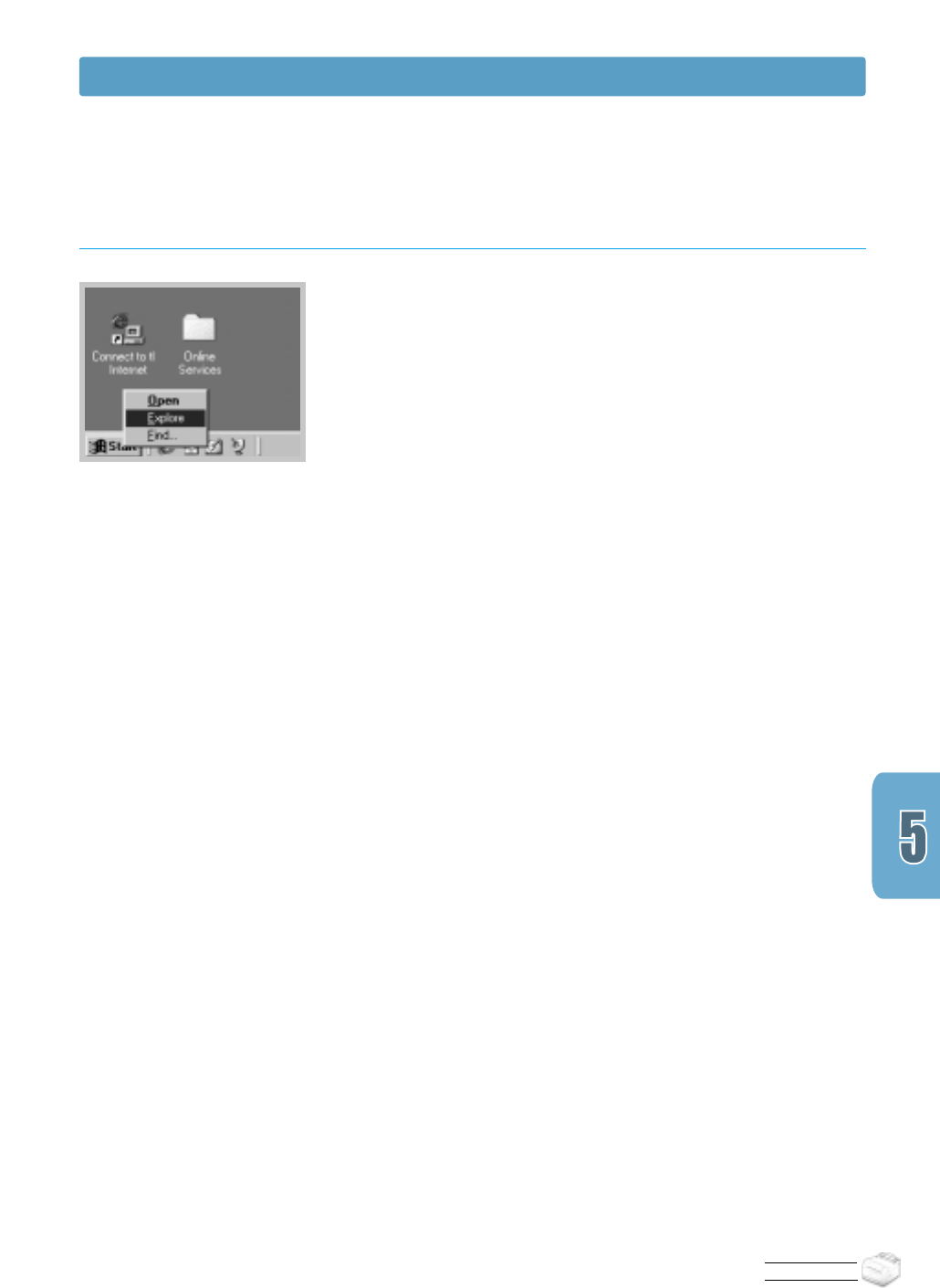
PRINTING TASKS
1
Right-click Start, and select Explorer.
2
Open your network folder in the left column.
3
Right-click the shared name, and select Capture Printer
Port.
4
Select the port you want, check the Reconnect at log
on box, then click OK.
5
From the Start menu, select Settings, then Printers.
6
Double-click your printer icon.
7
From the Printers menu, select Properties.
8
Press the Details tab, select the printer port, then click
OK.
Setting Up Client PC
Printing on a Network Environment
5.23
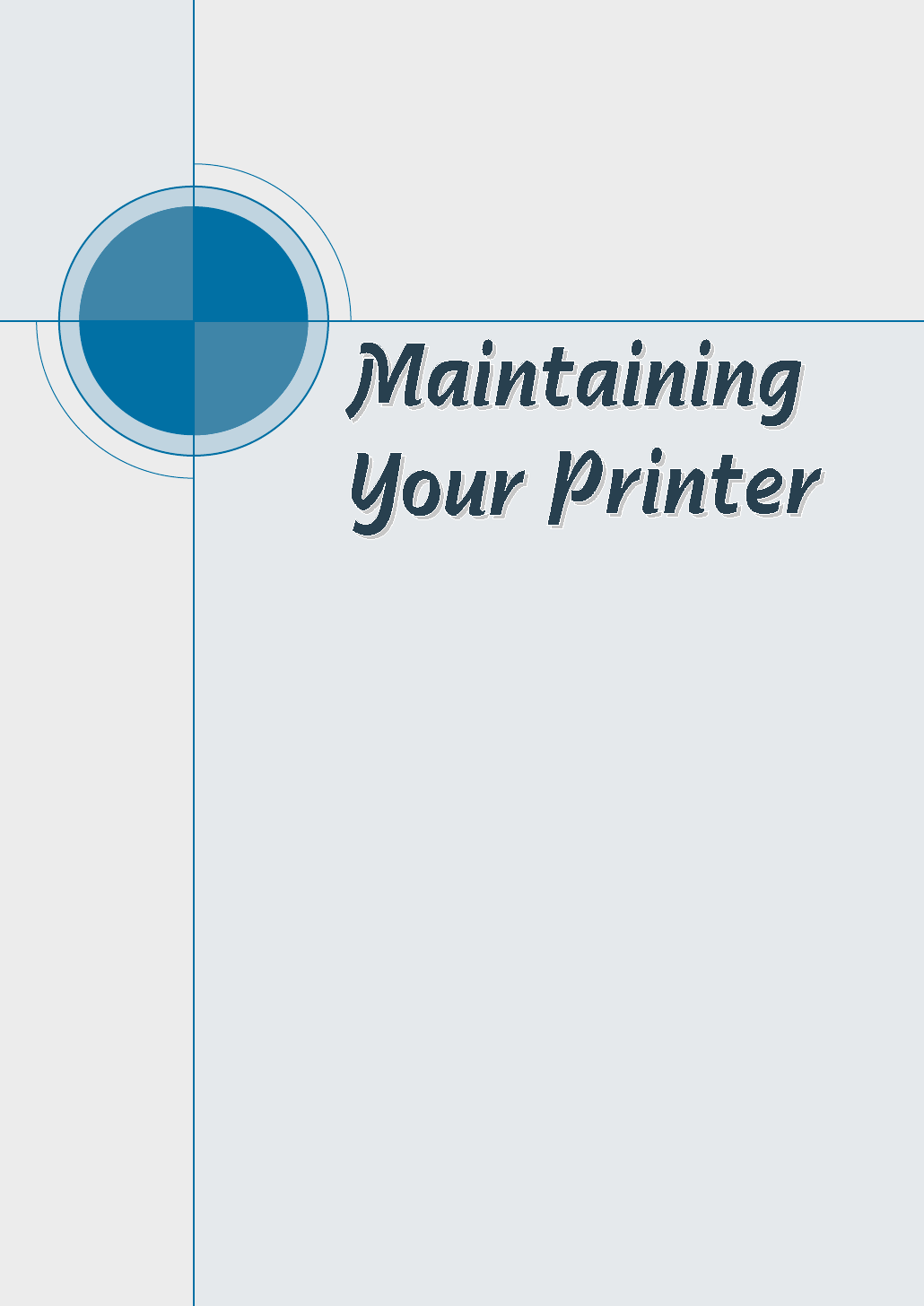
chapter
This chapter provides suggestions for high-quality and
economical printing and information for maintaining the toner
cartridge and the printer.
Topics included in this chapter are:
◆Maintaining Toner Cartridge
◆Cleaning the Printer
6
6

MAINTAINING YOUR PRINTER
6.1
Maintaining Toner Cartridge
To get the most from the toner cartridge, keep the following
guidelines in your mind.
• Do not remove the toner cartridge from its package until you
are ready to use it.
• Do not refill toner cartridges. The printer warranty does not
cover damage caused by using a refilled cartridge.
• Store toner cartridges in the same environment as the printer.
• Do not remove a toner cartridge from the printer except to
replace it, clean it or clear a paper jam. Replace the cartridge
immediately.
• To prevent damage to the toner cartridge, do not expose it to
light for more than a few minutes.
Toner cartridge storage
The life of the toner cartridge depends on the amount of toner
that print jobs require. When printing text at 5 % coverage, a
new toner cartridge lasts an average of 2,500 pages. (But, the
toner cartridge supplied with the printer lasts an average of
1,000 pages.)
Toner cartridge life
expectancy
After you install a new toner cartridge (see page 2.2), follow the
instructions included in the toner cartridge box to recycle the old
cartridge.
Recycling toner
cartridge
To save toner, press the Toner Save button on the printer
control panel. The button will be lit. You can also enable the
Toner Save Mode in your printer properties. Refer to “Using
Toner Save Mode” on page 5.6. Selecting this option will extend
the life of the toner cartridge and reduce your cost per page, but
will reduce print quality.
Saving toner
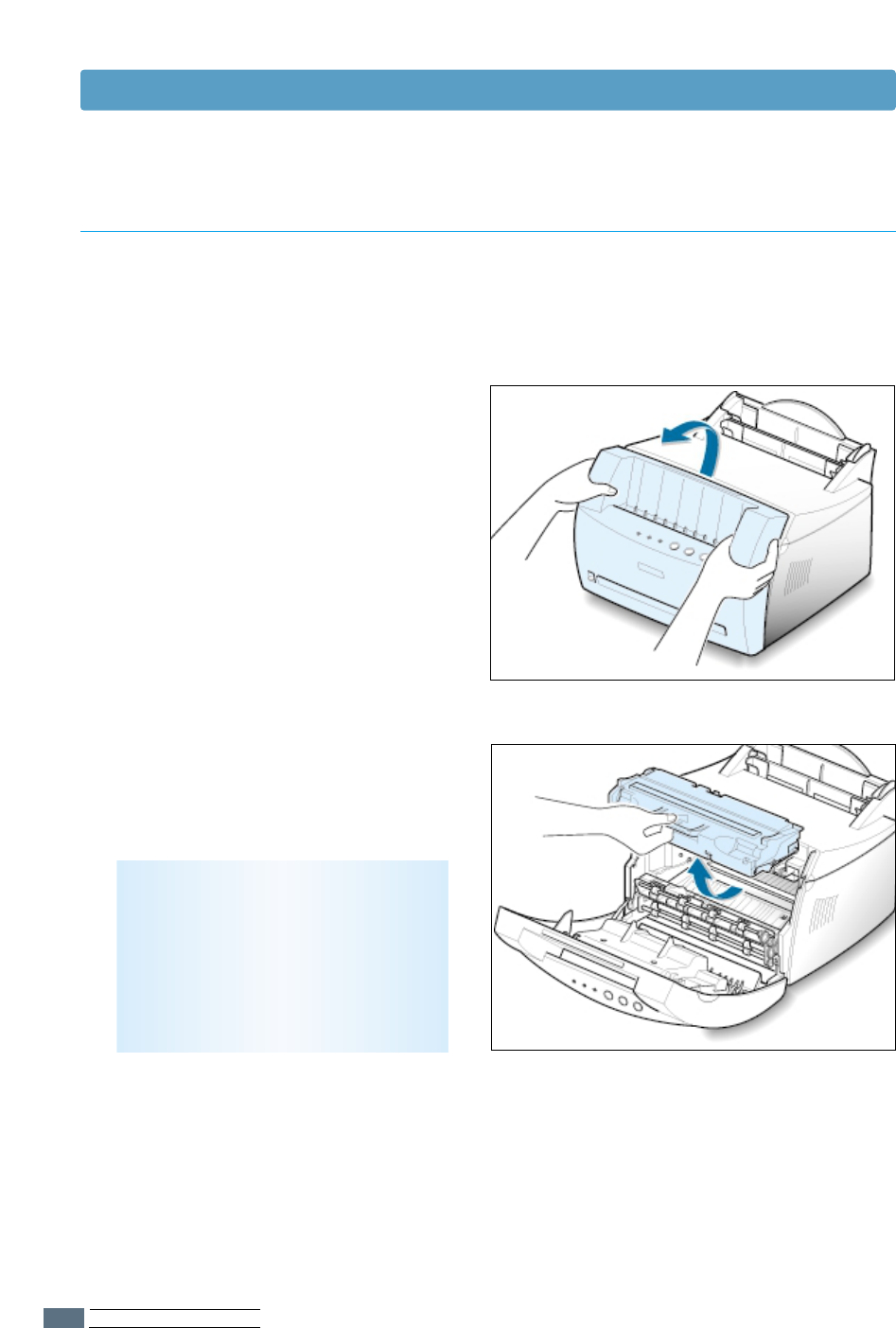
MAINTAINING YOUR PRINTER
6.2
Maintaining Toner Cartridge
When toner is low, faded or light areas may appear on a printed page. You may be able to
temporarily improve print quality by redistributing the toner. The following procedures may
allow you to finish the current print job before replacing the toner cartridge.
Redistributing Toner
1
Grasp the front cover by both sides of
the cover and pull it toward you to
open.
2
Remove the toner cartridge from the
printer.
CAUTIONS:
• Avoid reaching too far into the
printer. The fusing area may be hot.
• To prevent damage to the toner
cartridge, do not expose it to light
for more than a few minutes.
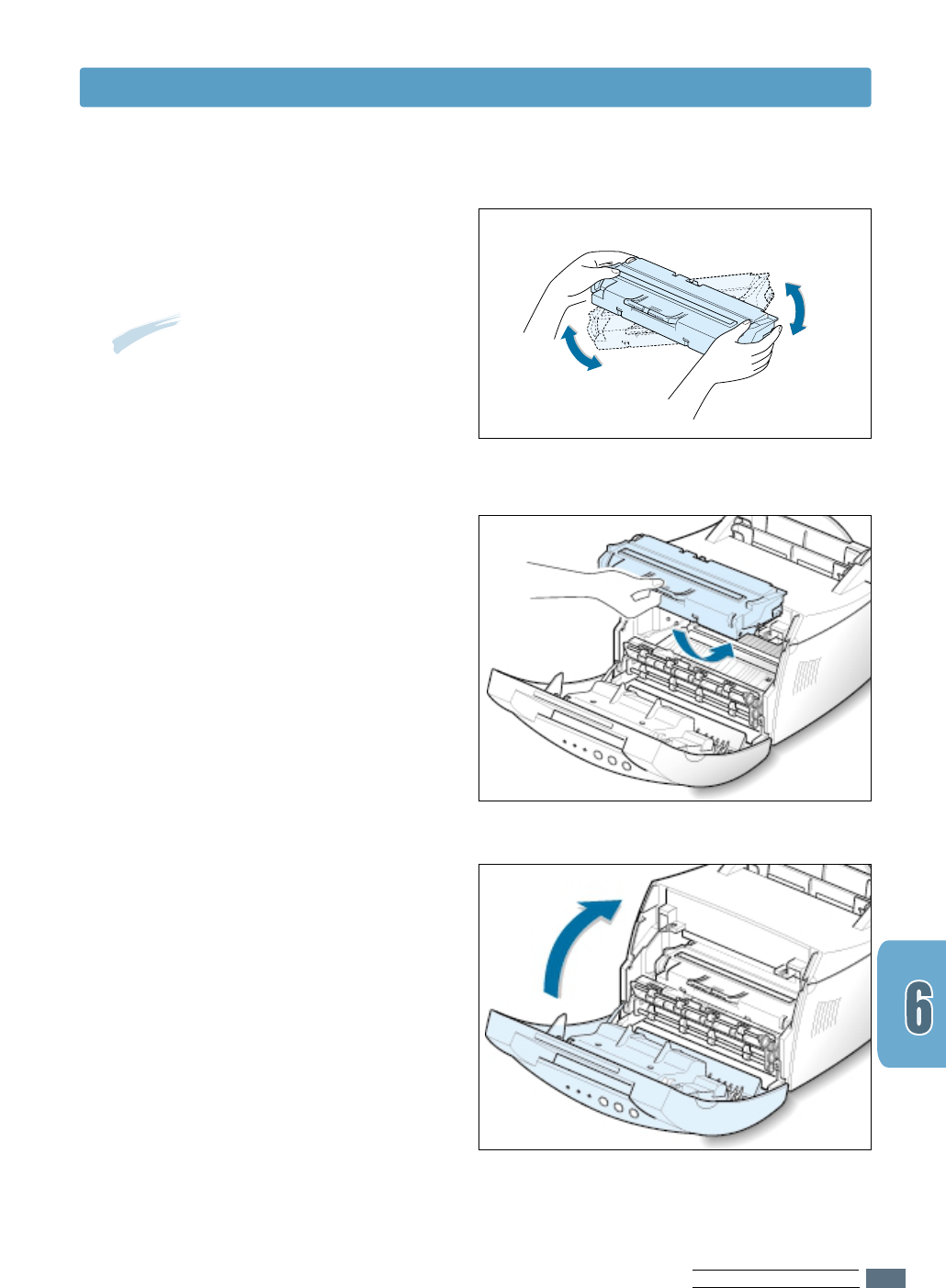
MAINTAINING YOUR PRINTER
6.3
Maintaining Toner Cartridge
3
Gently shake the toner cartridge from
side to side 5 or 6 times to redistribute
the toner.
4
Reinsert the toner cartridge into the
printer. Be sure that the toner cartridge
snaps in its place.
5
Firmly
close the cover.
If the print remains light
Remove the old cartridge and install a
new toner cartridge. See “Install the
Toner Cartridge” on page 2.2.
Note: If the toner gets on your
clothing, wipe it off with a dry cloth
and wash clothing in cold water. Hot
water sets toner into fabric.
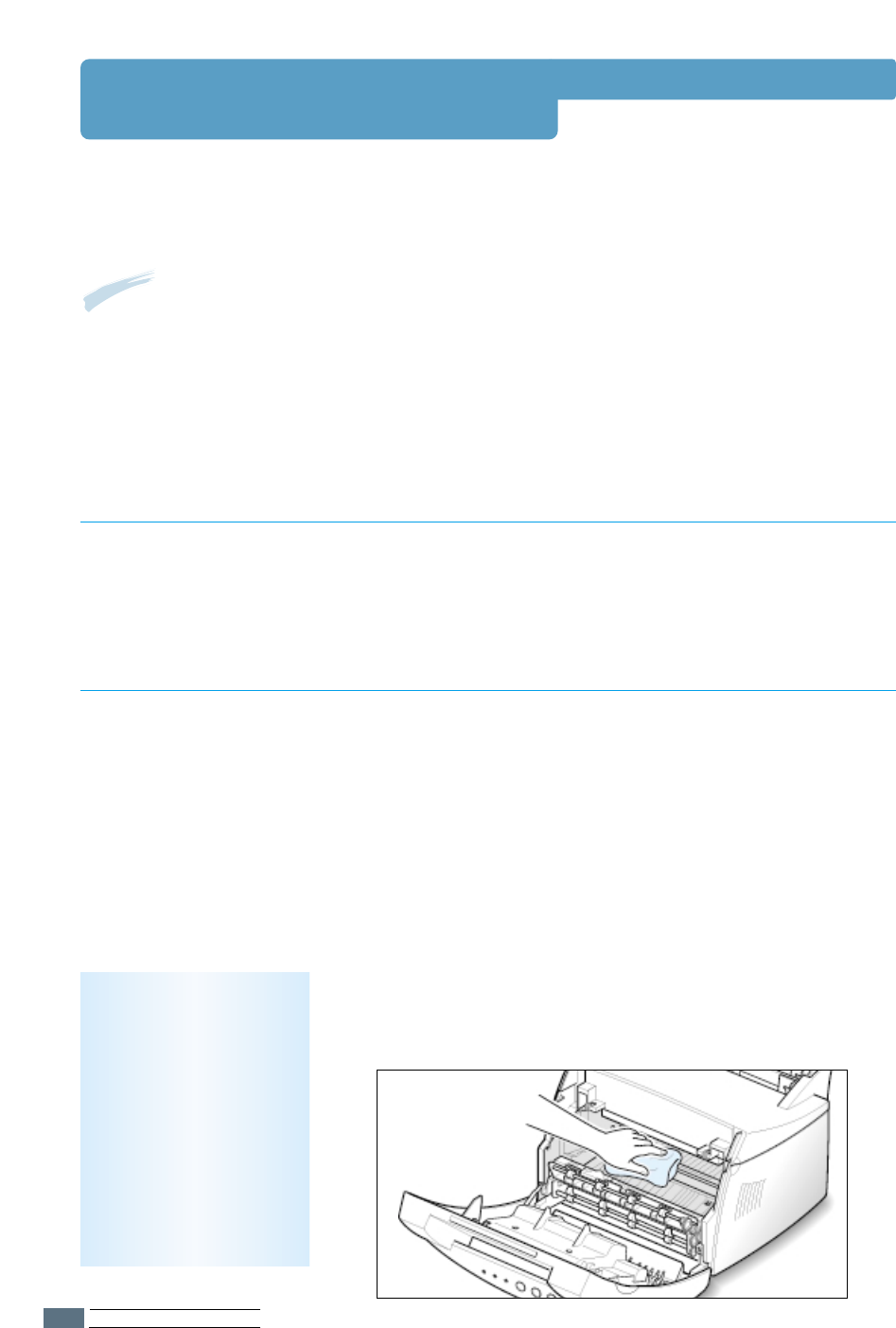
MAINTAINING YOUR PRINTER
6.4
Cleaning the Printer
To maintain print quality, follow the cleaning procedures below every time the toner cartridge
is replaced or whenever print quality problems occur. As much as possible, keep the printer
free from dust and debris.
Notes:
• Do not use ammonia-based cleaners or volatile solvents such as thinner, on or around the
printer. These can damage the printer.
• While cleaning the inside of the printer, be careful not to touch the transfer roller (located
underneath the toner cartridge ). The oil from your hands on the roller can cause print quality
problems.
Wipe the outside surface of the printer with a soft, clean, lint-
free cloth. You can dampen the cloth slightly with water, but be
careful not to let any water drip onto the printer or inside it.
Cleaning the Outside
During the printing process, paper, toner, and dust particles
can accumulate inside the printer. Over time, this buildup can
cause print quality problems such as toner specks or smearing.
Cleaning inside the printer will eliminate or reduce these
problems.
Cleaning the Inside
1
Turn the printer off and unplug the power cord, then wait for
the printer to cool.
2
Open the front cover and remove the toner cartridge.
3
With a dry, lint-free cloth, wipe away any dust and spilled toner
from the toner cartridge area and the toner cartridge cavity.
Cleaning inside the printer
Note: To prevent
damage to the toner
cartridge, do not expose
it to light for more than a
few minutes. Cover it
with a piece of paper, if
necessary. Also, do not
touch the black transfer
roller inside the printer.
By doing so, you can
damage the printer.
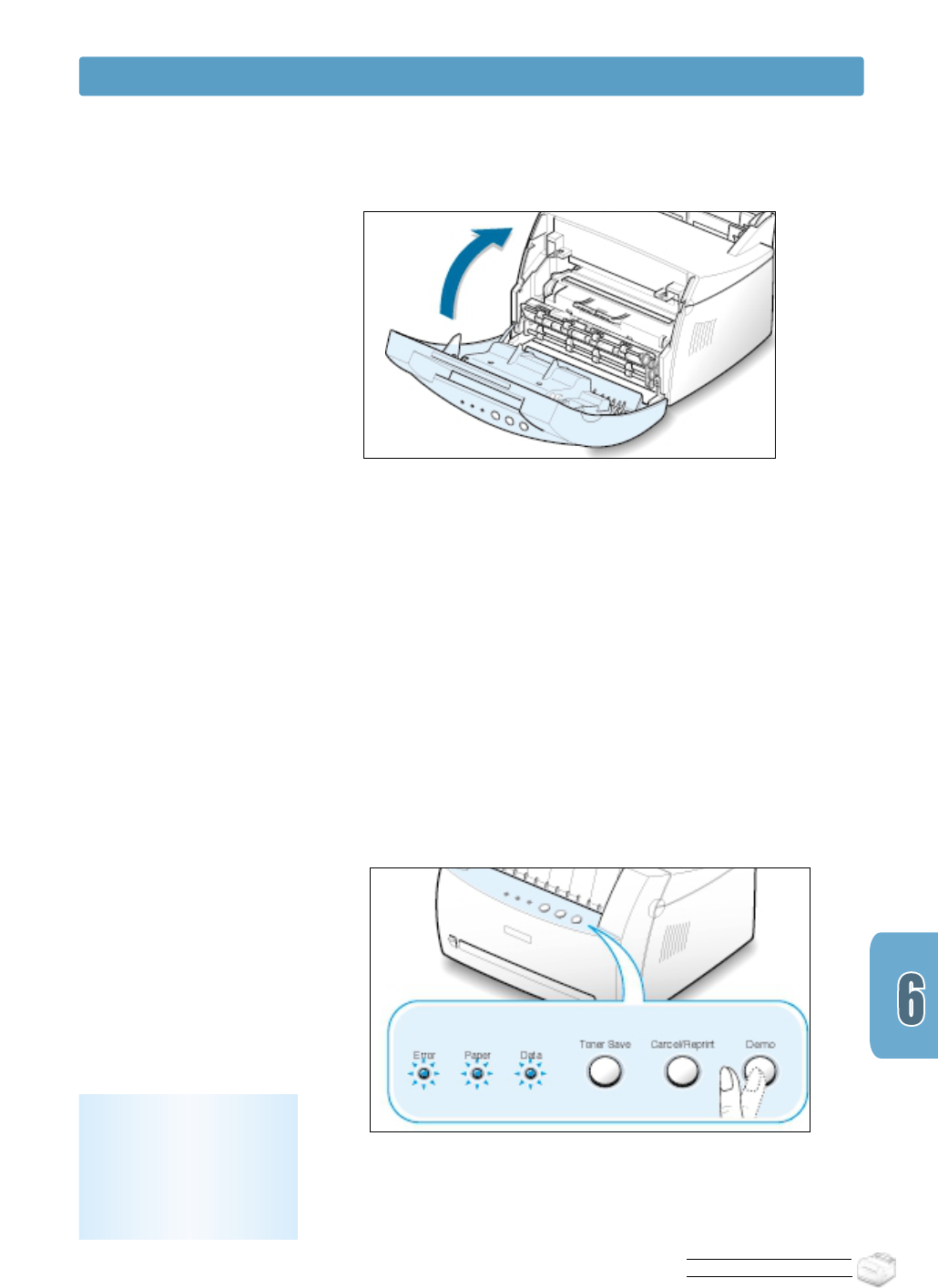
3
Your printer automatically picks up a sheet of paper from the
tray and prints out a cleaning sheet with the dust or toner
particles on it.
MAINTAINING YOUR PRINTER
5
Then, plug in the power cord, and turn the printer on.
Note: The cartridge
cleaning process takes
some time. To stop the
printing, turn the power
off.
Cleaning the Printer
Printing a cleaning sheet
Printing a cleaning sheet cleans the drum inside the toner
cartridge. Use this process if you are experiencing blurred,
faded or smeared printouts. This process will produce a page
with toner debris, which should be discarded.
1
Make sure the printer is turned on and in the Ready mode and
that there is paper loaded in the automatic input tray.
2
Press and hold down Demo on the control panel for about 10
seconds until all control panel lights remain lit, then release
the button.
4
Reinsert the toner cartridge and close the cover.
6.5
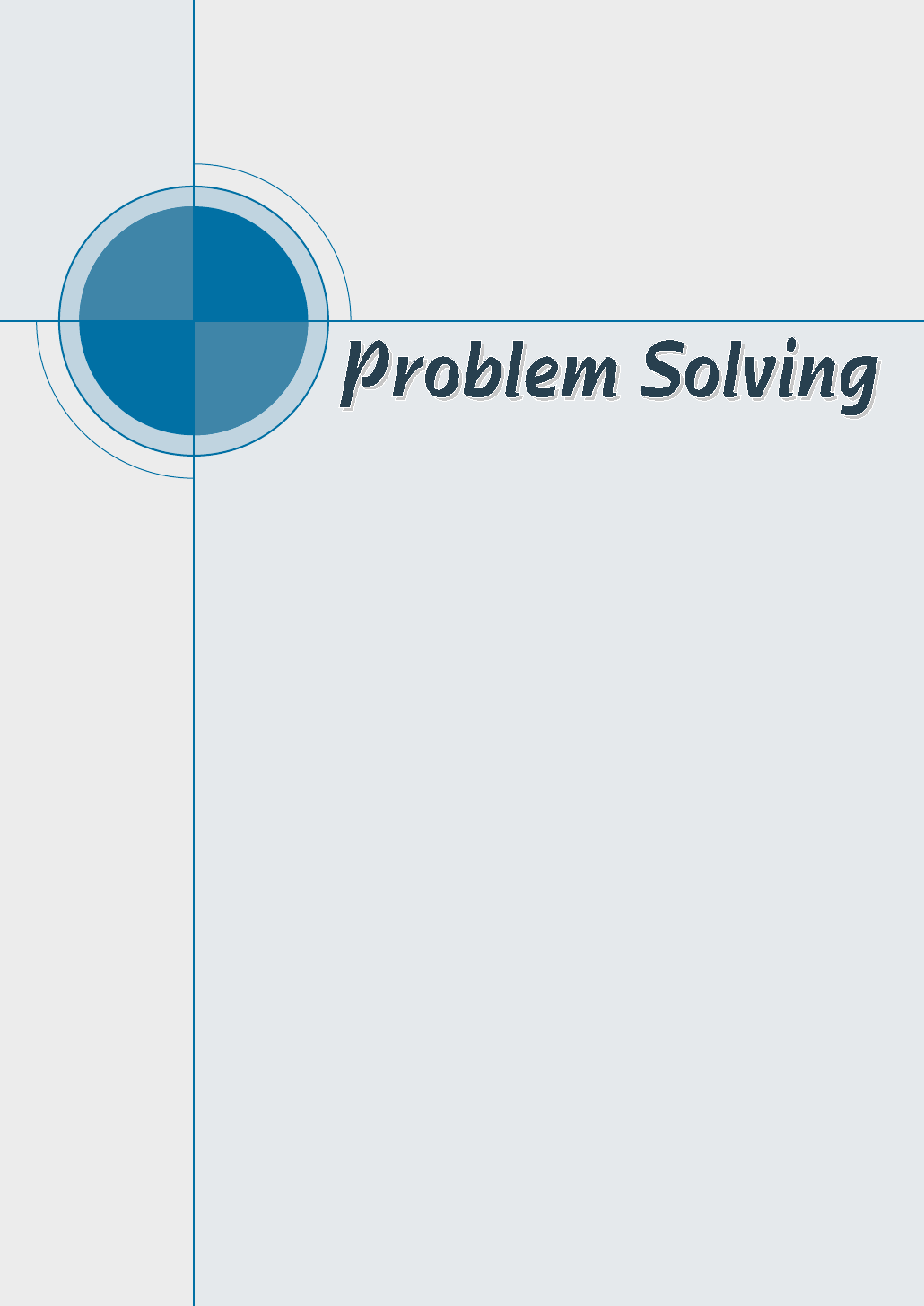
chapter
This chapter gives helpful information for what to do if you
encounter a printer error. It provides information on the
following topics:
◆ Troubleshooting Checklist
◆ Solving General Printing Problems
◆ Clearing Paper Jams
◆ Solving Print Quality Problems
◆ Troubleshooting Error Messages
◆ Common Windows Problems
7
7
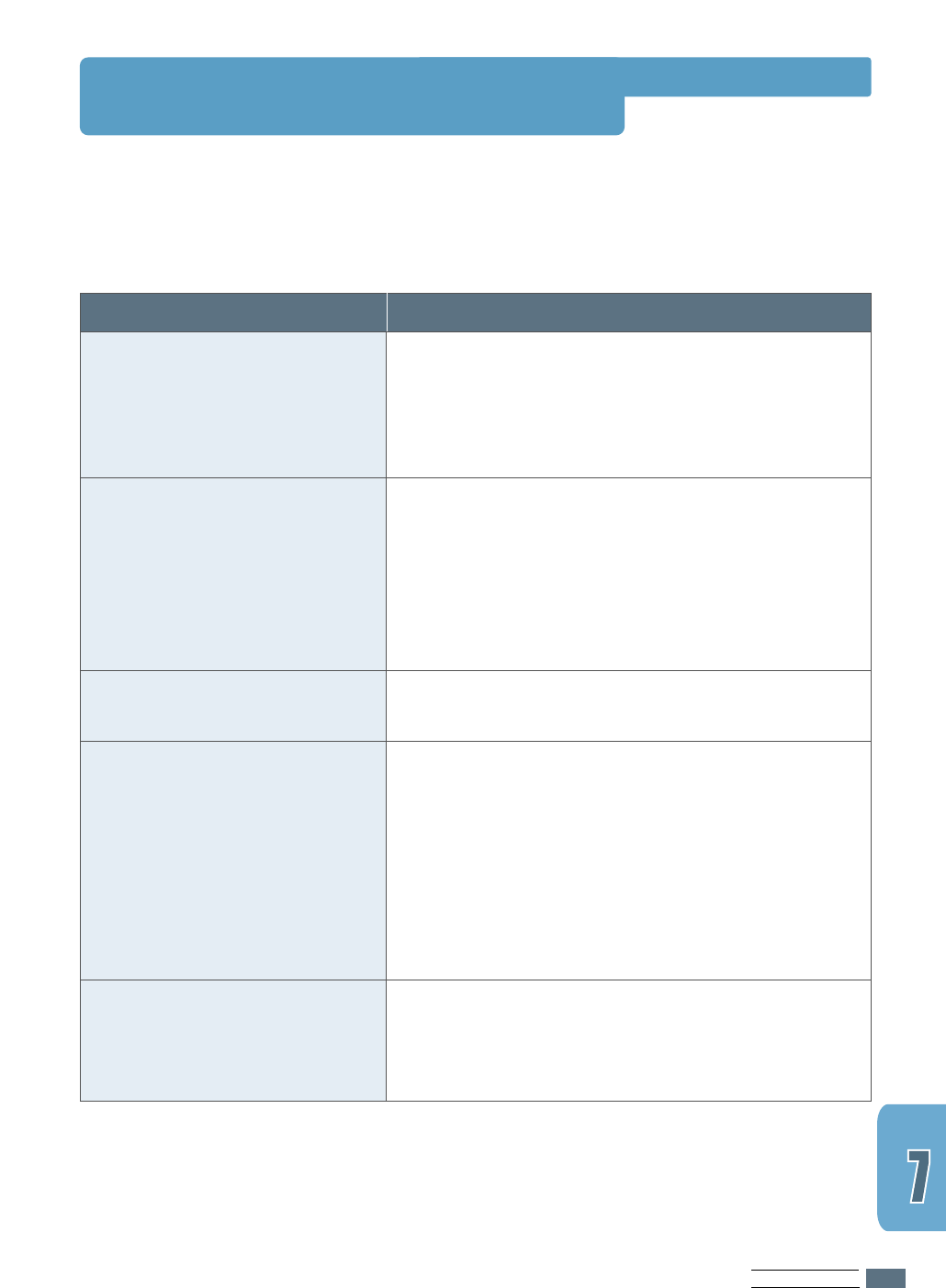
PROBLEM SOLVING
7.1
Troubleshooting Checklist
If the printer is not working properly, complete the following checklist in order. If the printer
does not pass a step, follow the corresponding troubleshooting suggestions.
Check
Make sure that the Data light on
the control panel is on.
Press the Demo button to print
a demo page to verify that the
printer is feeding paper correctly.
See page 2.7.
Check the demo page to see if it
is printed correctly.
Print a short document from a
software application to verify the
computer and printer are
connected and are
communicating correctly.
If completing the checklist did
not diagnose the problem with
the printer, check the following
troubleshooting sections.
Solution
• If no lights are on, check the power cord connection
and the power switch. Check the power source by
plugging into another outlet.
• If other lights are on, go to “Troubleshooting Error
Messages” on page 7.17.
• If a demo page does not print, check the paper
supply in the input tray.
• If the paper jams in the printer, go to “ Clearing
Paper Jams” on page 7.6.
• If the Error indicator light is illuminated on the
control panel, go to “Troubleshooting Error
Messages” on page 7.17.
If there is a print quality problem, go to “Solving
Print Quality Problems” on page 7.11.
• If the page does not print, check the cable
connection between the printer and computer.
• Check the print queue or print spooler to see if the
printer has been paused.
• Check the software application to make sure you
are using the proper printer driver and
communication port. If the page is interrupted
during printing, go to “Solving General Printing
Problems” on page 7.2.
• “Solving General Printing Problems” on page 7.2.
• “Troubleshooting Error Messages” on page 7.17.
• “Common Windows Problems” on page 7.20.
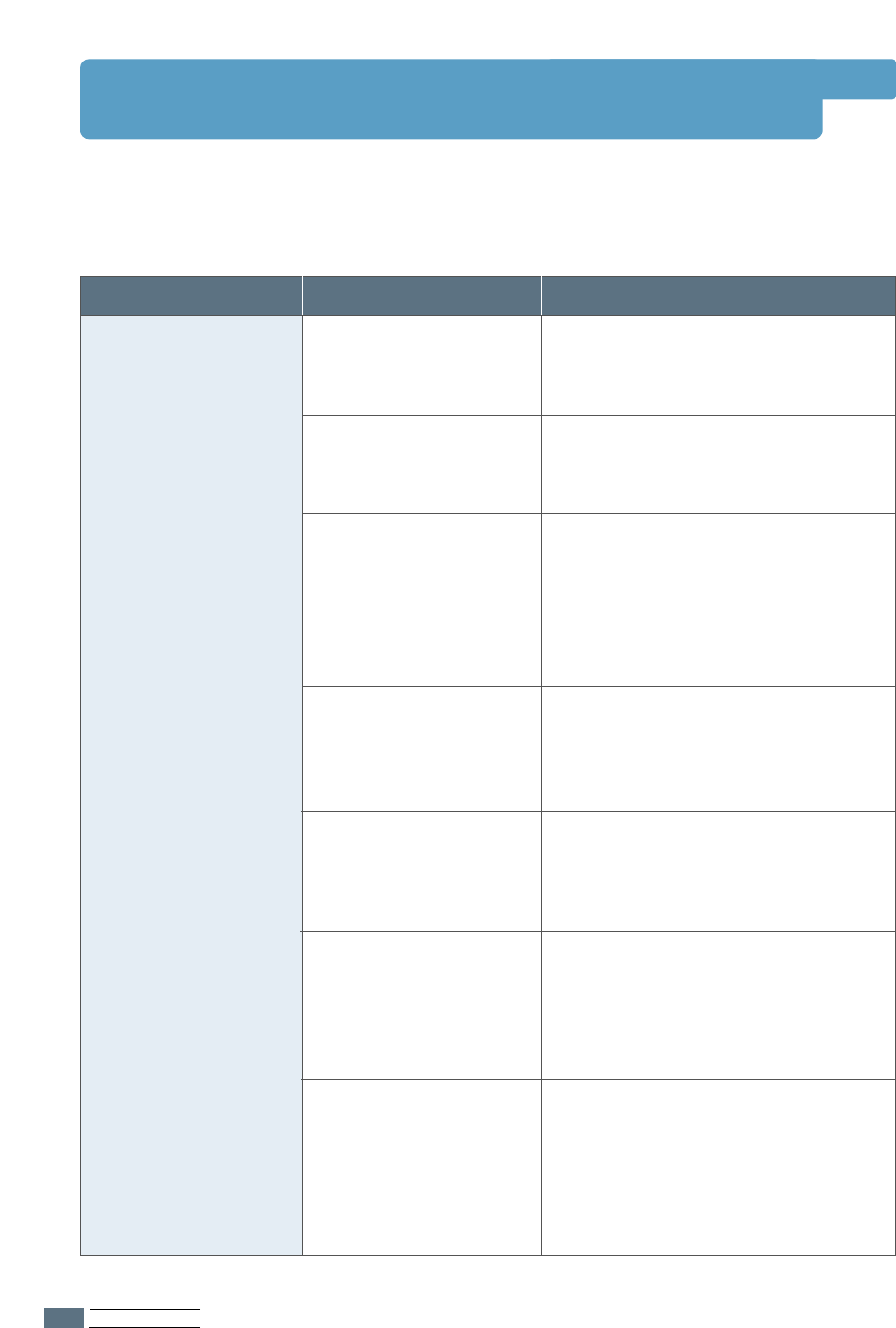
PROBLEM SOLVING
7.2
Solving General Printing Problems
Problem
The printer does not
print.
Possible Cause
The printer is not
receiving power.
Your printer is not
selected as the default
printer.
Check the printer for
the following:
The printer may be in
manual feed mode and
out of paper. (The
Paper light is on.)
The connection cable
between the computer
and the printer is not
connected properly.
The connection cable
between the computer
and the printer is
defective.
The port setting is
incorrect.
Solution
If no lights are on, check the power
cord connections. Check the power
switch and the power source.
Select Samsung ML-1250 PCL 6 as
your default printer.
• The printer cover is not closed.
• Paper is jammed.
• No paper is loaded.
• Toner cartridge is not installed.
• Printer system error occurs.
Contact a service representative.
Add paper to the manual input tray,
and press the Demo button on the
printer’s control panel to start
printing.
Disconnect the printer cable and
reconnect it.
If possible, attach the cable to
another computer that is working
properly and print a job. You may
also try using a different printer
cable.
Check the Windows printer setting to
make sure that the print job is sent
to the correct port (for example,
LPT1). If the computer has more
than one port, make sure the printer
is attached to the correct one.
If you have any problems with the operation of your printer, refer to the table for suggested
solutions.
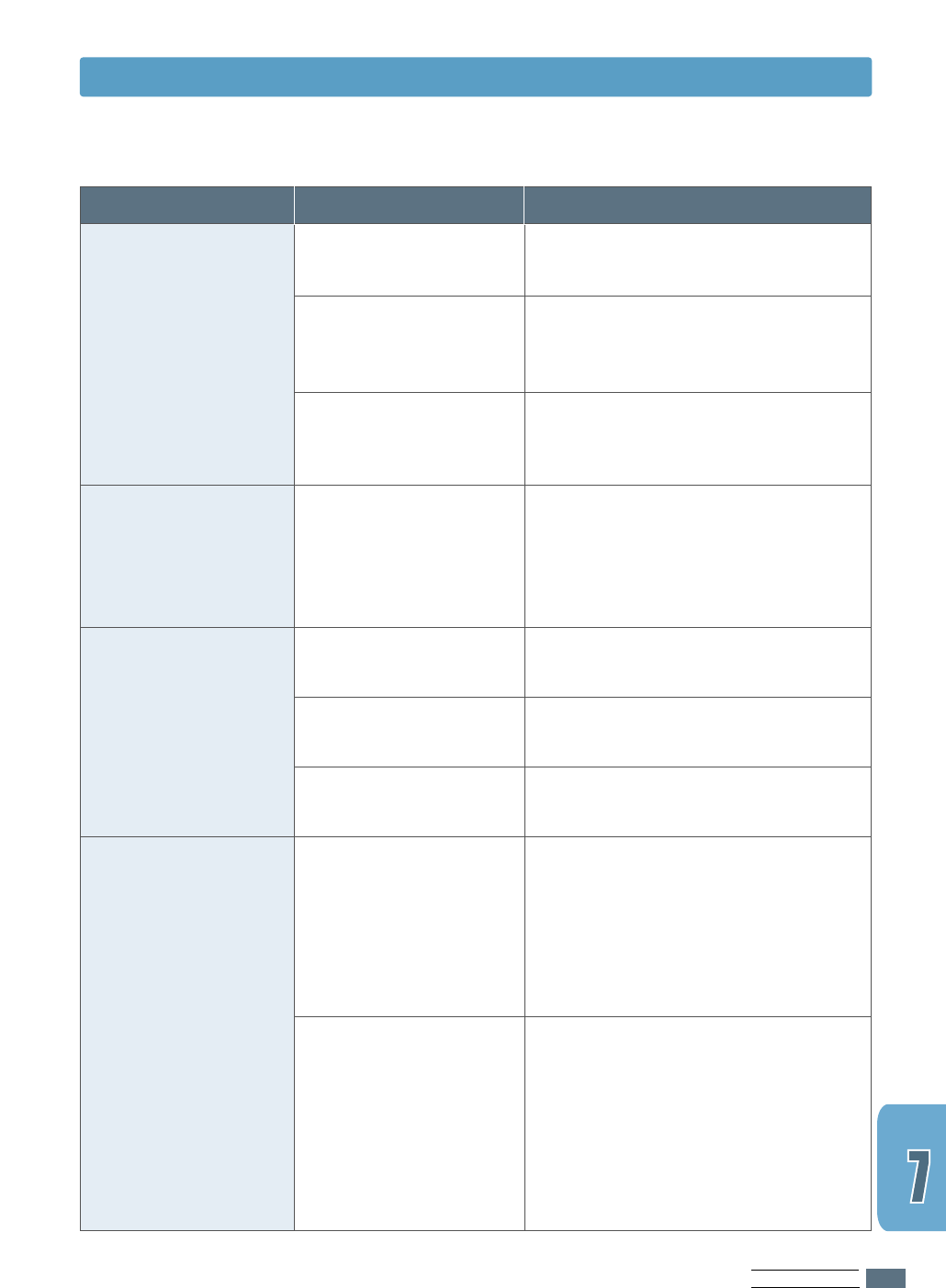
PROBLEM SOLVING
7.3
Solving General Printing Problems
Problem
The printer does not
print. (continued)
Printer selects media
from the wrong
paper source.
Paper does not feed
into the printer.
Print job is extremely
slow.
Possible Cause
The printer may be
configured incorrectly.
The printer driver may
be incorrectly installed.
The printer is
malfunctioning.
The paper source
selection in the printer
properties may be
incorrect.
Paper has not been
loaded correctly.
There is too much paper
in the input tray.
The paper is too thick.
The job may be very
complex.
The maximum print
speed of the Samsung
ML-1250 printer is 8
pages per minute.
If using Windows 95, the
Spooling Setting may be
set incorrectly.
Solution
Check the printer properties to make
sure that all print settings are correct.
Uninstall the printer driver, then
reinstall the printer driver. Try printing
a demo page.
Check the lights on the control panel to
determine if the printer is indicating a
system error.
For many software applications the
paper source selection is found under
the Paper tab within the printer
properties. Select the correct paper
source.
Remove paper from the input tray and
reload it correctly.
Remove excess paper from the input
tray.
Use only paper that meets the
specifications required by the printer.
Reduce the complexity of the page or
try adjusting the print quality settings.
Access the Start menu, and then
choose Settings and Printers. Right-
click the Samsung ML-1250 PCL 6
printer icon, choose Properties, click
the Details tab, and then choose the
Spool Settings button. Select the
desired spool setting from the available
choices.
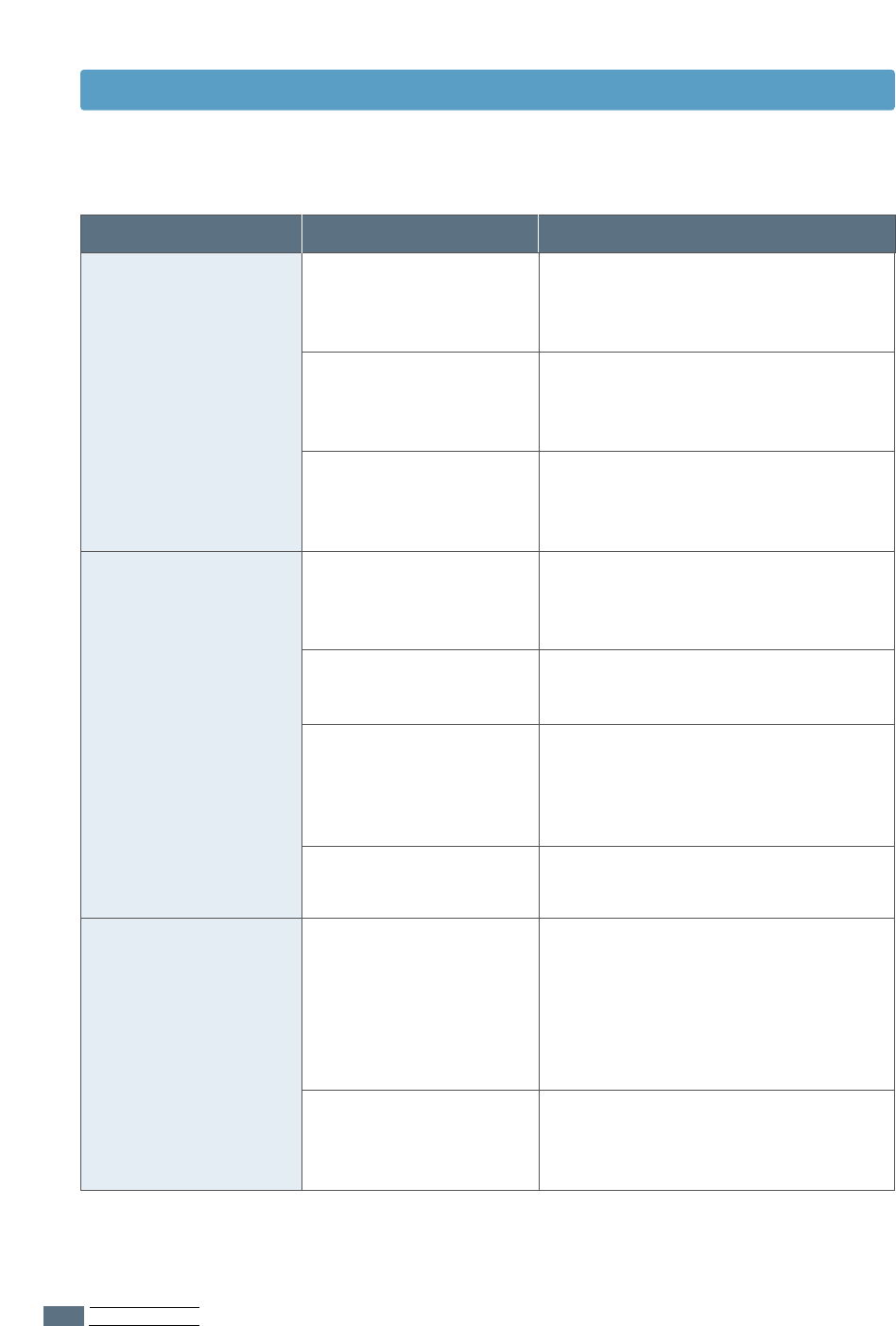
PROBLEM SOLVING
7.4
Solving General Printing Problems
Problem
Half of the page is
blank.
The paper keeps
jamming.
The printer prints,
but the text is
wrong, garbled, or
incomplete.
Possible Cause
The page layout is too
complex.
The page orientation
setting may be
incorrect.
The paper size and the
paper size settings do
not match.
There is too much
paper in the paper tray.
An incorrect type of
paper is being used.
An incorrect output
method is being used.
There may be debris
inside the machine.
The printer cable is
loose or defective.
The wrong printer driver
was selected.
Solution
Simplify the page layout and remove
any unnecessary graphics from the
document, if possible.
Change the page orientation in your
application.
Make sure that the paper size in the
print settings matches the paper in
the input tray.
Remove excess paper from the tray.
If printing special media, use the
manual input tray.
Use only paper that meets the
specifications required by the printer.
Media such as thick paper should not
be printed using the face-down output
tray. Use the face-up output slot
instead.
Open the front cover and remove the
debris.
Disconnect the printer cable and
reconnect it. Try a print job that you
know works. If possible, attach the
cable and printer to another computer
and try a print job that you know
works. Finally, try a new printer cable.
Check the application’s printer
selection menu to make sure that your
printer is selected.
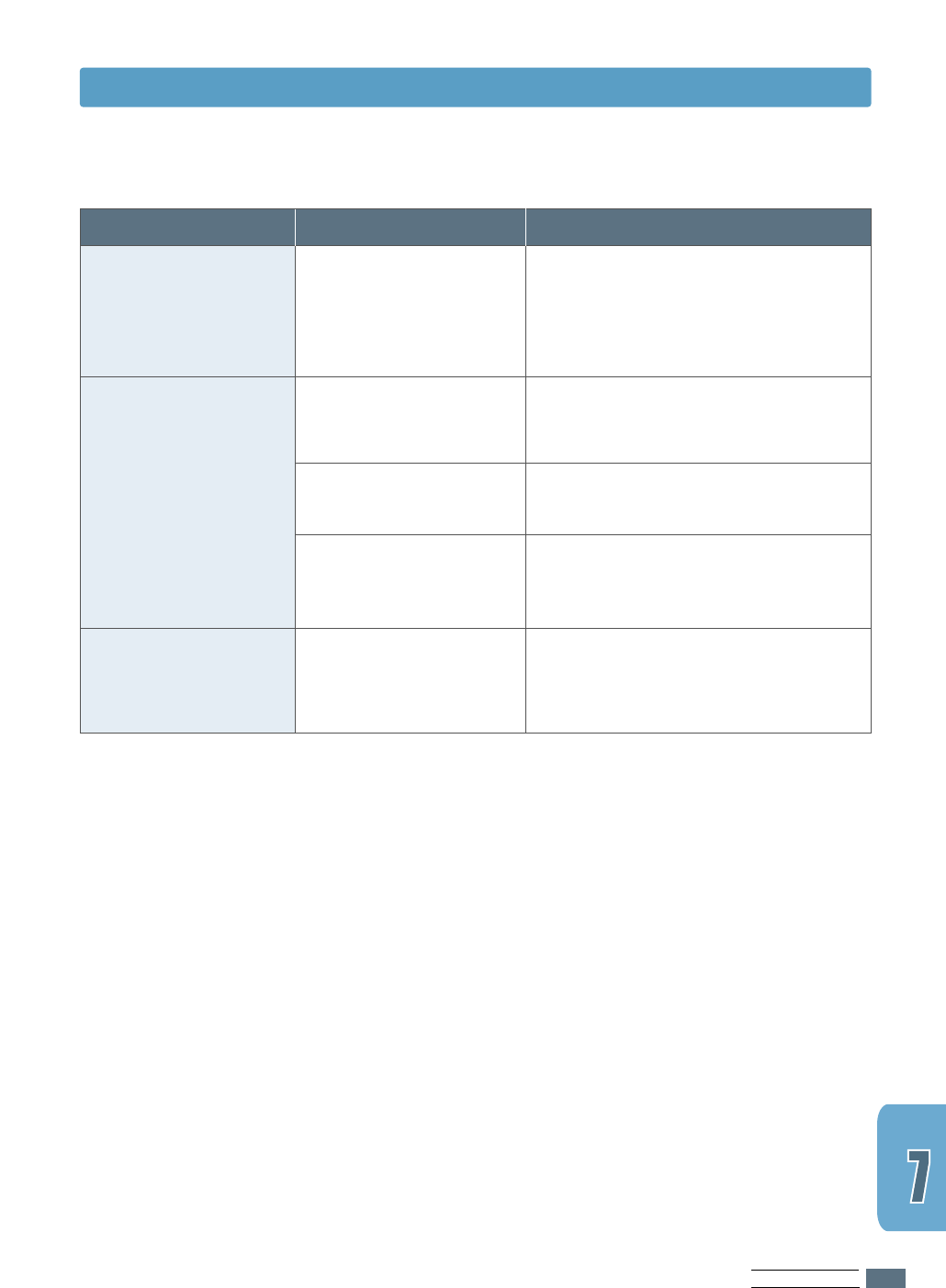
PROBLEM SOLVING
7.5
Solving General Printing Problems
Problem
The printer prints, but
the text is wrong,
garbled, or incomplete.
(continued)
Pages print, but are
totally blank.
Illustrations will not
print correctly when
using Adobe Illustrator.
Possible Cause
The software application
is malfunctioning.
The toner cartridge is
defective or out of toner.
The file may have blank
pages.
Some parts, such as the
controller, the board,
may be defective.
The setting in the
software application is
wrong.
Solution
Try printing a job from another
application.
Replace the toner cartridge.
Check the file to make sure that it
does not contain blank pages.
Contact a service representative.
Print the document with the Bitmap
Printing checkbox in the Print dialog
box empty.
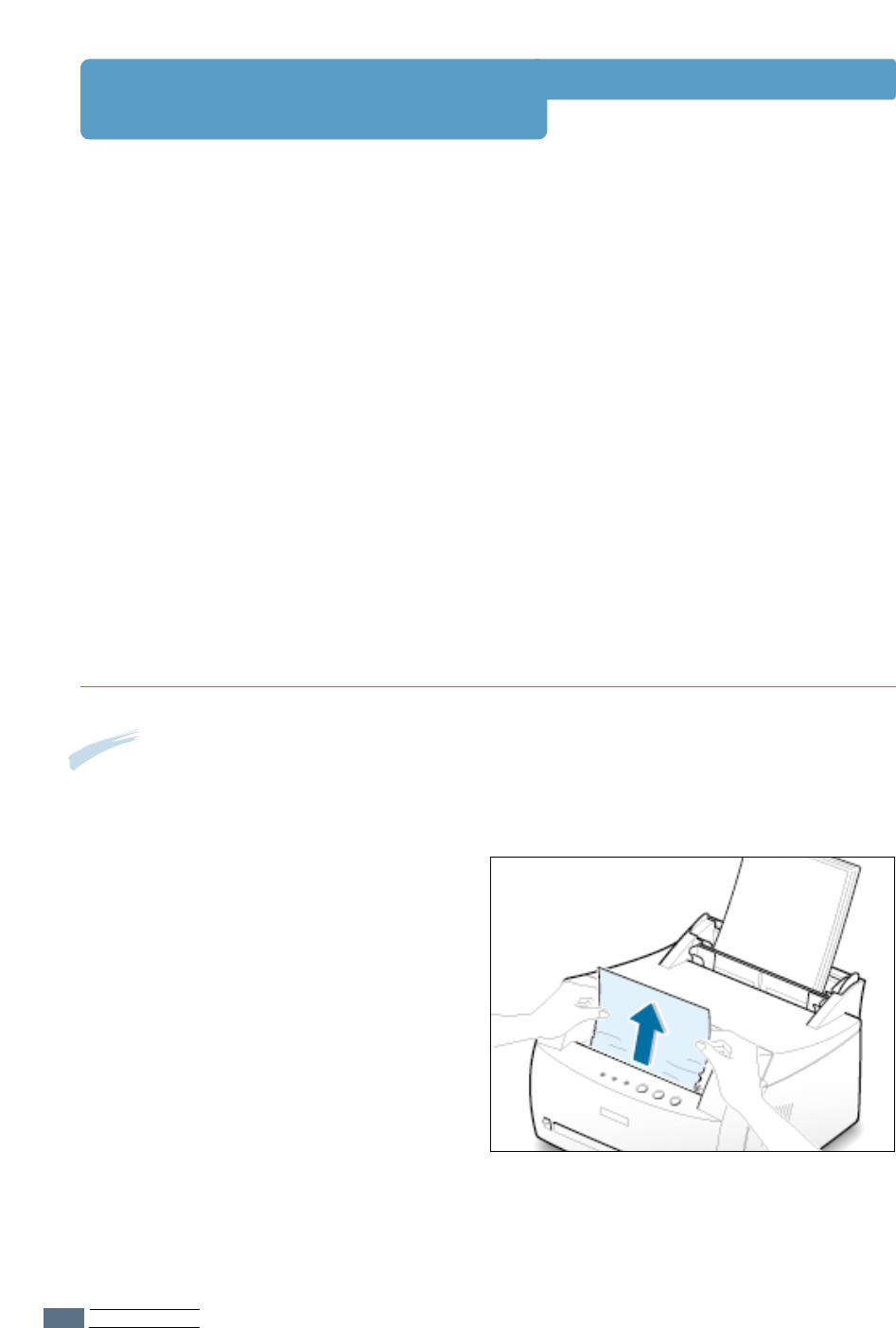
PROBLEM SOLVING
7.6
Clearing Paper Jams
Occasionally, paper can become jammed during a print job. Some of the causes include:
• The paper tray is loaded improperly or overfilled.
• The paper tray has been pulled out during a print job.
• The top cover has been opened during a print job.
• Paper that does not meet paper specifications has been used. See “Paper Specifications” on
page A.2.
• Paper that is outside of the supported size range has been used. See “Paper Specifications”.
If a paper jam occurs, the Paper and the Error lights remain lit on the control panel. Find
and remove the jammed paper. If the location of the paper jam is not obvious, look inside the
printer first.
Note: Paper jams in this area may result in loose toner on the page. If you get any toner on your
clothes, wash them in cold water because hot water will set the toner into the fabric.
Output Area
1
Pull the jammed paper carefully out of
the output stacker.
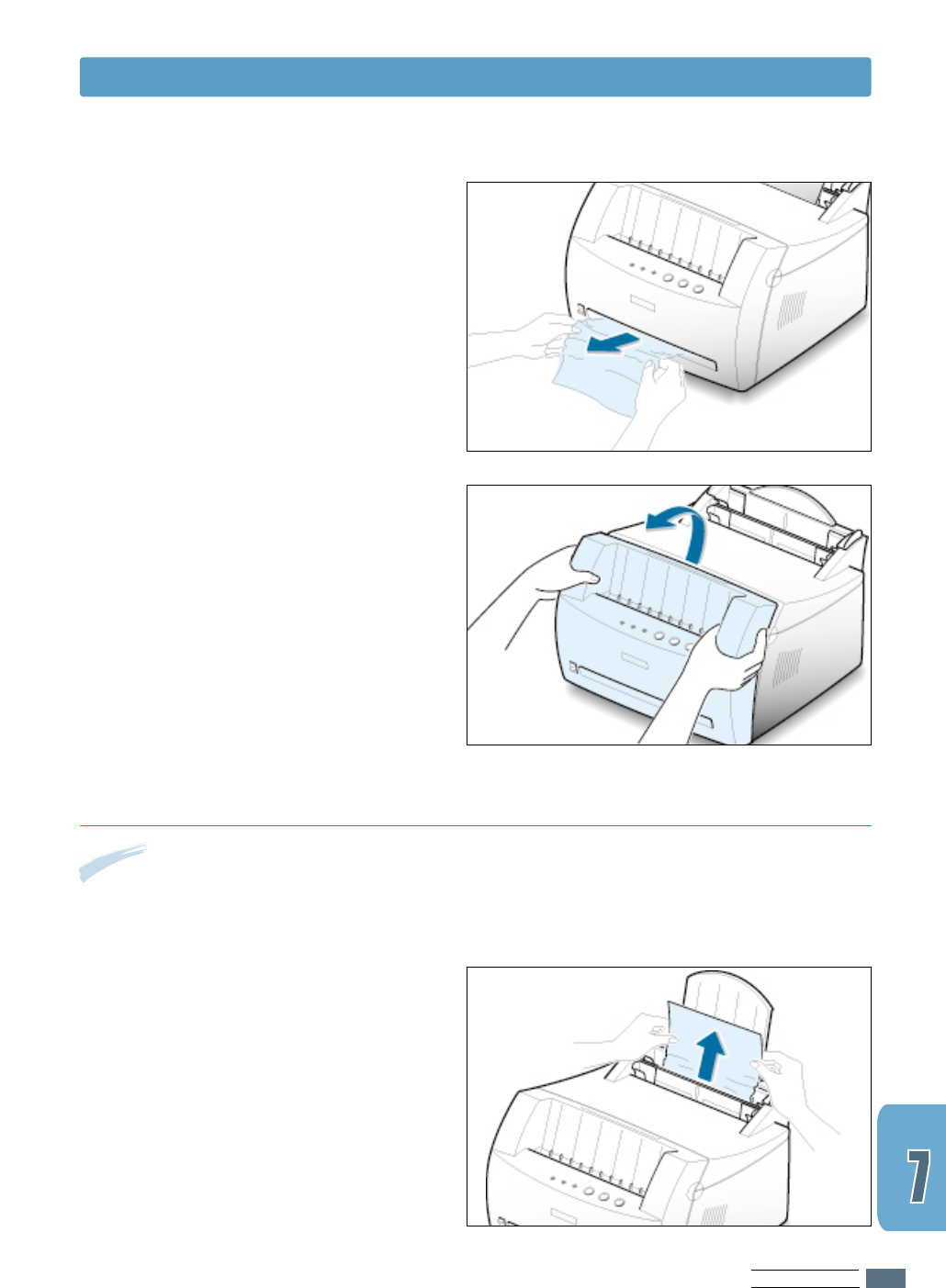
PROBLEM SOLVING
7.7
Note: If paper has entered the toner cartridge area, follow the instructions on page 7.8. It is
easier to remove such jams from the inside of the printer than the paper input area.
Input Area
1
Carefully pull the jammed paper out of
the input tray.
2
Open and close the front cover.
Printing can be resumed.
5
If paper is jammed in the face-up
output slot, carefully remove the paper
as shown.
Clearing Paper Jams
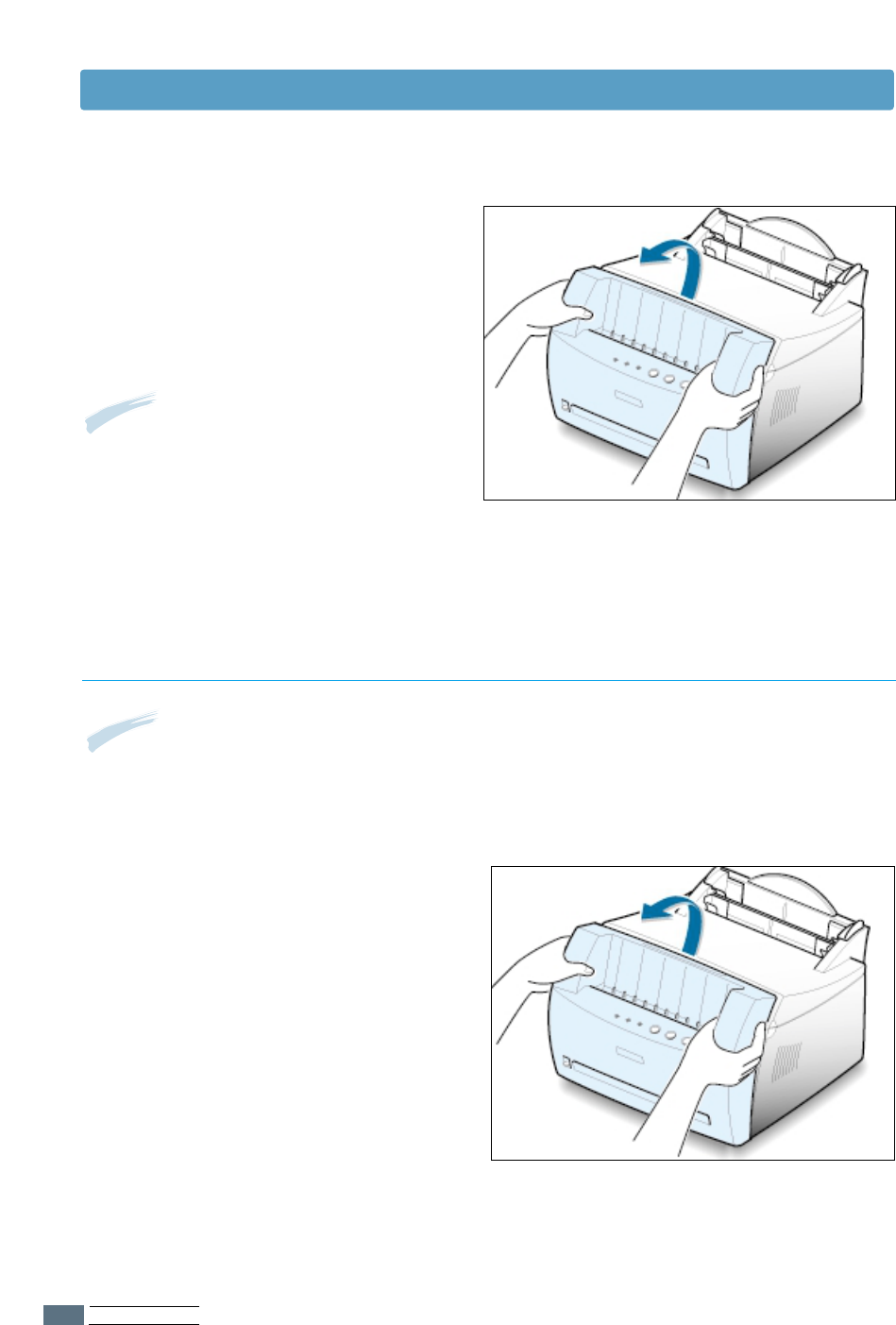
PROBLEM SOLVING
7.8
Clearing Paper Jams
2
Open and close the front cover to
resume printing.
Note: If the Paper and the Error lights
do not turn off, there is still jammed
paper inside the printer. Check the
inside of the printer.
Inside the Printer
1
Grasp the front cover by both sides of
the cover and pull it toward you to
open.
Note: Paper jams in this area may result in loose toner on the page. If you get any toner on
your clothes, wash them in cold water because hot water will set the toner into the fabric.
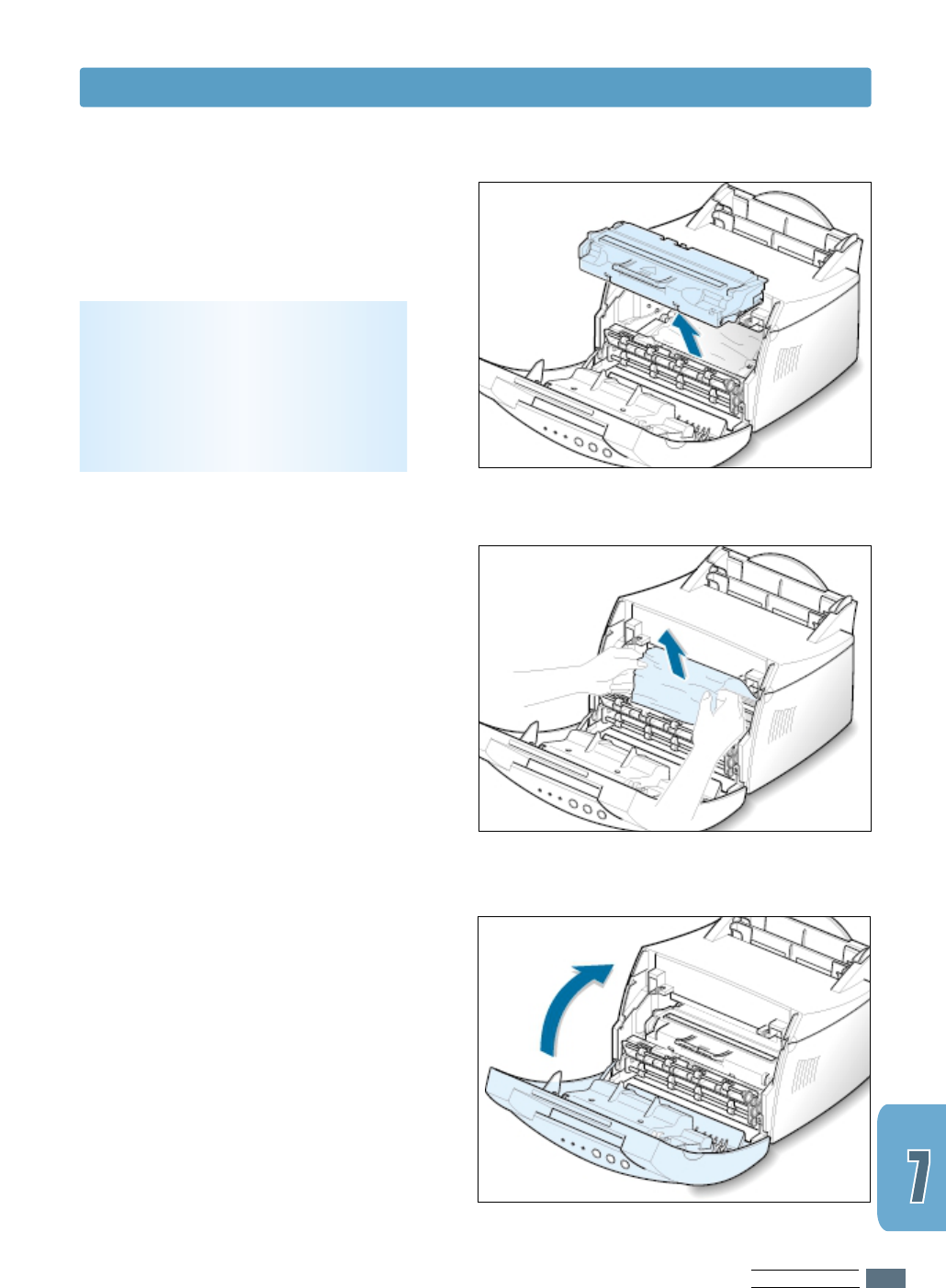
PROBLEM SOLVING
7.9
Clearing Paper Jams
4
Reinsert the toner cartridge and close
the front cover. Printing can be
resumed.
3
Gently pull the paper toward you to
remove it from the printer.
Make sure that there is no paper
remaining inside the printer.
CAUTION:To prevent damage to the
toner cartridge, do not expose it to
light for more than a few minutes.
Place a piece of paper over the top of
the toner cartridge to shield it while it
is out of the printer.
2
Remove the toner cartridge.

PROBLEM SOLVING
7.10
Tips for Avoiding Paper Jams
By selecting correct paper types and loading them properly,
you should be able to avoid most paper jams. If paper jams
occur, follow the steps outlined in “Clearing Paper Jams” on
page 7.6. If jams occur frequently, make sure you are
following these tips to avoid jams.
• Follow the procedures in “Load Paper” on page 2.4 to load
the paper properly. Make sure the adjustable guides are
positioned correctly.
• Do not overload the automatic input tray. Make sure the
paper is under the paper capacity mark on the inside of the
tray.
• Do not remove the paper from the input tray while print jobs
are in process.
• Flex, fan and straighten the paper before loading it.
• Do not load wrinkled, creased, damp or highly curled paper.
• Do not mix paper types in the input tray.
• Use only recommended print media. See “Paper
Specifications” on page A.2.
• Make sure that the recommended print side is facing up when
loading the paper into both input trays.
• Keep print media stored in an acceptable environment. See
“Printer and Paper Storage Environment” on page A.6.
Clearing Paper Jams
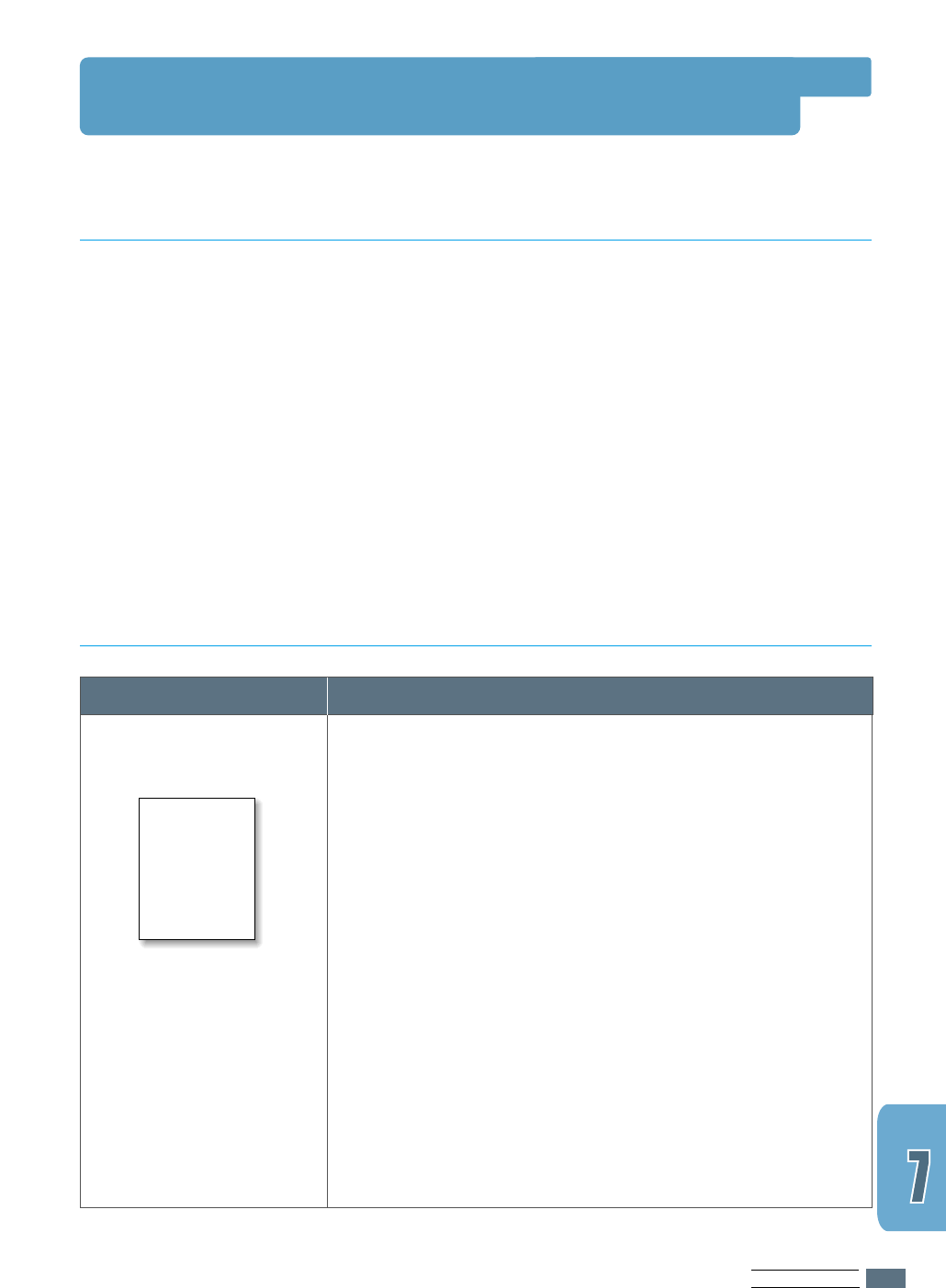
PROBLEM SOLVING
7.11
Problem Solution
Solving Print Quality Problems
General print quality problems can be solved by following the checklist below.
• Redistribute the toner in the toner cartridge (see page 6.2).
• Clean the inside of the printer (see page 6.4).
• Adjust the print resolution from the printer properties (see page 5.12).
• Check to make sure that Toner Save Mode is off (see page 5.6).
• Troubleshoot general printing problems (see page 7.2).
• Install a new toner cartridge, then check print quality again (see page 2.2).
Print Quality Checklist
Solving Print Quality Problems
If a vertical white streak or faded area appears on the page:
• The toner supply is low. You may be able to temporarily
extend the toner cartridge life. See “Redistributing the
Toner” on page 6.2. If this does not improve the print
quality, install a new toner cartridge.
• The paper may not meet paper specifications (for example,
the paper is too moist or too rough). See “Paper
Specifications” on page A.2.
• If the whole page is light, the print resolution setting is too
light or Toner Save Mode may be on. Adjust the print
resolution and Toner Save Mode within the printer
properties. See page 5.6 and 5.12 respectively.
• A combination of faded and smeared defects may indicate
that the toner cartridge needs cleaning. See “Cleaning the
Printer” on page 6.4.
• The surface of the LSU part inside the printer may be dirty.
Clean the LSU. See “Cleaning the Printer”.
Light or faded print
AaBbCc
AaBbCc
AaBbCc
AaBbCc
AaBbCc
AaBbCc
AaBbCc
AaBbCc
AaBbCc
AaBbCc
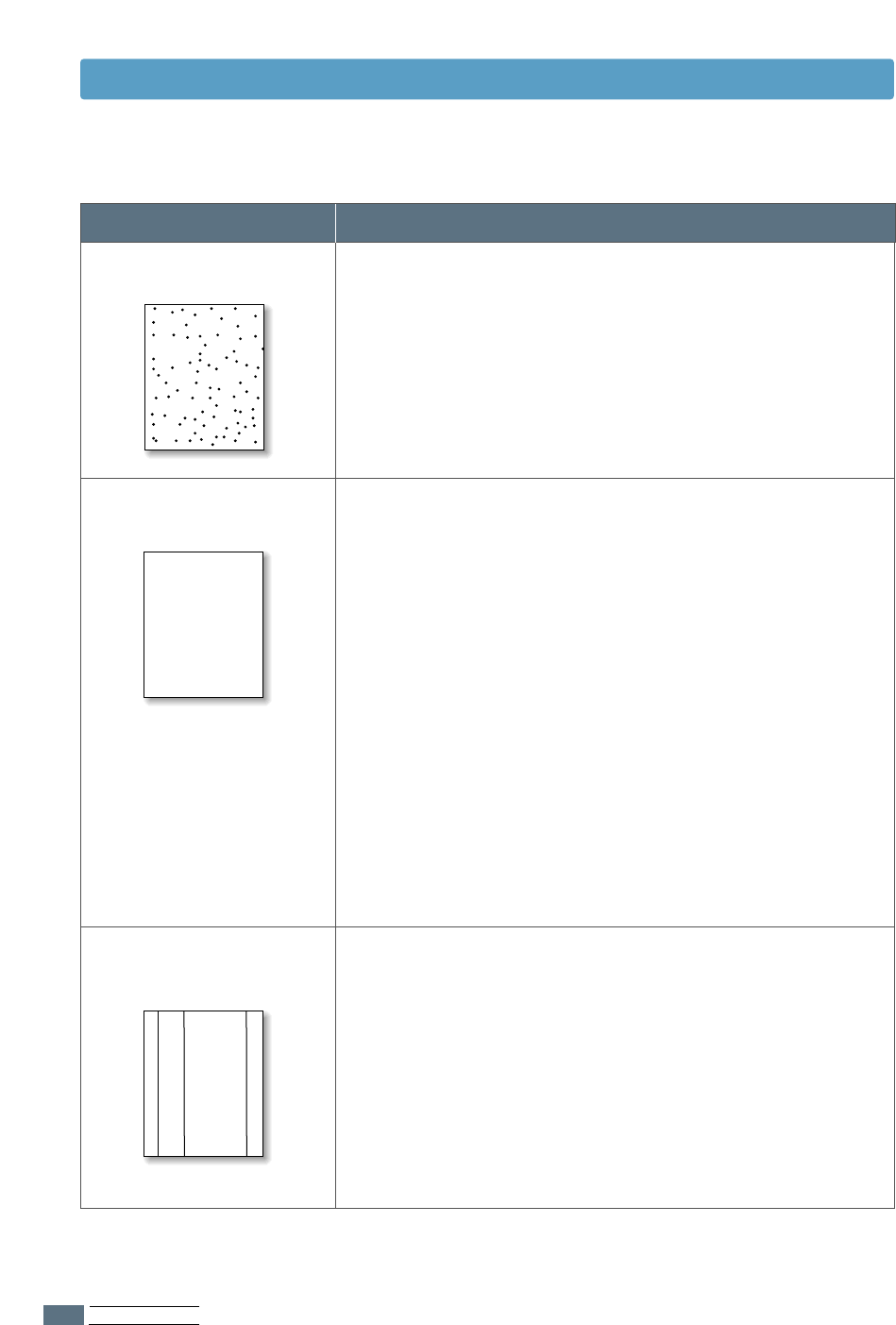
PROBLEM SOLVING
7.12
Solving Print Quality Problems
Problem Solution
• The paper may not meet paper specifications (for example,
the paper is too moist or too rough). See “Paper
Specifications” on page A.2.
• The transfer roller may be dirty. See “Cleaning the Inside”
on page 6.4.
• The paper path may need cleaning. See “Cleaning the
Inside”.
Toner specks
If faded areas, generally rounded, occur randomly on the
page:
• A single sheet of paper may be defective. Try reprinting the
job.
• The moisture content of the paper is uneven or the paper
has moist spots on its surface. Try a different kind or brand
of paper. See “Paper Specifications” on page A.2.
• The paper lot is bad. The manufacturing processes can
cause some areas to reject toner. Try a different kind or
brand of paper.
• The toner cartridge may be defective. See “Vertical
repetitive defects” on page 7.13.
• If these steps do not correct the problems, contact a
service representative.
Dropouts
If black vertical streaks appear on the page:
• The photosensitive drum inside the toner cartridge has
probably been scratched. Install a new toner cartridge.
If white vertical streaks appear on the page:
• The surface of LSU part inside the printer may be dirty.
Clean the LSU (see page 6.4).
Vertical lines
AaBbCc
AaBbCc
AaBbCc
AaBbCc
AaBbCc
AaBbCc
AaBbCc
AaBbCc
AaBbCc
AaBbCc
AaBbCc
AaBbCc
AaBbCc
AaBbCc
AaBbCc
AaBbCc
AaBbCc
AaBbCc
AaBbCc
AaBbCc
AaBbCc
AaBbCc
AaBbCc
AaBbCc
AaBbCc
AaBbCc
AaBbCc
AaBbCc
AaBbCc
AaBbCc
AaBbCc
AaBbCc
AaBbCc
AaBbCc
AaBbCc
AaBbCc
AaBbCc
AaBbCc
AaBbCc
AaBbCc
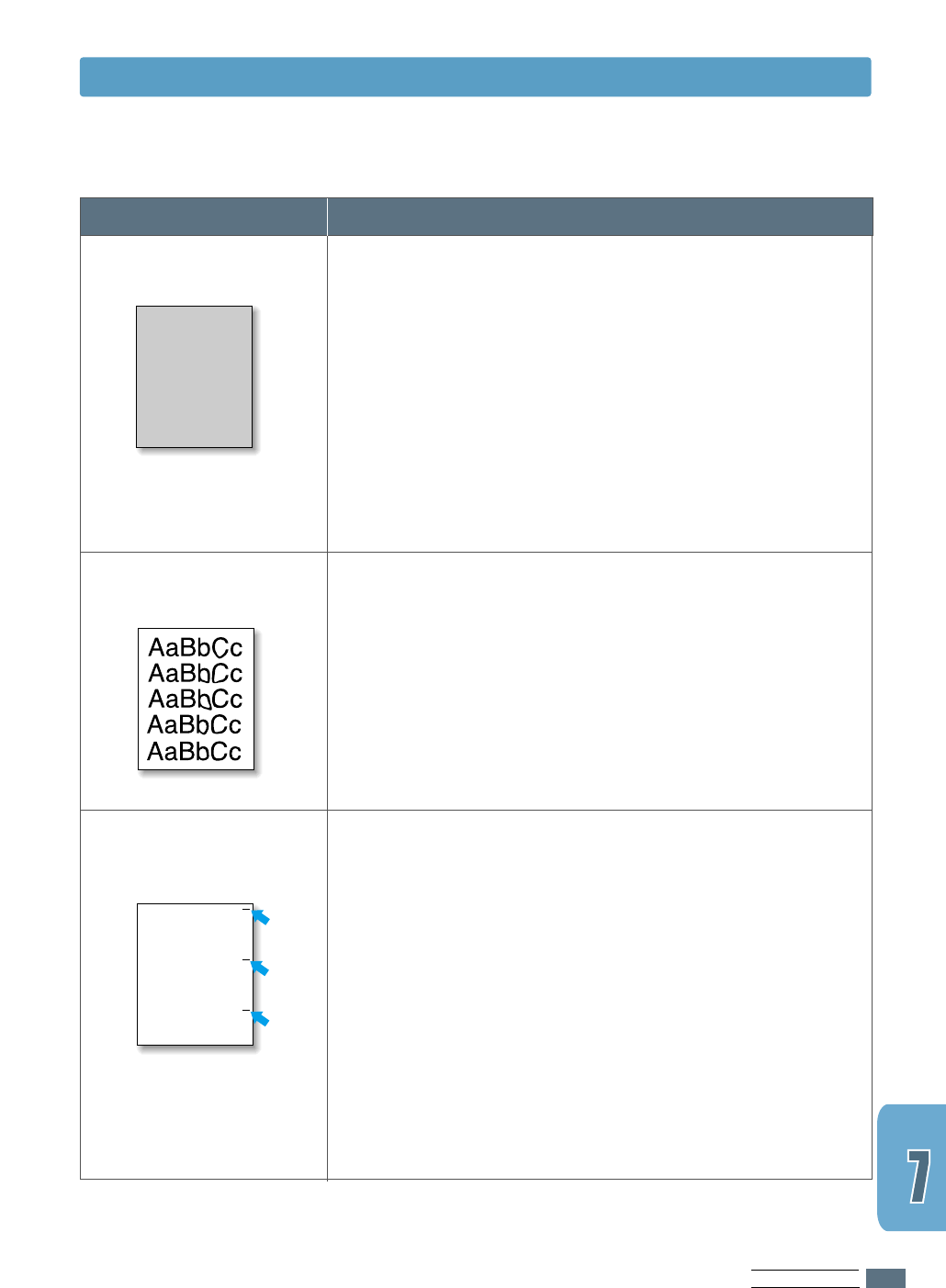
PROBLEM SOLVING
7.13
Problem Solution
If the amount of background toner shading becomes
unacceptable, the procedures below may help to clear the
condition:
• Change the paper to a lighter basis weight. See “Paper
Specifications” on page A.2.
• Check the printer’s environment; very dry (low humidity)
or high humidity (higher than 80 % RH) conditions can
increase the amount of background shading.
• Install a new toner cartridge.
Gray background
• Clean the inside of the printer. See “Cleaning the Inside”
on page 6.4.
• Check the paper type and quality. See “Paper
Specifications” on page A.2.
• Try installing a new toner cartridge.
Toner smear
If marks repeatedly appear on the printed side of the page
at even intervals:
• The toner cartridge may be damaged. If a repetitive mark
occurs every 95 mm or 38 mm on the page, print a
cleaning sheet several times to clean the cartridge (see
page 6.5). After the printout, if you still have the same
problems, install a new toner cartridge.
• Parts in the printer may have toner on them. If the defects
occur on the back of the page, the problem will likely
correct itself after a few more pages.
• The fusing assembly may be damaged. Contact a service
representative.
Vertical repetitive defects
Solving Print Quality Problems
AaBbCc
AaBbCc
AaBbCc
AaBbCc
AaBbCc
AaBbCc
AaBbCc
AaBbCc
AaBbCc
AaBbCc
AaBbCc
AaBbCc
AaBbCc
AaBbCc
AaBbCc
AaBbCc
AaBbCc
AaBbCc
AaBbCc
AaBbCc
AaBbCc
AaBbCc
AaBbCc
AaBbCc
AaBbCc
AaBbCc
AaBbCc
AaBbCc
AaBbCc
AaBbCc
AaBbCc
AaBbCc
AaBbCc
AaBbCc
AaBbCc
AaBbCc
AaBbCc
AaBbCc
AaBbCc
AaBbCc
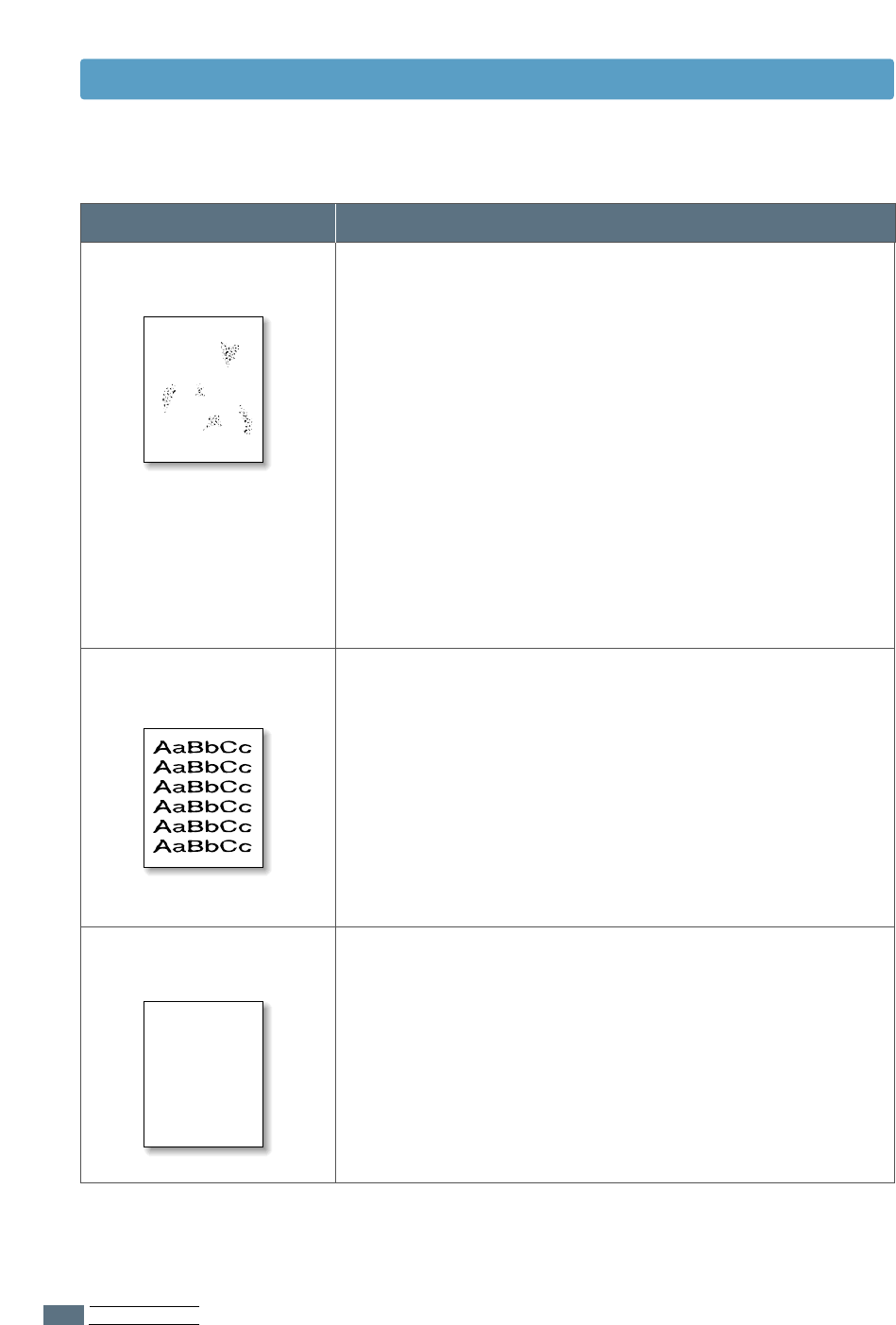
PROBLEM SOLVING
7.14
Solving Print Quality Problems
Problem Solution
• If characters are improperly formed, producing hollow
images, the paper stock may be too slick. Try a different
paper. See “Paper Specifications” on page A.2.
• If characters are improperly formed, producing a wavy
effect, the scanner unit may need service. Verify that it
also occurs on a demo page by pressing the Demo button
on the control panel when printer is ready. If you need
service, contact a service representative.
Misformed characters
• Check the paper type and quality. See “Paper
Specifications” on page A.2.
• Make sure that the paper or other media is loaded
correctly and that the guides are not too tight or too loose
against the paper stack.
Page skew
Background scatter results from bits of toner distributed on
the printed page.
• The paper may be too damp. Try printing with a different
batch of paper. Do not open packages of paper until
necessary so that the paper does not absorb too much
moisture from the air.
• If background scatter occurs on an envelope, change your
printing layout to avoid printing over areas that have
overlapping seams on the reverse side. Printing on seams
can cause this problem.
• If background scatter covers the entire surface of a printed
page, adjust the print resolution through your software
application or the printer properties.
Background scatter
AaBbCc
AaBbCc
AaBbCc
AaBbCc
AaBbCc
AaBbCc
AaBbCc
AaBbCc
AaBbCc
AaBbCc
A
AaBbCc
AaBbCc
AaBbCc
AaBbCc
AaBbCc
AaBbCc
AaBbCc
AaBbCc
AaBbCc
AaBbCc
AaBbCc
AaBbCc
AaBbCc
AaBbCc
AaBbCc
AaBbCc
AaBbCc
AaBbCc
AaBbCc
AaBbCc
AaBbCc
AaBbCc
AaBbCc
AaBbCc
AaBbCc
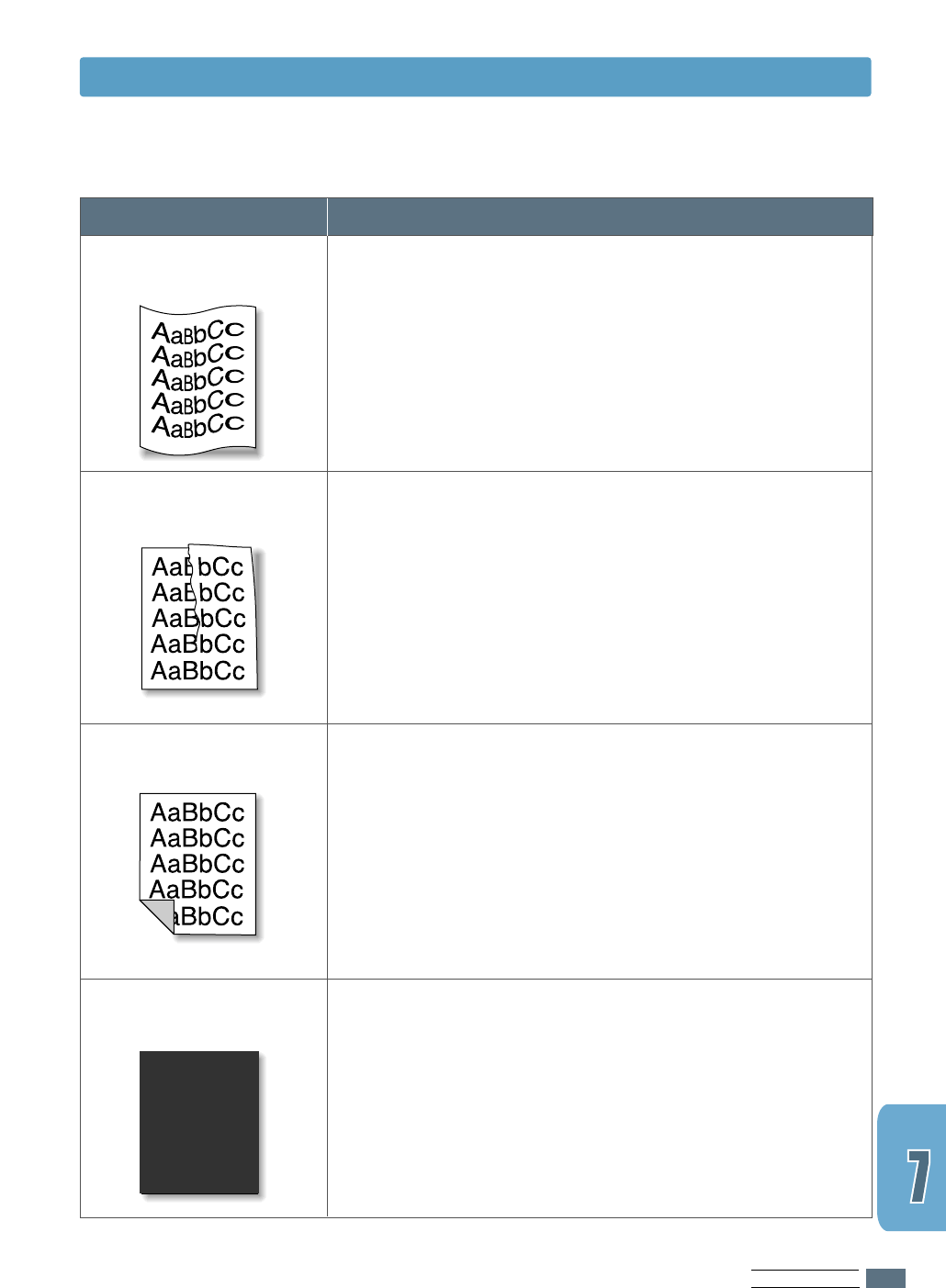
PROBLEM SOLVING
7.15
Problem Solution
Solving Print Quality Problems
• Check the paper type and quality. Both high temperature
and humidity will cause paper curl. See “Paper
Specifications” on page A.2.
• Turn over the stack of paper in the input tray. Also try
rotating the paper 180° in the input tray.
• Push the output lever and try printing to the face up output
slot.
Curl or wave
• Make sure that paper is loaded properly.
• Check the paper type and quality. See “Paper
Specifications” on page A.2.
• Push the output lever and try printing to the face up output
slot.
• Turn over the stack of paper in the input tray. Also try
rotating the paper 180° in the feeder.
Wrinkles or creases
• The transfer roller may be dirty. See “Cleaning the Inside”
on page 6.4.
• Check if the toner is leaking. Clean inside the printer.
Back of printouts dirty
• The toner cartridge may not be installed properly. Remove
the cartridge and reinsert it.
• The toner cartridge may be defective and need replacing.
Install a new toner cartridge.
• The printer may require repairs. Contact a service
representative.
AaBbCc
AaBbCc
AaBbCc
AaBbCc
AaBbCc
AaBbCc
AaBbCc
AaBbCc
AaBbCc
AaBbCc
AaBbCc
AaBbCc
AaBbCc
AaBbCc
AaBbCc
AaBbCc
AaBbCc
AaBbCc
AaBbCc
AaBbCc
AaBbCc
AaBbCc
AaBbCc
AaBbCc
AaBbCc
AaBbCc
AaBbCc
AaBbCc
AaBbCc
AaBbCc
AaBbCc
AaBbCc
AaBbCc
AaBbCc
AaBbCc
AaBbCc
AaBbCc
AaBbCc
AaBbCc
AaBbCc
Black pages
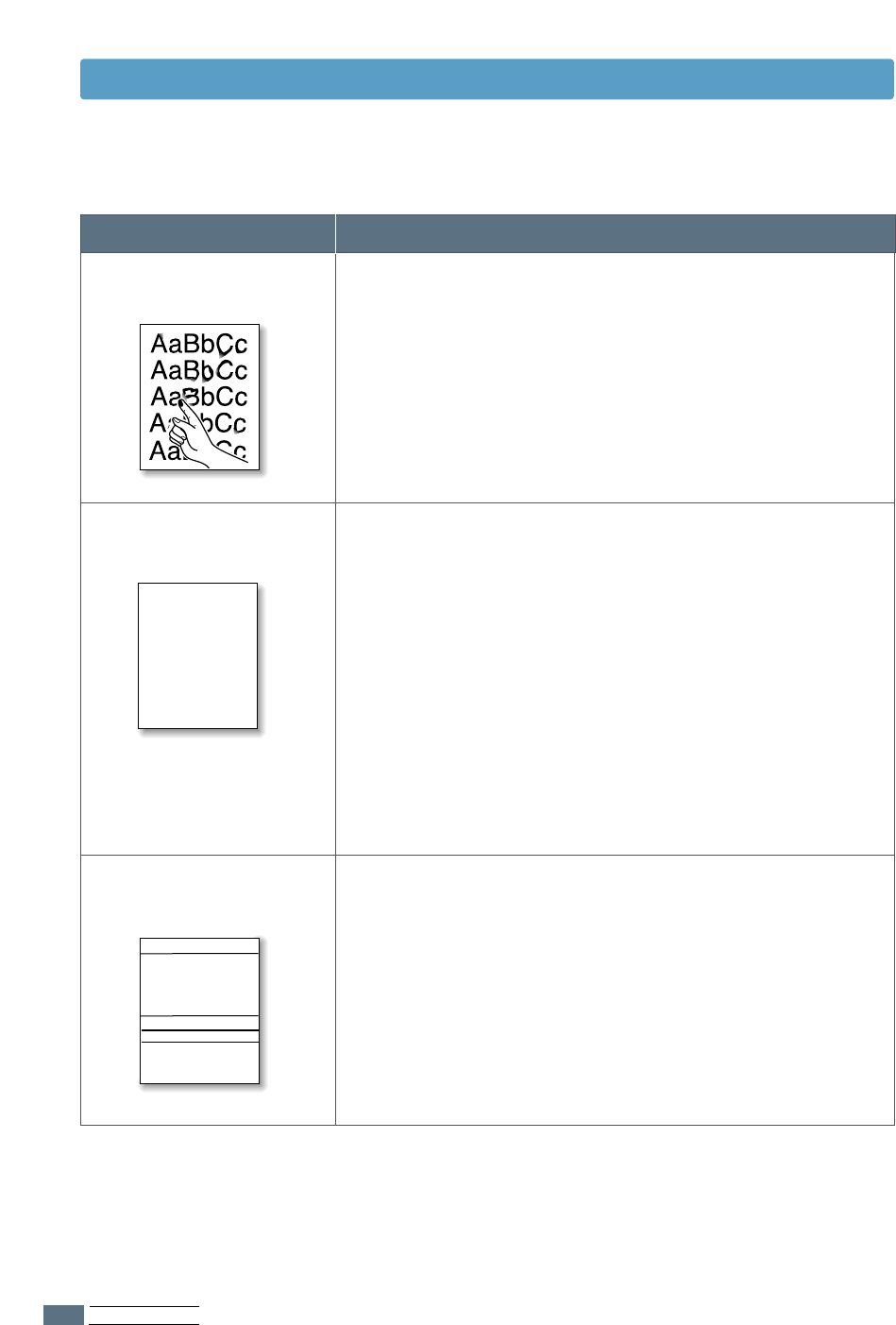
PROBLEM SOLVING
7.16
Problem Solution
Character voids are white areas within the parts of
characters that should be solid black:
• If you are using transparencies when you experience this
problem, try another type of transparency. (Because of the
composition of transparency media, some character voids
are normal.)
• You may be printing on the wrong surface of the paper.
Remove the paper and turn it around.
• The paper may not meet paper specifications. See “Paper
Specifications” on page A.2.
Character Voids
• Clean the inside of the printer.
• Check the paper type and quality. See “Paper
Specifications” on page A.2.
• Try installing a new toner cartridge.
• If the problem persists, the printer may require repairs.
Contact a service representative.
Loose toner
If horizontally aligned black streaks or smears appear:
• The toner cartridge may be installed improperly. Remove
the cartridge and reinsert it.
• The toner cartridge may be defective. Install a new toner
cartridge.
• If the problem persists, the printer may require repairs.
Contact a service representative.
Horizontal stripes
AaBbCc
AaBbCc
AaBbCc
AaBbCc
AaBbCc
AaBbCc
AaBbCc
AaBbCc
AaBbCc
AaBbCc
AaBbCc
AaBbCc
AaBbCc
AaBbCc
AaBbCc
AaBbCc
AaBbCc
AaBbCc
AaBbCc
AaBbCc
A
AaBbCc
AaBbCc
AaBbCc
AaBbCc
AaBbCc
AaBbCc
AaBbCc
AaBbCc
AaBbCc
AaBbCc
AaBbCc
AaBbCc
AaBbCc
AaBbCc
AaBbCc
Solving Print Quality Problems
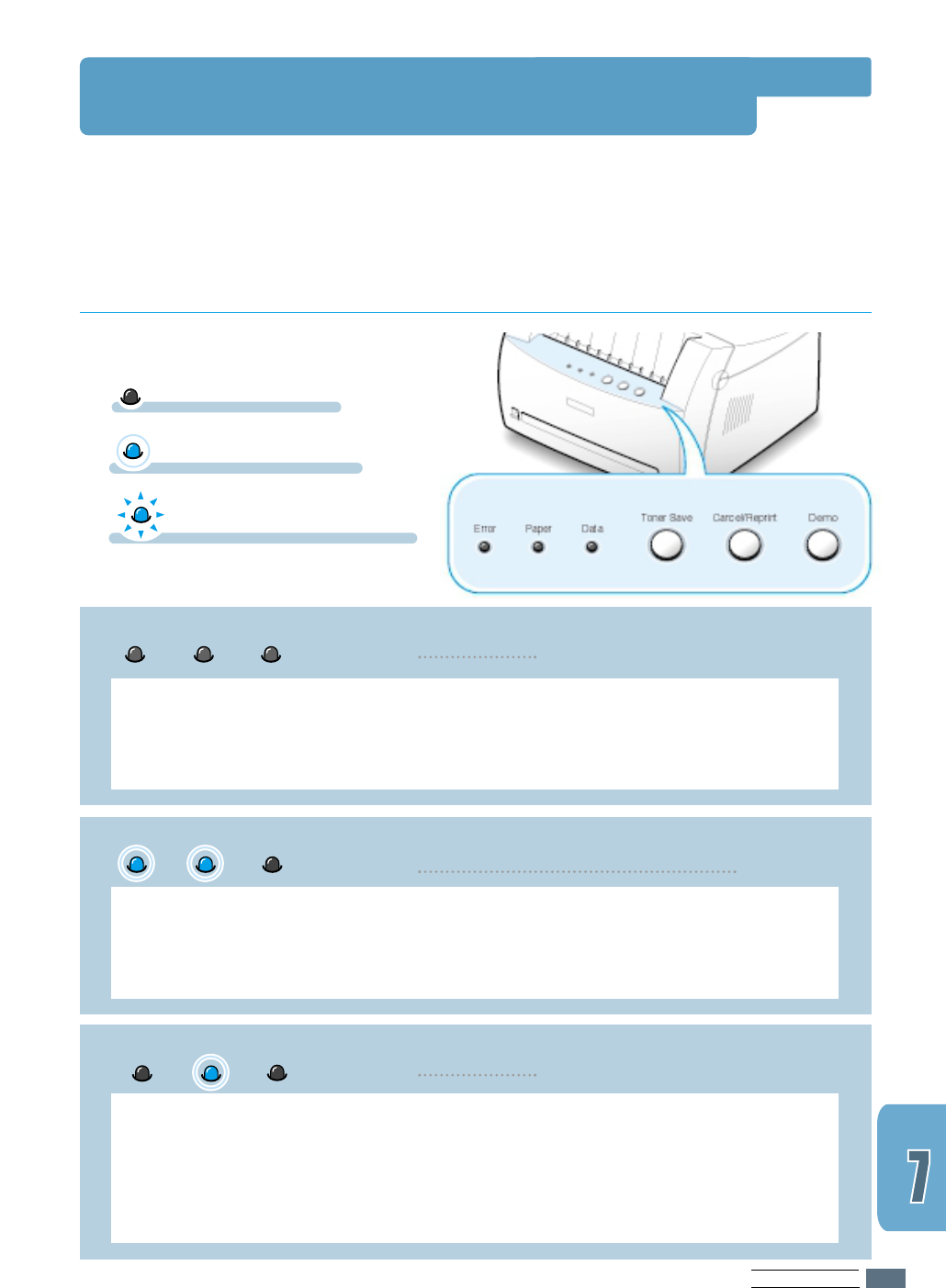
PROBLEM SOLVING
7.17
When the printer experiences an error, the control panel will indicate error messages by the
indicator lights. Find the light pattern below that matches the printer light pattern and follow
the solutions to clear the error.
Troubleshooting Error Messages
Printer Light Patterns
Light status legend
symbol for “light on”
symbol for “light blinking”
symbol for “light off”
• Check the power cord and the power switch if your printer does not generate a
response.
• Make sure that the printer is powered with the specified AC voltage.
Power off
Error Paper Data
The printer is out of paper in the input tray.
• Load paper into the tray. For the automatic input tray, loading paper will cancel
this message and allow you to continue with the print job.
For the manual input
tray, press the Demo button after loading paper.
Paper out
Data
Error Paper
Paper is jammed inside the printer or the toner cartridge is not installed.
• Clear the paper jam. See “Clearing Paper Jams” on page 7.6.
• Make sure that the toner cartridge is correctly installed in the printer.
Paper jam, or no toner cartridge
Data
Error Paper
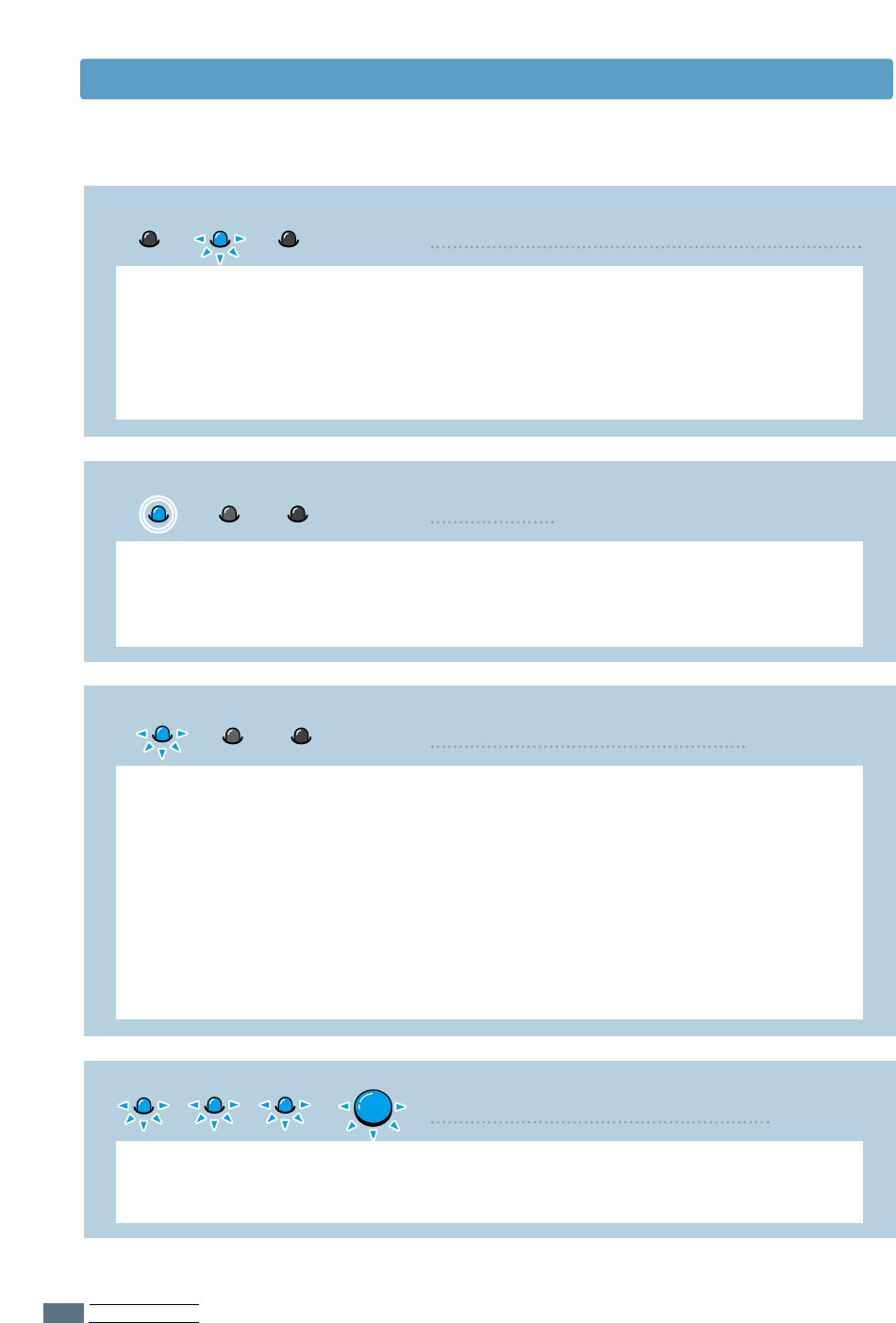
PROBLEM SOLVING
7.18
Troubleshooting Error Messages
While printing in the manual feed mode, the printer is waiting for the Demo
button to be pressed.
• Press the Demo button on the control panel to start printing. You must press the
button to print each page after loading paper into the manual input tray.
Waiting for the Demo button to be pressed
Data
Error Paper
The printer front cover may be open.
• Check that the printer front cover door is closed properly.
Door open
Data
Error Paper
If your printer is canceling a job (see page 5.5), the Error light blinks. When
cancellation is complete, the message will automatically clear. The printer
memory may not be sufficient for the print job. The page being printed may
have been too complex for the memory capacity of the printer. Press the
Cancel/Reprint button to cancel the current job.
• Try to free up memory by removing any unnecessary fonts, macros, or any data
currently in printer memory.
• Simplify the image or print at a lower resolution.
Canceling a job or memory out
Data
Paper
Error
• Reset the printer by briefly turning the printer off and back on again.
• If the error persists, contact a service representative.
LSU error
Data
Error Paper Toner Save
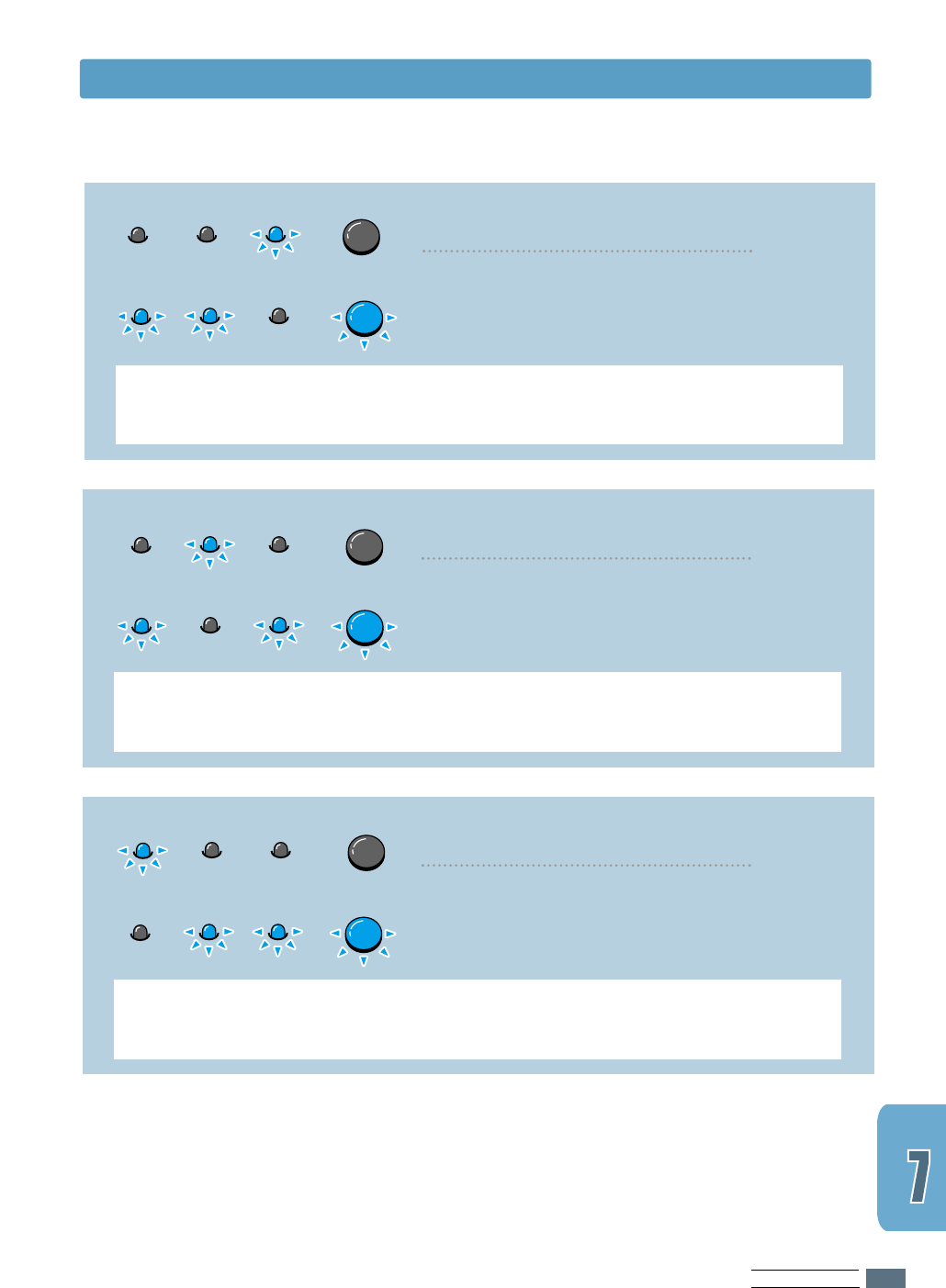
PROBLEM SOLVING
7.19
Troubleshooting Error Messages
• Reset the printer by briefly turning the printer off and back on again.
• If the error persists, contact a service representative.
Engine Over Heat error
Data
Error Paper Toner Save
Data
Error Paper Toner Save
• Reset the printer by briefly turning the printer off and back on again.
• If the error persists, contact a service representative.
System error(No Heat error)
Data
Error Paper Toner Save
Data
Error Paper Toner Save
• Reset the printer by briefly turning the printer off and back on again.
• If the error persists, contact a service representative.
Open Fuser error
Data
Error Paper Toner Save
Data
Error Paper Toner Save

Common Windows Problems
Note: Refer to Microsoft Windows 9x or NT 4.0 documentation that came with your PC for further
information on Windows error messages.
Problem
“File in Use” message
appears during installation.
“Error Writing to LPTx”
message appears.
“General Protection Fault”,
“Exception OE”, “Spool32”,
or “Illegal Operation”
messages appear.
Possible Cause and Solution
Quit all software applications. Remove all software from the
StartUp Group, then restart Windows. Reinstall the printer
driver.
• Make sure the cables are connected correctly, the printer
is on, and the Data light on the control panel is on.
• If bi-directional communication is not turned on in the
driver, it will also cause this message.
• From the Start menu, select Settings, then Printers.
Right-click on the Samsung ML-1250 PCL 6 printer icon
and select Properties. From the Details tab, click on
Port Settings. Remove check from Check Port State
before Printing box and click OK. From Spool
Settings, select Print Directly to Printer and click OK.
Try printing again.
• Close all other applications, reboot Windows, and try
printing again.
• Delete all temp files from the Temp sub-directory. You
can determine the name of the directory by editing the
AUTOEXEC.BAT file and looking for the statement, “Set
Temp =”. The name after this statement is the temp
directory. It is usually C:\temp by default, but can be
redefined.
PROBLEM SOLVING
7.20
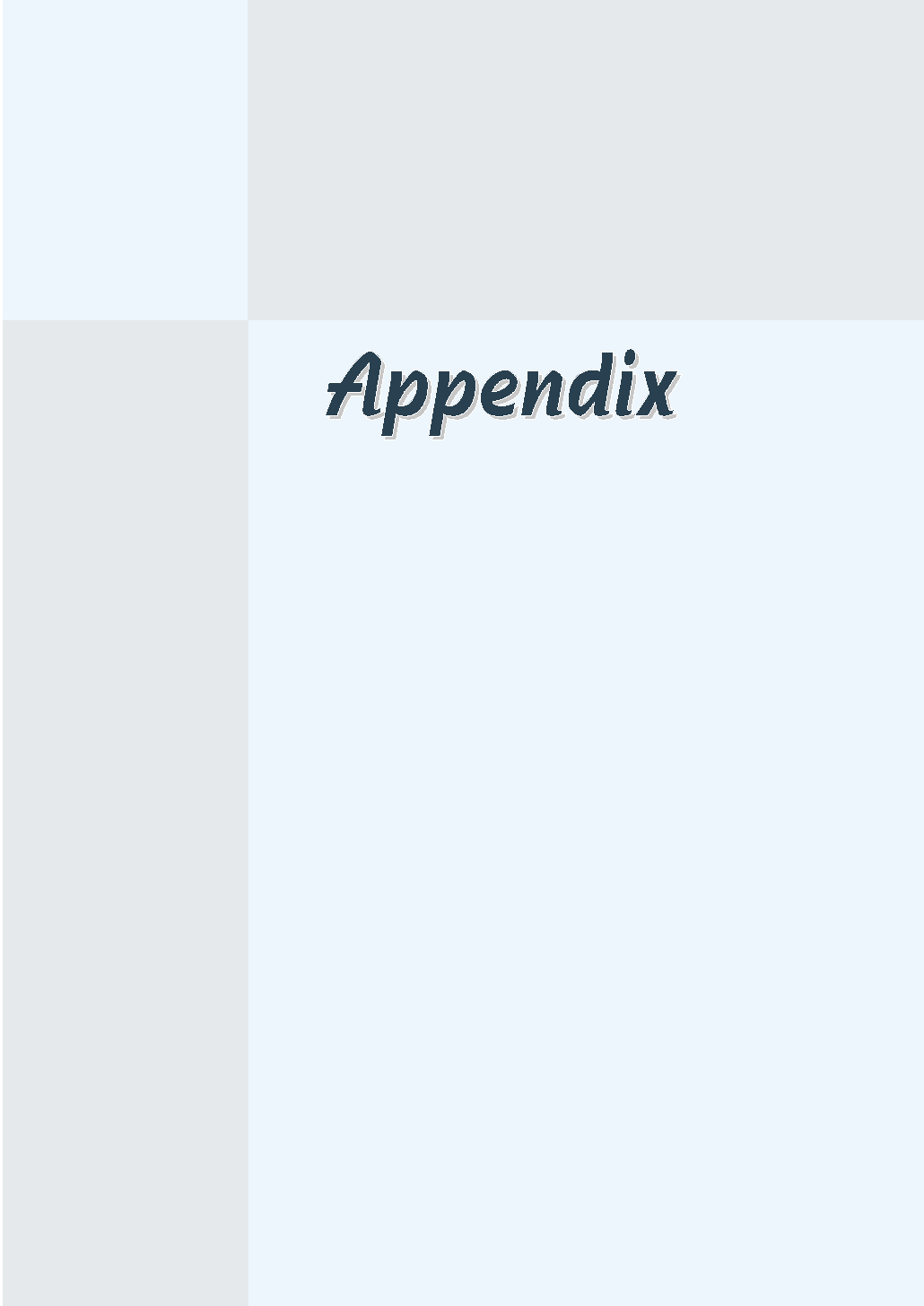
This appendix provides information on the following topics:
◆
Printer Specifications
◆
Paper Specifications
◆
Using Your Printer with a USB Cable
◆
Using Your Printer with Macintosh
◆
Printing from DOS applications
◆
Linux Driver Installation
◆
Installing Optional Memory Card
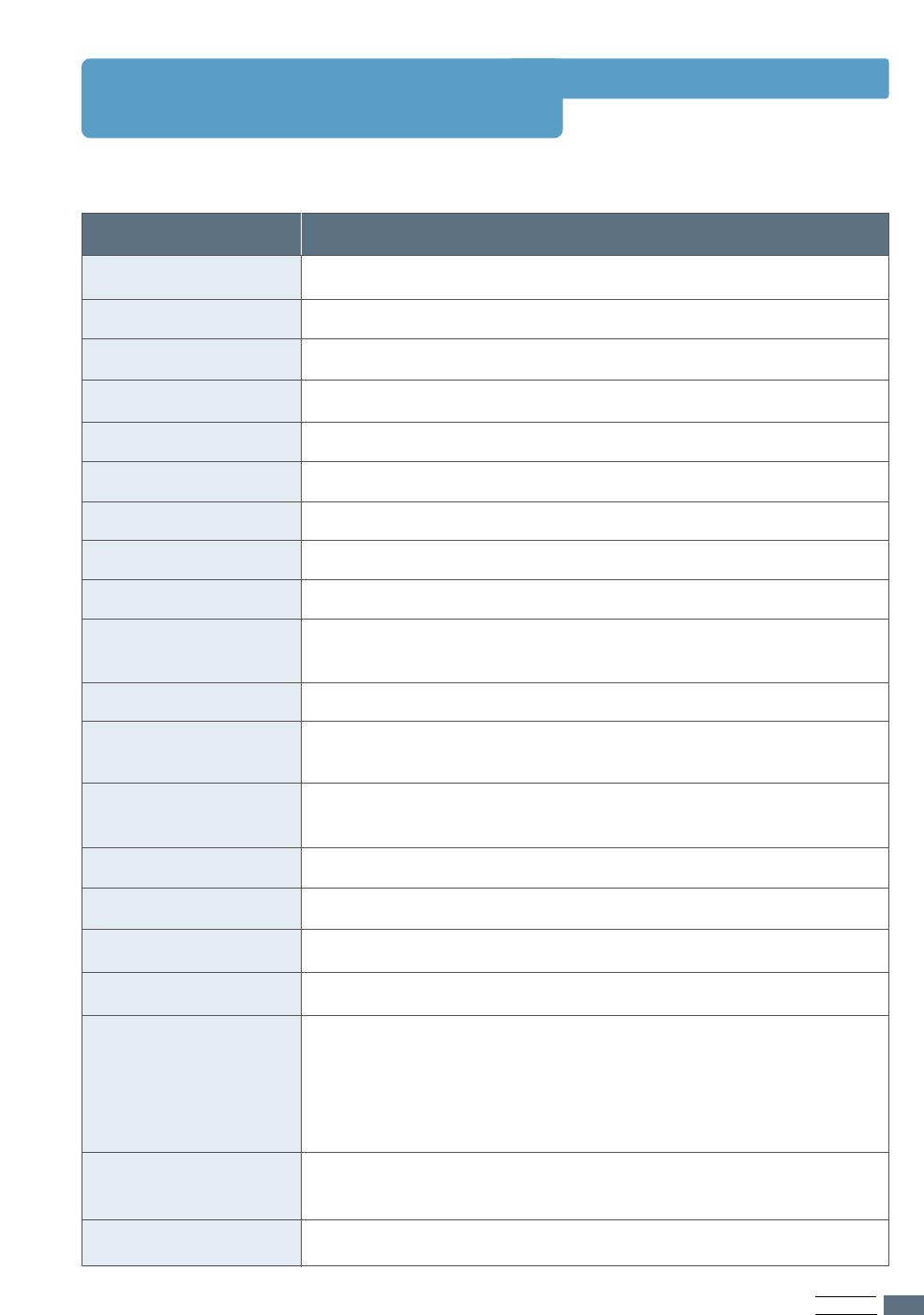
APPENDIX
A.1
Printer Specifications
Item Specification and Description
Print Speed
12 PPM
Resolution
1200 dpi class
First Printing Time
WarmUp Time
Less than 12.5 seconds
Power Consumption
250 W average during operation / Less than 10 W in sleep mode
Power Rating
AC 100 ~ 120 V (USA, Canada) / 220 ~ 240 V (Others), 50 / 60 Hz
Acoustic Noise
Stand by: Less than 35 dB; Operating: Less than 47 dB
Toner Supply
Single cartridge
Toner Cartridge Life
2,500 pages (for starter, 1,000 pages), 5% area coverage
Emulation
PCL 6
Random Access
Memory (RAM)
4 MB (expandable up to 68 MB)
30 seconds
Interface
•
12PPM (A4) Bidirectional Parallel Standard
- Modes supported: Compatible, Nibble, Byte, ECP
•
USB Interface Standard
- USB 1.0 compliant
- 12Mbps 1 port
Weight
6.5 Kg / 13.4 lb.
External Dimensions
(W x D x H)
329 x 355 x 231 mm / 12.95 x 13.98 x 9.09 in.
Temperature:10 ~ 32 °C / 50 ~ 90 °F; Humidity: 20 ~ 80 % RH
Package Weight
Paper: 1.83 Kg
Plastic: 0.33 Kg
Duty Cycle
Monthly: 12,000 pages maximum
Operating Environment
Interface Switching
Automatic (Parallel, USB)
Fonts
1 bitmap, 45 scalable
Fresh Time
1 K (1024 cycles/16 mS) / 2 K (2048 cycles/32 mS)

APPENDIX
A.2
Paper Specifications
This printer accepts a variety of media, such as cut-sheet
paper (including up to 100 % recycled fiber content paper),
envelopes, labels, transparencies and custom-size paper.
Properties such as weight, composition, grain and moisture
content are important factors affecting printer performance and
output quality. Paper that does not meet the guidelines
outlined in this manual can cause the following problems:
• Poor print quality
•
Increased paper jams
•
Premature wear on the printer, requiring repairs.
Overview
Notes:
• Some paper may meet all of the guidelines in this manual
and still not produce satisfactory results. This might be the
result of improper handling, unacceptable temperature and
humidity levels, or other variables over which Samsung has
no control.
• Before purchasing large quantities of paper, make sure that
the paper meets the requirements specified in this user
guide. Always test paper before buying large quantities.
CAUTION: Using paper that does not meet these
specifications may cause problems for the printer, requiring
repairs. This repair is not covered by the Samsung warranty
or service agreements.
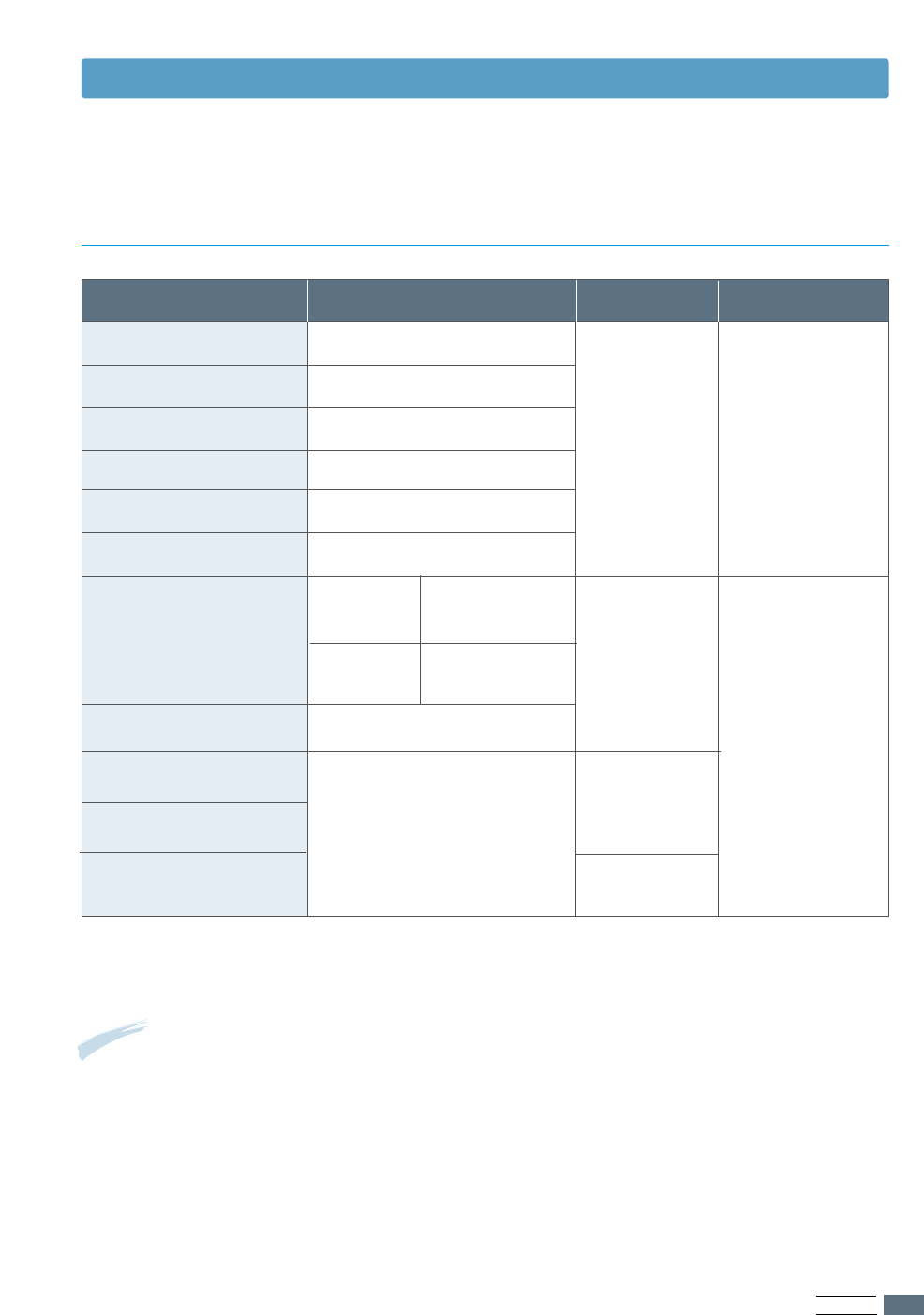
APPENDIX
A.3
Paper
Letter
Dimensions
8.5
✕
11 in. (
216
✕
279 mm
)
16 to 24 lb Bond
(60 to 105 g/m2)
• 150 sheets of 20 lb
Bond (75 g/m2)
paper for the
automatic input
tray
• 1 sheet of paper
for the manual
input tray
Weight Capacitya
A4
210
✕
297 mm (8.3 X 11.7 in.)
Executive
Legal
B5 (JIS)
Folio
7.3 X 10.5 in. (191 X 267 mm)
8.5
✕
14 in. (
216
✕
356 mm
)
182
✕
257 mm
(7.2
✕
10 in.)
216
✕
330 mm
(8.5
✕
13 in.)
Minimum Size
(custom)
95 X 127 mm
(3.8 X 5 in.)
76 X 127 mm
(3 X 5 in.)
Automatic
Input Tray
Manual
Input Tray
60 to 163 g/m2
Bond
(16 to 43 lb ) • 5 sheets of 20 lb
Bond (75 g/m2)
paper for the
automatic input
tray
• 1 sheet paper for
the manual input
tray
Maximum Size (custom)
216
✕
356 mm (8.5 X 14 in.)
Transparency
Labels
b
Envelopes
Same minimum and
maximum paper sizes as
listed above.
Thickness:
.10 X .14 mm
(0.0039 X
0.0055 in.)
up to 90 g/m2
(16-24 lb)
a. Capacity may vary depending on media weight and thickness, and environmental conditions.
b. Smoothness - 100 to 250 (Sheffield)
Supported Sizes of Paper
Note: You may experience some paper jams when using any media with a length of less than
127 mm (5 in.). For optimum performance, make sure you are storing and handling the paper
correctly. Please refer to “Printer and Paper Storage Environment” on page A.6.
Paper Specifications
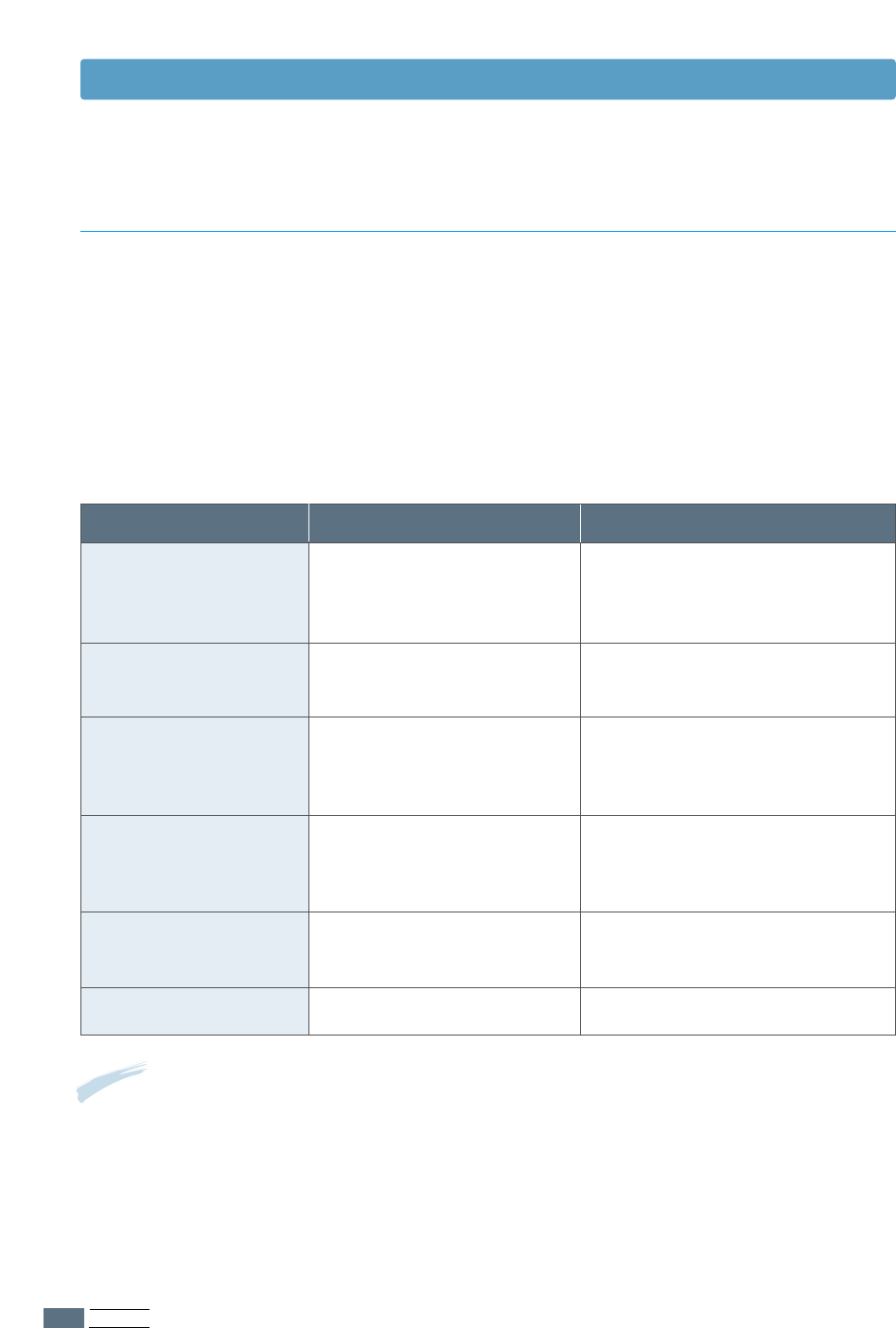
APPENDIX
A.4
Paper Specifications
For best results, use conventional 75 g/m
2
(20 lb) paper. Make sure the paper is of good
quality, and free of cuts, nicks, tears, spots, loose particles, dust, wrinkles, voids, and curled
or bent edges.
If you are unsure of what type of paper you are loading (such as bond or recycled), check the
label on the package of the paper.
The following problems with paper cause print quality deviations, jamming, or even damage
to the printer.
Symptom
Poor print quality or
toner adhesion
Problems with feeding
Dropout, jamming,
curl
Increased gray
background shading
/printer wear
Excessive curl
problems with feeding
Jamming, damage to
printer
Problems with feeding
Problem with Paper
Too moist, too rough, too
smooth, or embossed;
faulty paper lot
Stored improperly
Too heavy
Too moist, wrong grain
direction or short-grain
construction
Cutouts or perforations
Ragged edges
Solution
Try another kind of paper,
between 100 ~ 250 Sheffield,
4 ~ 5 % moisture content.
Store paper flat in its moisture-
proof wrapping.
Use lighter paper, open the rear
output tray.
• Open the rear output tray.
• Use long-grain paper.
Do not use paper with cutouts or
perforations.
Use good quality paper
Notes:
• Do not use letterhead paper that is printed with low-temperature inks, such as those used in
some types of thermography.
• Do not use raised or embossed letterhead.
• The printer uses heat and pressure to fuse toner to the paper. Make sure that any colored
paper or preprinted forms use inks that are compatible with this fusing temperature (200 °C or
392 °F for 0.1 second).
Guidelines for Using Paper
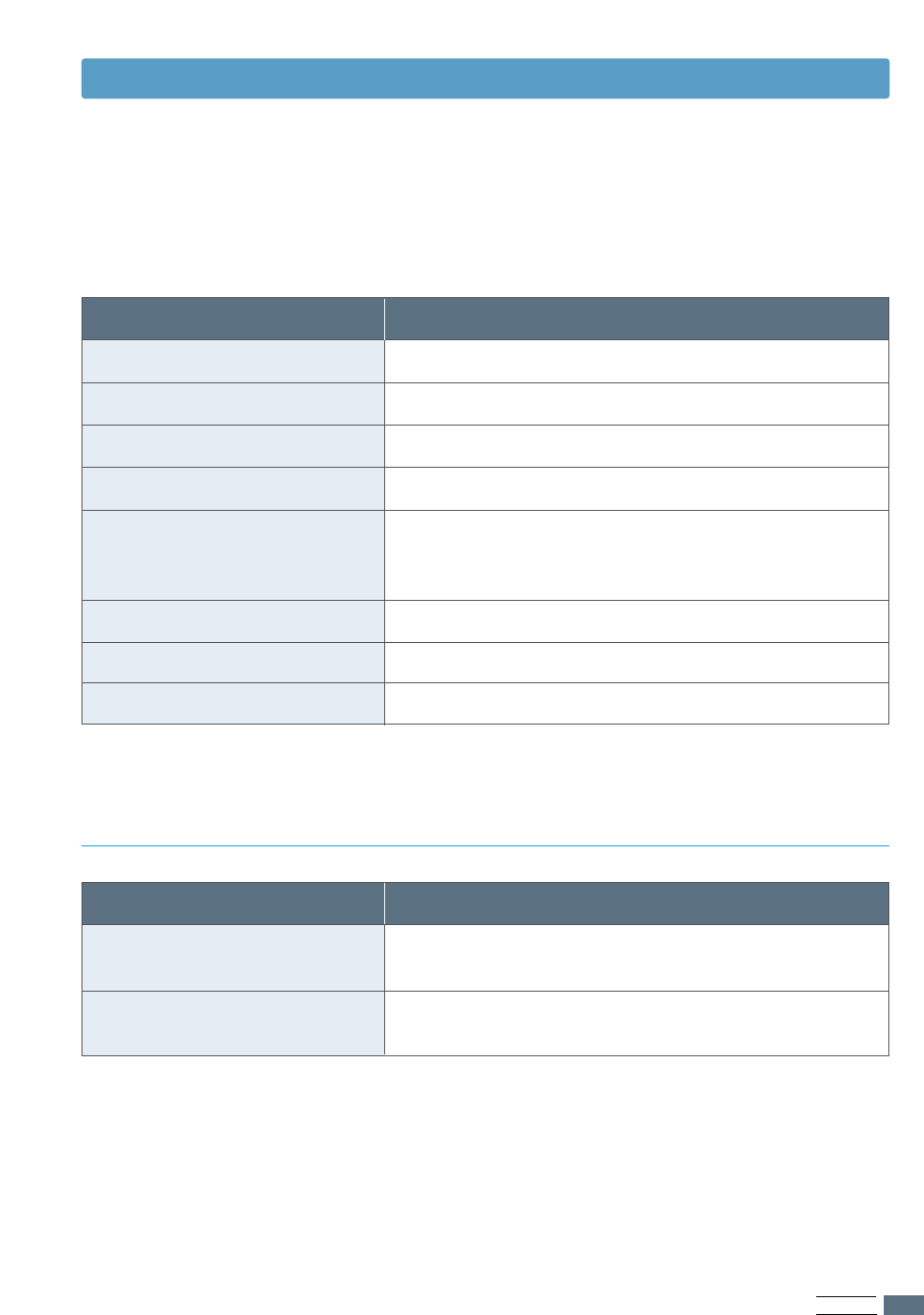
APPENDIX
A.5
Paper Specifications
Category
Acid Content
Specifications
5.5 ~ 8.0 pH
Caliper
.094 ~ .18 mm (3.0 ~ 7.0 mils)
Curl in Ream
Cut Edge Conditions
Fusing Compatibility
Grain
Flat within 5 mm (.02 in.)
Cut with sharp blades with no visible fray.
Moisture Content
4 % ~ 6 % by weight
Smoothness
100 ~ 250 Sheffield
Must not scorch, melt, offset, or release hazardous
emissions when heated to 200 °C (392 °F) for .1
second.
Long Grain
Paper Specifications
Output Tray
Face-down output tray
Capacity
100 sheets of 20 lb bond (75 g/m2) paper
Face-up output slot
1 sheet of 20 lb bond (75 g/m2) paper
Paper Output Capacity

APPENDIX
A.6
Ideally, the printer and paper storage environment should be
at or near room temperature, and not too dry or humid.
Remember that paper absorbs and loses moisture rapidly.
Heat works with humidity to damage paper. Heat causes the
moisture in paper to evaporate, while cold causes it to
condense on the sheets. Heating systems and air conditioners
remove most of the humidity from a room. As paper is opened
and used, it loses moisture, causing streaks and smudging.
Humid weather or water coolers can cause the humidity to
increase in a room. As paper is opened and used it absorbs
any excess moisture, causing light print and dropouts. Also, as
paper loses and gains moisture it can distort. This can cause
paper jams.
As a result, paper storage and handling are as important as
the paper-making process itself. Paper storage environmental
conditions directly affect the feed operation.
Care should be taken not to purchase more paper than can be
easily used in a short time (about 3 months). Paper stored for
long periods may experience heat and moisture extremes,
which can cause damage. Planning is important to prevent
damage to large supply of paper.
Unopened paper in sealed reams can remain stable for several
months before use. Opened packages of paper have more
potential for environment damage, especially if they are not
wrapped with a moisture-proof barrier.
The paper storage environment should be properly maintained
to ensure optimum printer performance. The required condition
is 20 ° to 24 °C (68° to 75 °F), with a relative humidity of
45 % to 55 %. The following guidelines should be helpful when
evaluating the paper’s storage environment:
• Paper should be stored at or near room temperature.
• The air should not be too dry or too humid (due to the
hygroscopic properties of paper).
• The best way to store an opened ream of paper is to rewrap it
tightly in its moisture-proof wrapping. If the printer
environment is subject to extremes, unwrap only the amount
of paper to be used during the day’s operation to prevent
unwanted moisture changes.
Paper Specifications
Printer and Paper Storage Environment
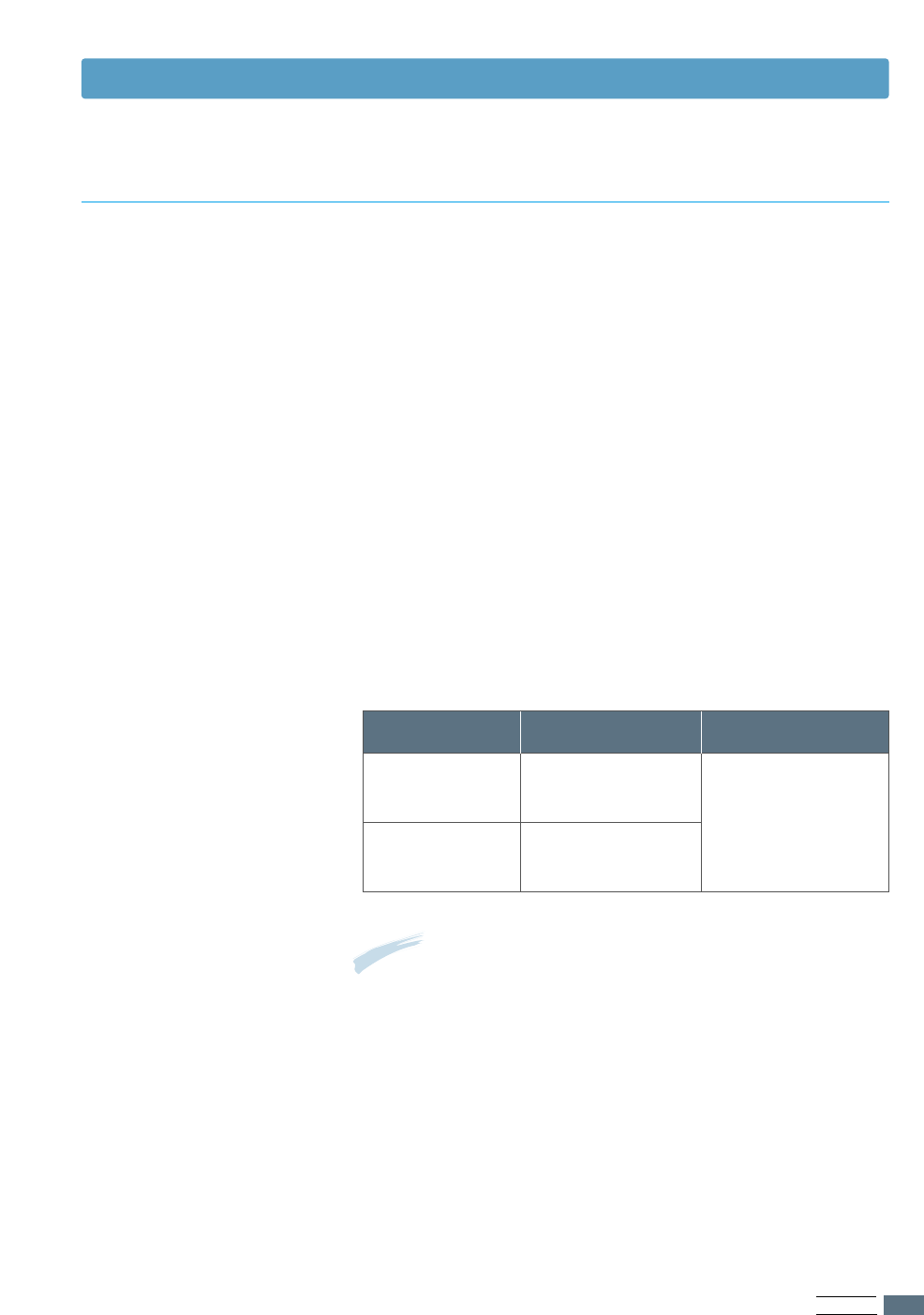
APPENDIX
A.7
Envelope construction is critical. Envelope fold lines can vary
considerably, not only between manufacturers, but also within
a box from the same manufacturer. Successful printing on
envelopes depends upon the quality of the envelopes. When
selecting envelopes, consider the following components:
• Weight: The weight of the envelope paper should not exceed
90 g/m
2
(24 lb) or jamming may occur.
• Construction: Prior to printing, envelopes should lie flat with
less than 6 mm (0.25 in.) curl, and should not contain air.
• Condition: Envelopes should not be wrinkled, nicked, or
otherwise damaged.
• Temperature: You should use envelopes that are compatible
with the heat and pressure of the printer.
• Size: You should use only envelopes within the following size
ranges.
Minimum Maximum
216 X 356 mm
(8.5 X 14 in.)
76 X 127 mm
(3 X 5 in.)
95 X 127mm
(3.8 X 5 in.)
Automatic input
tray
Manual input tray
Note: You may experience some paper jams when using any
media with a length of less than 127 mm (5 in.). This may be
caused by paper that has been affected by environmental
conditions. For optimum performance, make sure you are
storing and handling the paper correctly. Please refer to
“Printer and Paper Storage Environment” on page A.6.
Paper Specifications
Envelopes
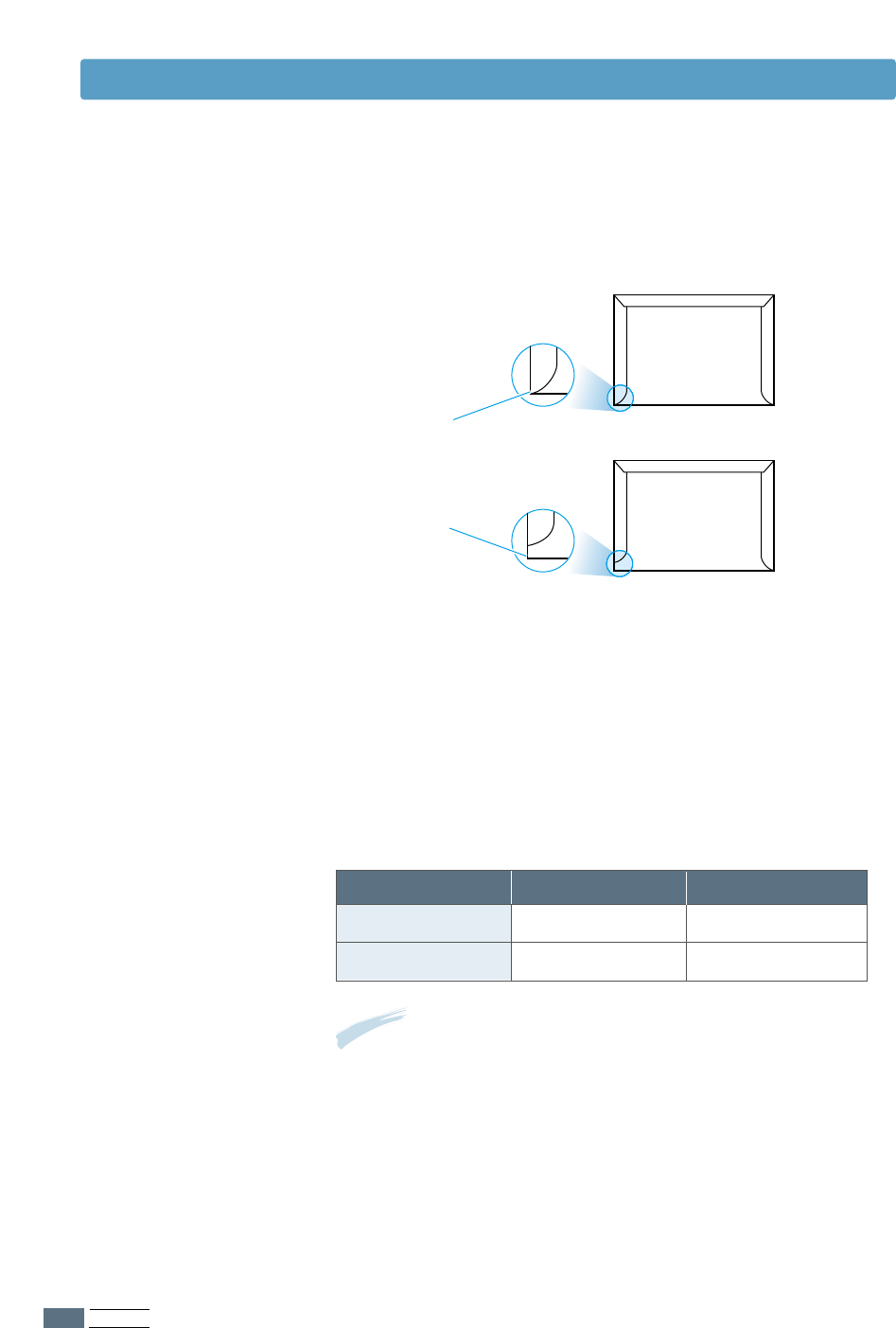
APPENDIX
A.8
Double side-seams construction has vertical seams at both ends
of the envelope rather than diagonal seams. This style may be
more likely to wrinkle. Be sure the seam extends all the way to
the corner of the envelope as illustrated below.
Envelopes with Double
Side Seams
Envelopes with a peel-off adhesive strip or with more than one
flap that folds over to seal must use adhesives compatible with
the heat and pressure in the printer. The extra flaps and strips
might cause wrinkling, creasing, or even jams and may even
damage the fuser.
Envelopes with
Adhesive Strips or Flaps
The following gives typical address margins for a commercial
#10 or DL envelope.
Envelope Margins
Proper storage of envelopes helps contribute to print quality.
Envelopes should be stored flat. If air is trapped in an envelope,
creating an air bubble, then the envelope may wrinkle during
printing. See “Printing on Envelopes” on page 4.7.
Envelope Storage
Correct
Incorrect
Minimum
Type of Address
Return address
Delivery address
Maximum
15 mm (0.6 in.)
15 mm (0.6 in.)
89 mm (3.5 in.)
51 mm (2 in.)
Notes:
• For best print quality, position margins no closer than 15 mm
(0.6 in.) from the edges of the envelope.
• Avoid printing over the area where the envelope’s seams
meet.
Paper Specifications

APPENDIX
A.9
When selecting labels, consider the quality of each component:
• Adhesives: The adhesive material should be stable at
200 °C (392 °F), the printer’s fusing temperature.
• Arrangement: Only use labels with no exposed backing
between them. Labels can peel off sheets with spaces
between the labels, causing serious jams.
• Curl: Prior to printing, labels must lie flat with no more than
13 mm (.5 in.) of curl in any direction.
• Condition: Do not use labels with wrinkles, bubbles, or other
indications of separation.
See “Printing on Labels” on page 4.10.
Transparencies used in the printer must be able to withstand
200 °C (392 °F), the printer’s fusing temperature.
See “Printing on Transparencies” on page 4.11.
CAUTION: To avoid damaging the printer, use only
transparencies recommended for use in laser printers.
CAUTIONS:
• To avoid damaging the printer, use only labels
recommended for laser printers.
• To prevent serious jams, always use the face-up output slot.
• Never print on the same sheet of labels more than once or
print on a partial sheet of labels.
Paper Specifications
Labels
Transparencies
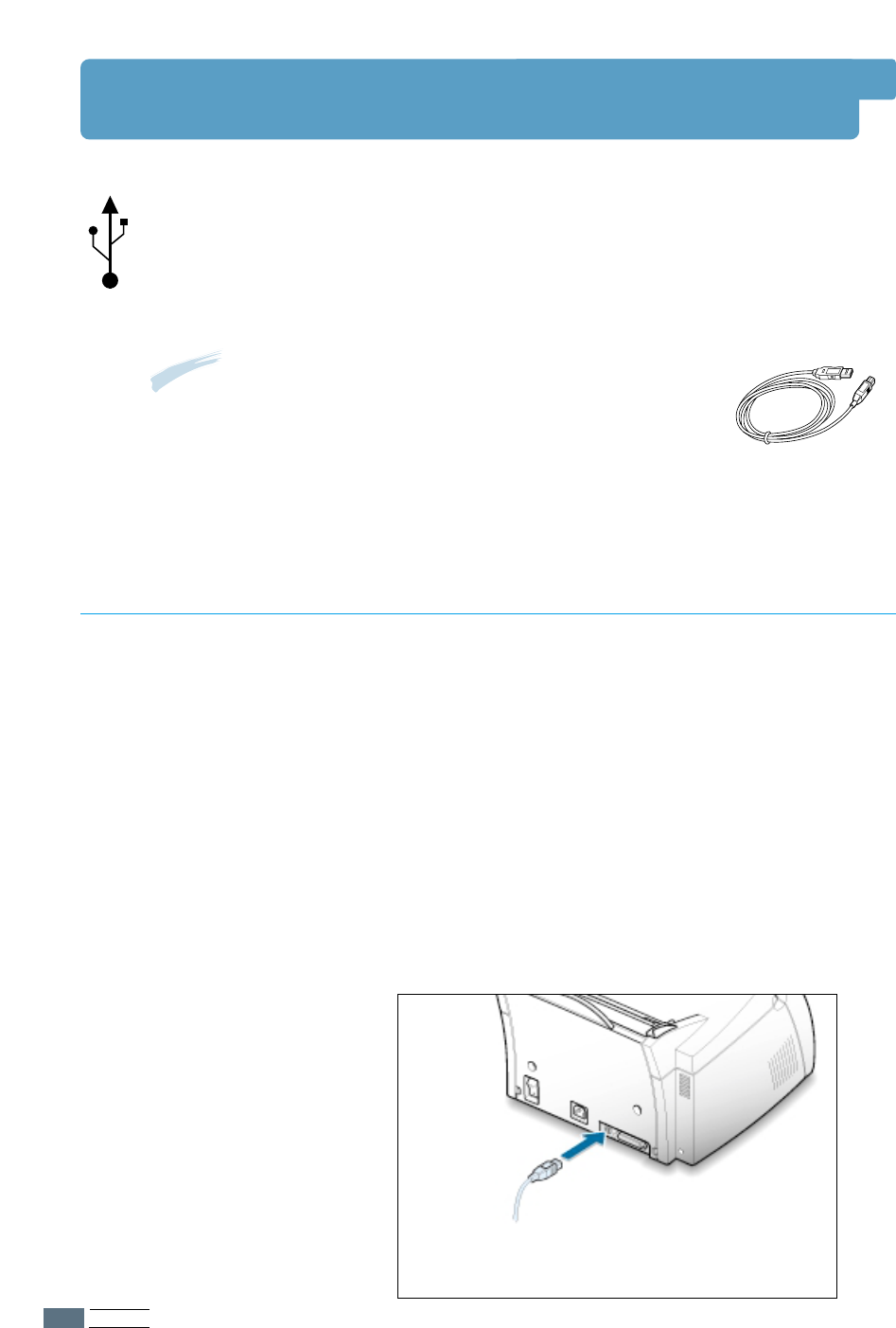
APPENDIX
A.10
Using Your Printer with a USB Cable
To operate your printer with a Windows PC, you must install the
PCL 6 printer driver. Place the CD-ROM in the CD-ROM drive
and perform the instructions on page 2.8.
If you have a USB (Universal Serial Bus) port enabled on your computer, and if
your computer is running Windows 98, you can connect your ML-1250 printer to
the USB chain of devices.
1
Make sure that both the printer and computer are turned
ON.
2
Plug one end of the USB cable into the USB port on the
printer.
2. Connect printer with
USB cable and
install USB driver
1. Install PCL 6 driver
Installing the Printer Software
To the USB port
on PC
➜
Note: To connect the printer to the USB port of the
computer requires a certified USB cable.
You will need to buy the USB 1.0 compliant cable.
And the length should be less than three meters.
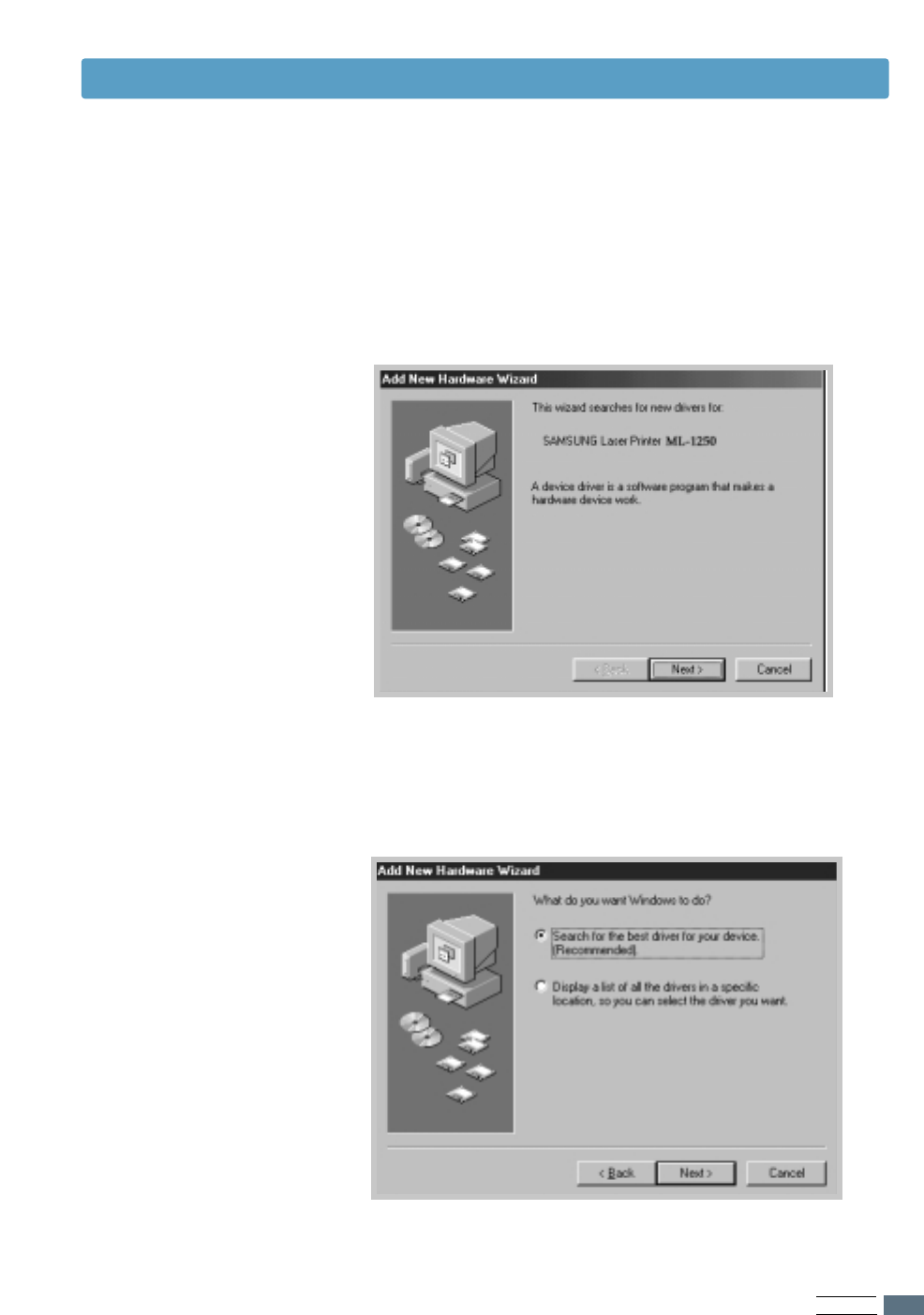
APPENDIX
A.11
Using Your Printer with a USB Cable
3
Plug the other end into the USB port on the computer.
4
The Add New Hardware Wizard dialog box appears. Click
Next.
5
Check Search for the best driver for your device and click
Next.
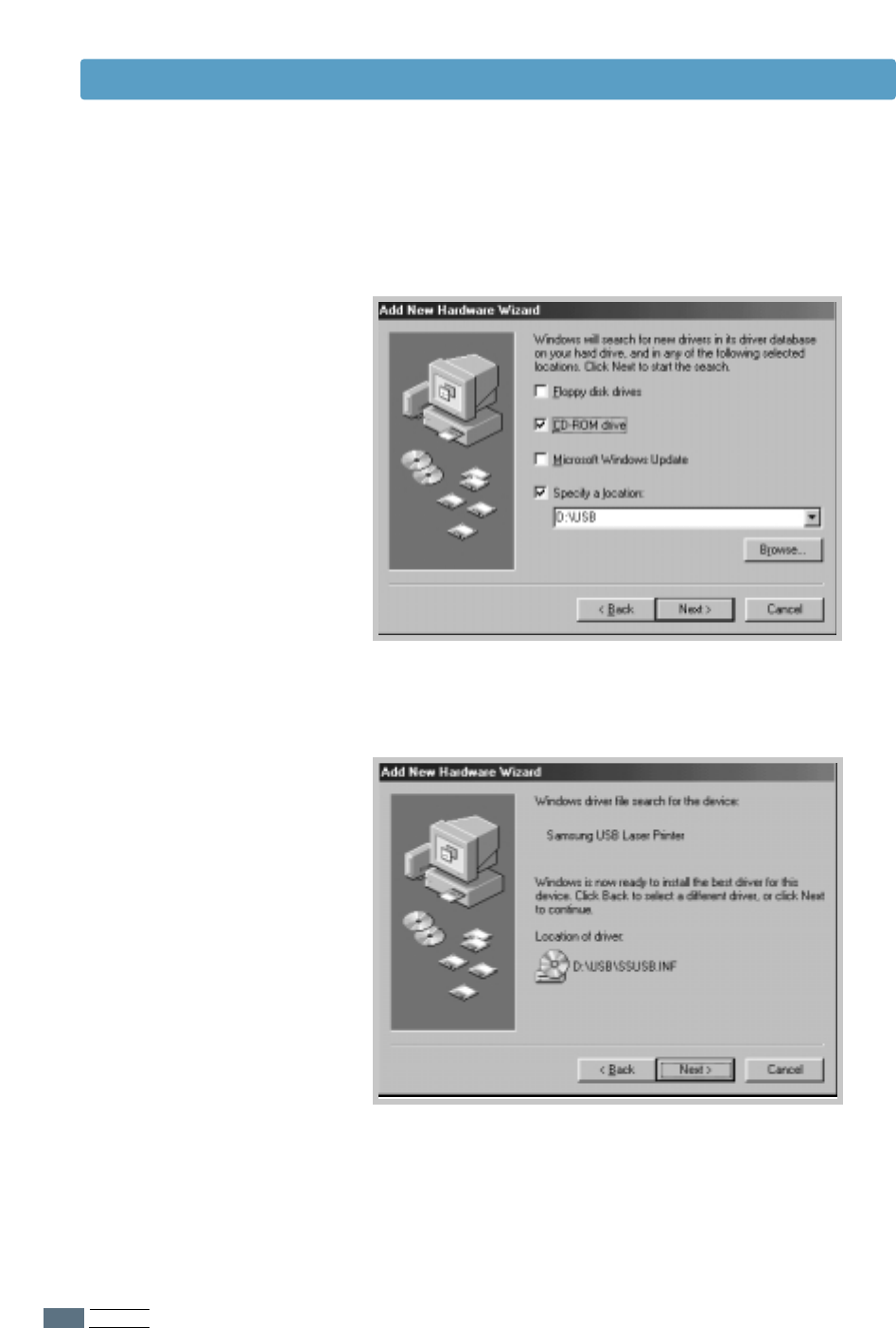
APPENDIX
A.12
Using Your Printer with a USB Cable
7
Click Next. The USB driver will be installed.
8
Follow the instructions on the screen to complete the
installation.
6
Check CD-ROM drive and click Browse, then choose D:\USB
(where Dis the drive letter for the CD-ROM drive).
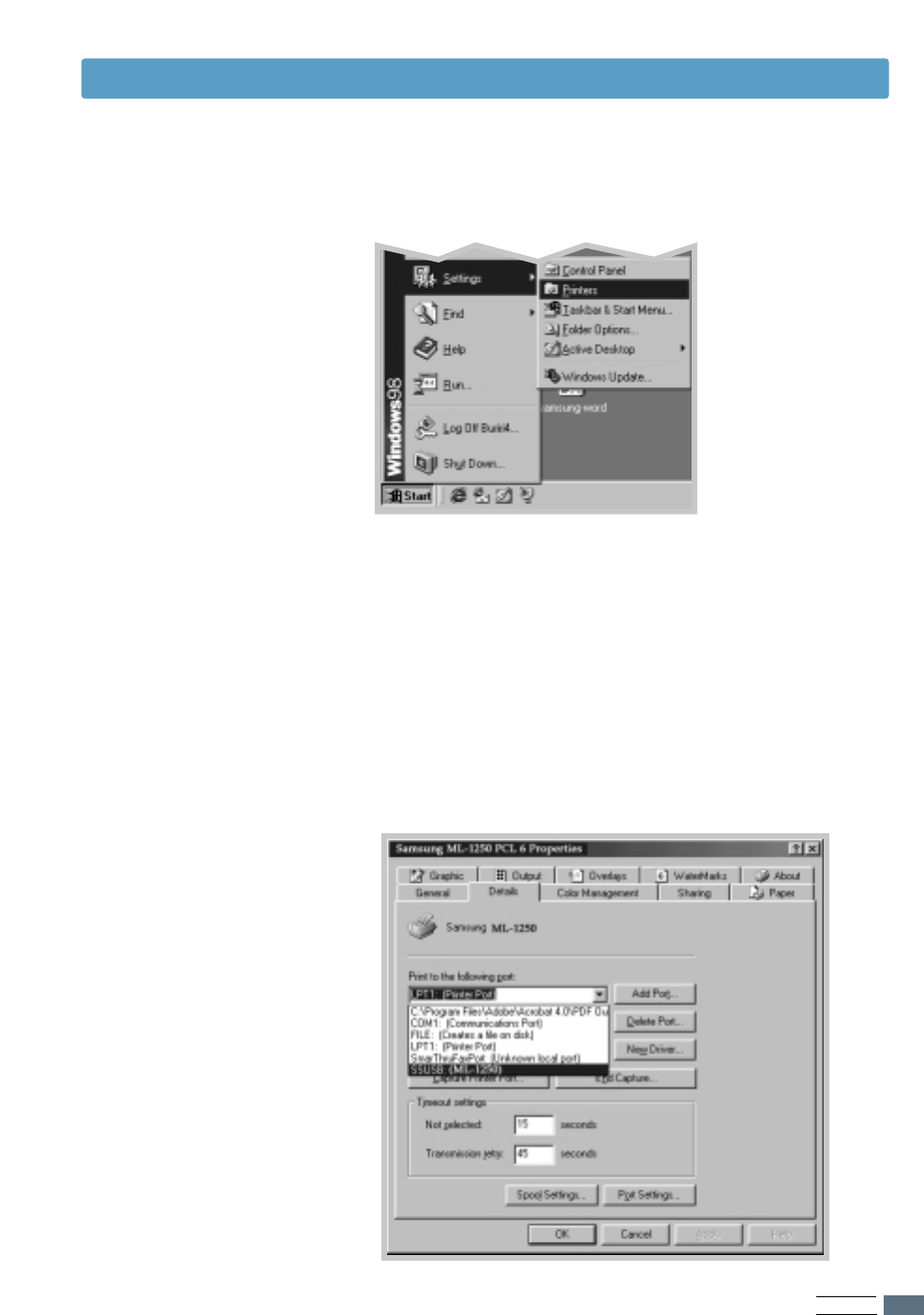
APPENDIX
A.13
Using Your Printer with a USB Cable
1
From the Start menu, select Settings, then select Printers.
2
Select the Samsung ML-1250 PCL 6 printer icon in the
Printers folder.
3
Select Properties from the File menu.
4
Click the Details tab. Select SSUSB: (ML-1250) in the
Print to the following port box. Click OK. The setup is
now completed.
3. Set your PC printer
port

APPENDIX
A.14
Frequently Asked Questions About USB
Using Your Printer with a USB Cable
Q
Q
Q
Q
What is USB?
How can I determine if my computer’s USB port is enabled?
A
A
Universal Serial Bus (USB) makes it easy to connect devices to
your computer without having to open your PC. USB uses a
standard port and plug combination for connecting devices like
printers, modems, scanners, and digital cameras. It also offers
the benefit of being able to easily add, remove, and move
devices.
Because USB is a relatively new technology, we recommended
using a parallel printing connection. However, USB is an option
to customers who want to print from Windows 98 across the
USB cable. If your computer’s USB port is enabled and properly
setup, you can connect your printer to it or to a chain of USB
devices via a USB cable.
1
1
In Windows 98, select Start ➝ Settings ➝ Control Panel.
2
Double-click the System icon.
3
Click the Device Manager tab.
4
Click the plus (+) icon before the Universal Serial Bus
Controller item.
If you see a USB host controller and a USB root hub listed, USB
is properly enabled. If you have multiple hubs on the USB chain,
try connecting your printer to a different hub or to another USB
device. Also, make sure the cable connections are firm. (USB
hubs are hardware devices into which you can plug multiple USB
cables.)
If you do not see these devices listed, refer to your computer’s
documentation or contact the manufacturer for more
information on enabling and setting up USB. Remember, you can
always use a parallel cable to connect your printer’s parallel port
to your computer. (If you decide to switch to a parallel cable
connection, you may need to remove and reinstall the printer
software. )
A
A
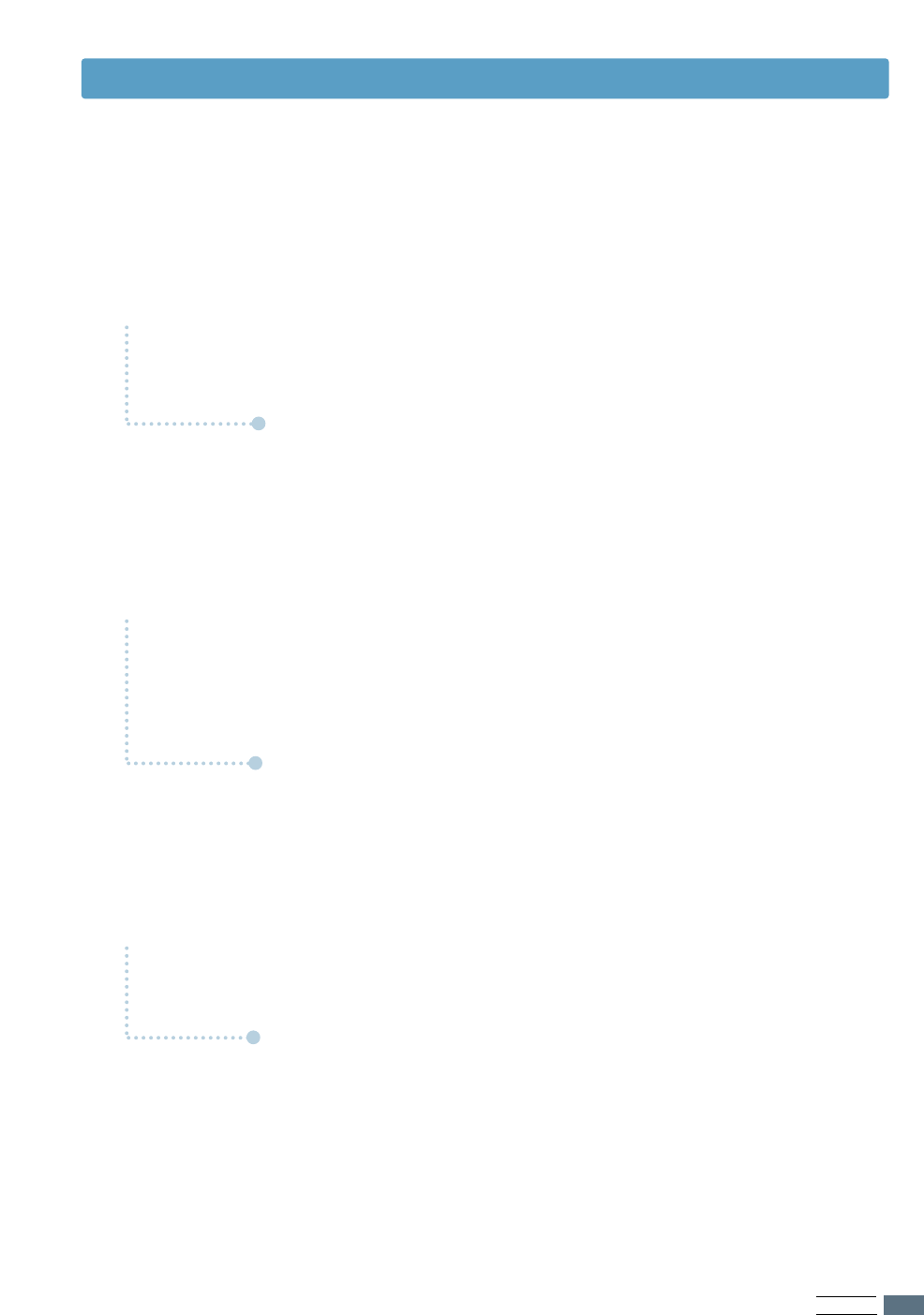
APPENDIX
A.15
Using Your Printer with a USB Cable
Q
Q
Q
Q
Q
Q
Can other users on my USB chain print to my ML-1250 printer on
the USB chain?
Yes. Windows 98 allows you to “share” your printer using
software settings on your computer. After others on the USB
chain have installed the printer software for your specific printer,
they can print to your shared printer.
After I install my printer, why isn’t my ML-1250 printer assigned to
an LPT printer port in the Print dialog box of my software
application?
USB uses a different naming convention for USB devices. After
the printer has been installed, you see SSUSB:(your printer
name) instead of LPT.
How can I increase printing speed and quality?
When operated on a USB chain, your printer may become
slower if other USB devices are being used while you’re printing.
For optimal print performance, avoid using other devices in the
USB chain while printing.
A
A
A
A
A
A

APPENDIX
A.16
Your printer supports Macintosh system with a built-in USB
interface. When you print a file from Macintosh, you can use the
PCL driver to support your printer’s major printing features.
Using Your Printer with Macintosh
To use your ML-1250 printer and its software with a Macintosh,
your system should have:
Macintosh Hardware Requirement:
• One of the following Macintosh models:
-Power Macintosh series (with external network connection)
-Power Macintosh G3, G4
-iMac series
-PowerBook series
-iBook series
• USB interface
Macintosh System Requirement:
System 8.0 or later
System Requirements
You can connect the printer to your Macintosh using the USB
interface.
1
Turn off the printer and computer.
Installing Software for Macintosh
Connecting to
Macintosh
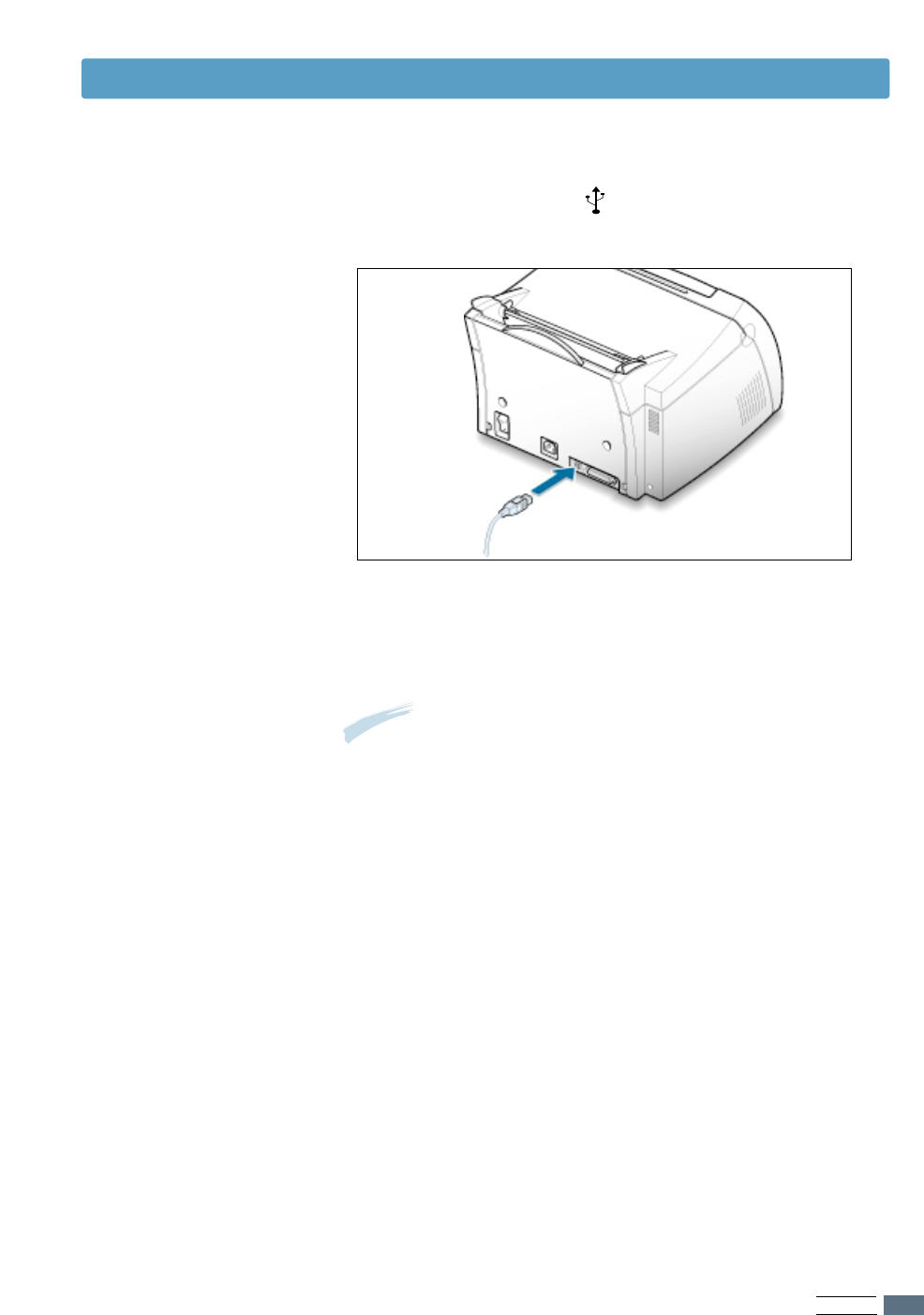
APPENDIX
A.17
2
Hold the USB cable so the icon faces up and connect it to
your printer’s USB connector.
3
Connect the other end of the cable to an available USB port
on your Macintosh computer. If you have any connecting
problems, please refer to your computer documentation.
Note: If you are using a USB hub, connect the printer’s cable to
the first tier of the hub or the printer may malfunction. If
the printer doesn’t work with the hub, connect it directly to
the USB port.
Using Your Printer with Macintosh
Installing Software
1
Turn on your computer and printer.
2
Insert the CD-ROM which came with your printer into the CD-
ROM drive.
3
Double-click the Samsung ML-1250 on your Macintosh
desktop.
4
Select the correct language, then click Continue.
5
Click Install.
6
After installation is complete, click Quit.

APPENDIX
A.18
Using Your Printer with Macintosh
When you print with a Macintosh, you need to check the printer
software setting in each application you use. Follow these steps
to print from a Macintosh:
1
Open a Macintosh application and select a file you want to
print.
2
Open the File menu, and click Page Setup (Document
Setup in some applications). You see the Page Setup dialog
box.
Printing from a Macintosh
Choosing PCL Driver
1
From the Apple menu, select Chooser.
2
From the left pane of the Chooser window, click SAMSUNG
PCL. Then the Samsung printer name will appear in the right
pane of the Chooser window.
3
Click the Samsung PCL driver, and close the Chooser window.
4
You see the message box indicating that you have changed
your current printer. Click OK.
5
Then you see the Samsung PCL printer icon is created as a
desktop printer.
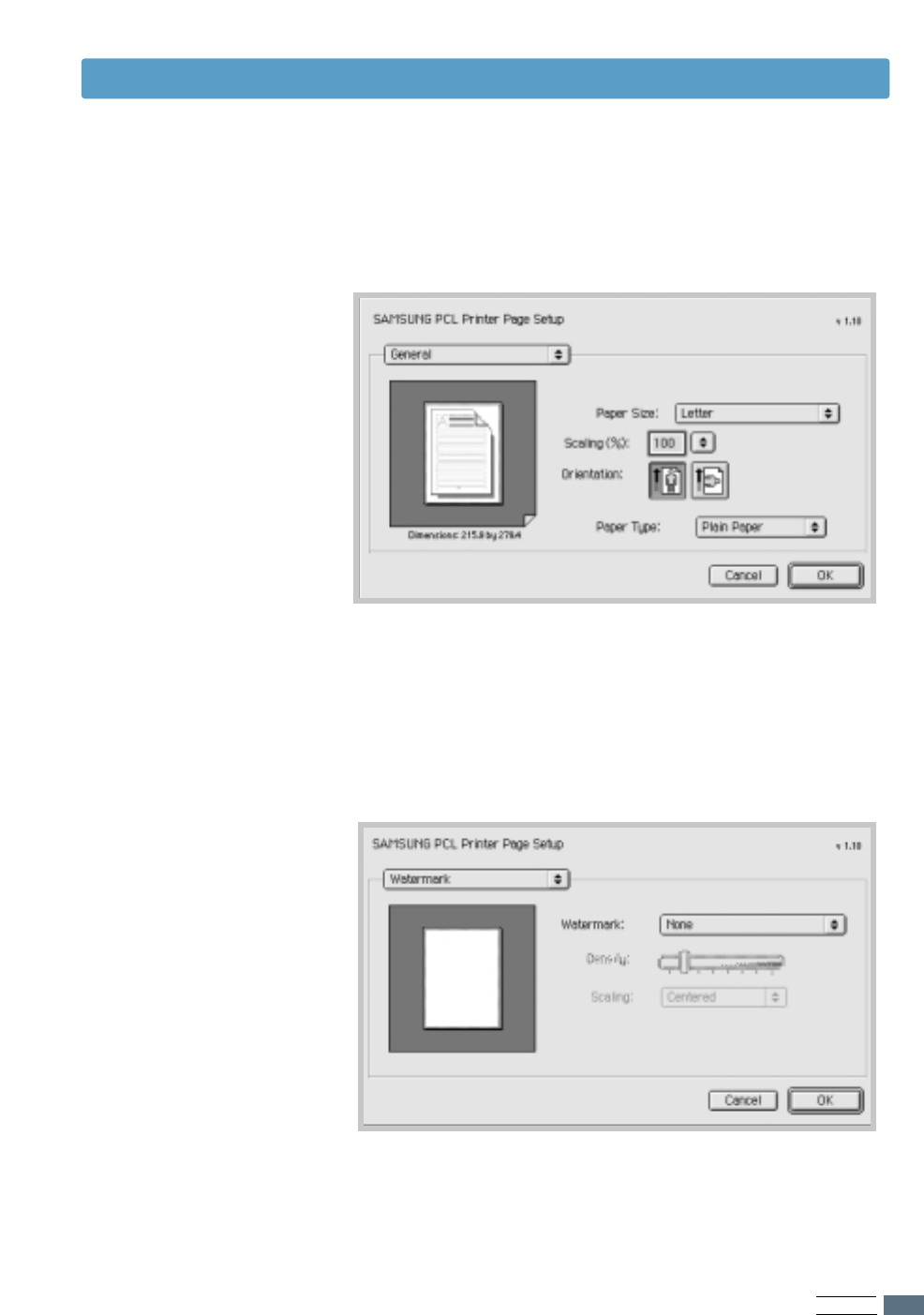
APPENDIX
A.19
Using Your Printer with Macintosh
Choose Watermark if you want to add a watermark to each
page in your document to emphasize its purpose or indicate
how it should be handled. For details on the watermark
option, see page 5.14.
3
Choose your paper size, orientation, paper type and other
options and click OK.
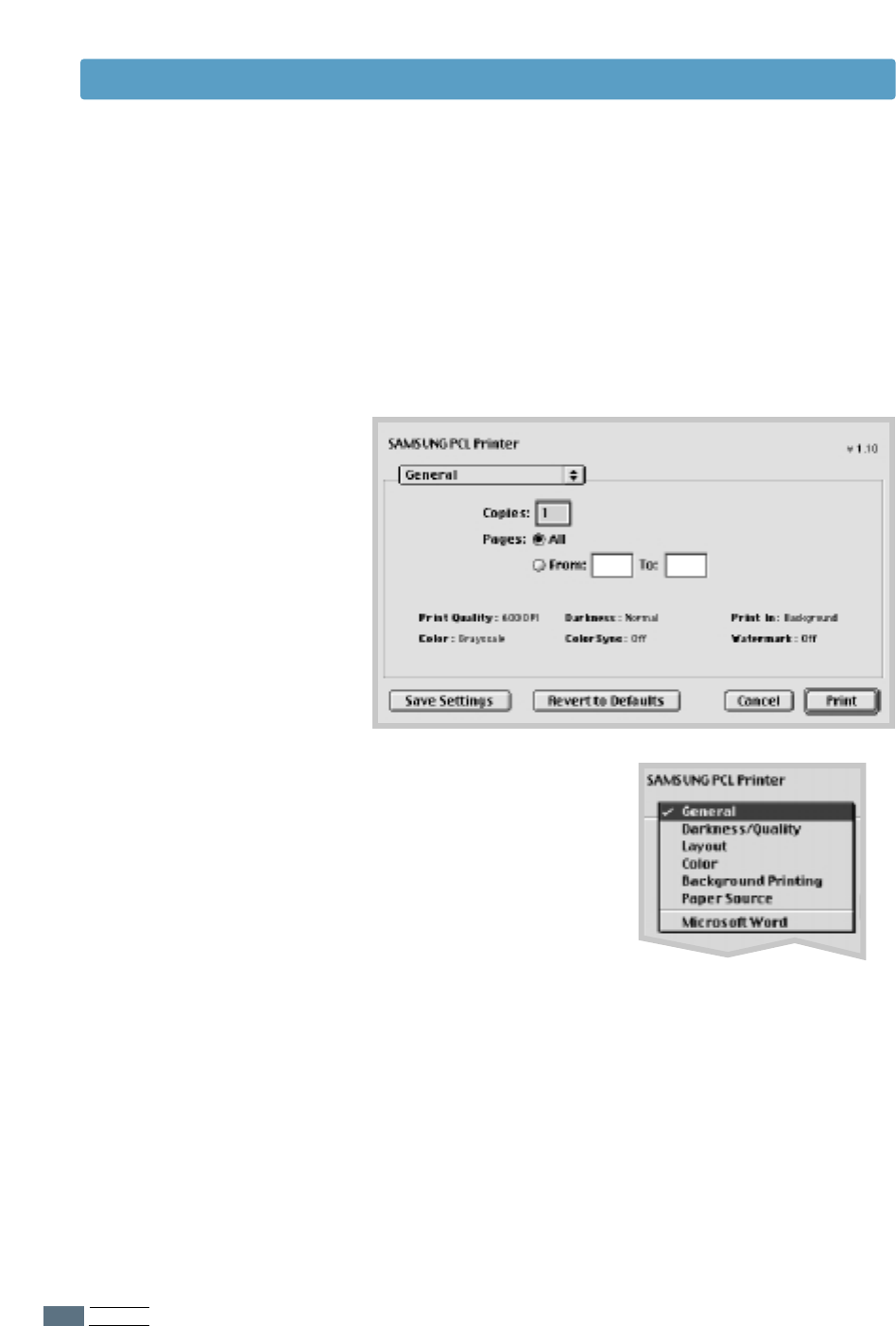
APPENDIX
A.20
Using Your Printer with Macintosh
4
Now open the File menu and click Print. You see the main
printer settings dialog box.
5
Choose the number of copies and indicate which pages you
want to print. For advanced printing features, select the
desired option. For details, see page A.21.
6
Click Print when you are finished checking your settings.
Select the desired option for
advanced printing features.
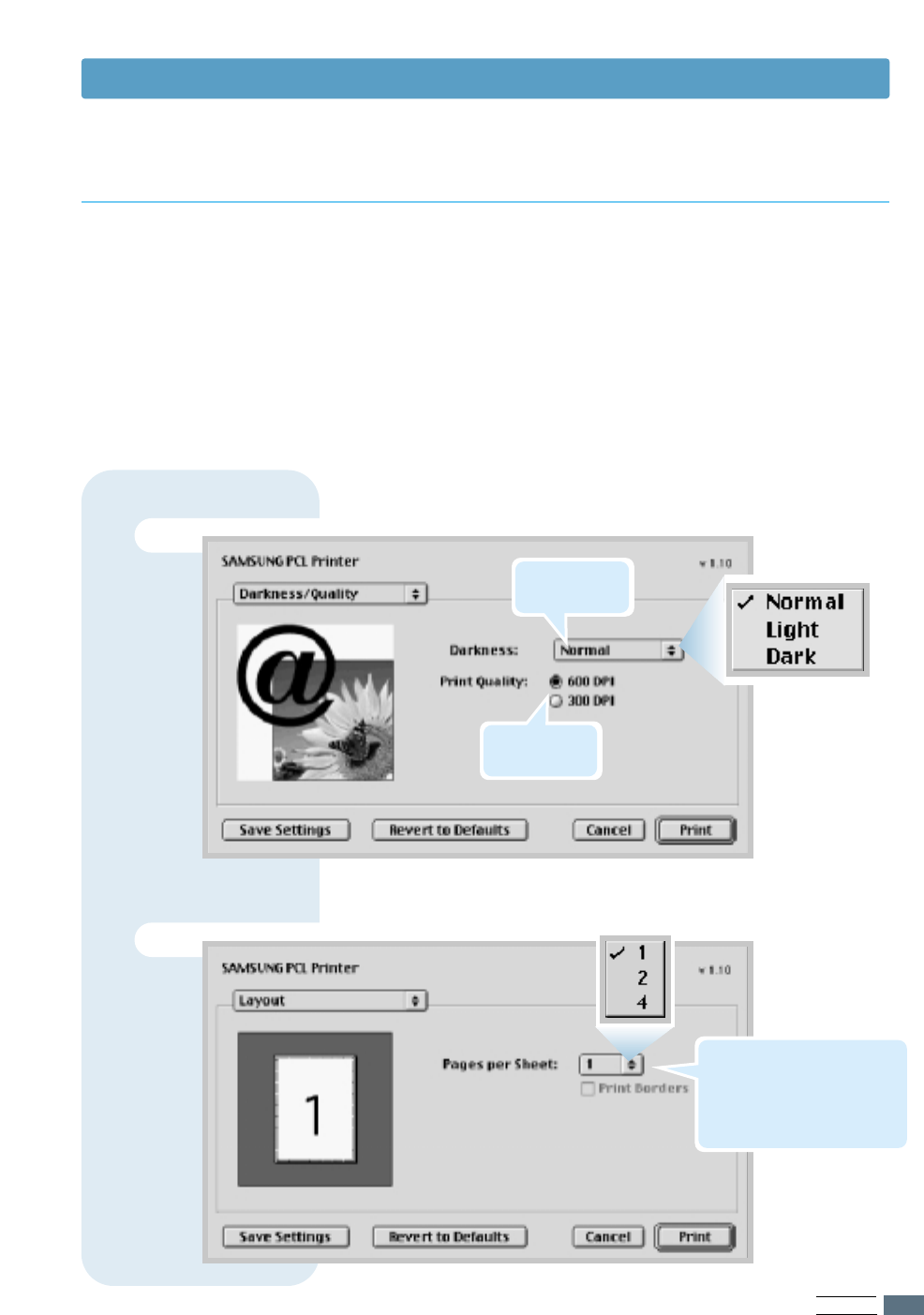
APPENDIX
A.21
Using Your Printer with Macintosh
The Page Setup dialog box contains five categories of page
setup properties. Listed below is the name of each property.
-Darkness/Quality
-Layout
-Color
-Background Printing
-Paper Source
Figures below display each property in the Page Setup dialog
box.
Advanced Printing
Darkness/Quality
Layout
Select print
resolution.
Select the number of pages
you want to print on one
sheet of paper. The pages
will appear decreased in size
and arranged on the sheet.
Select print
darkness.
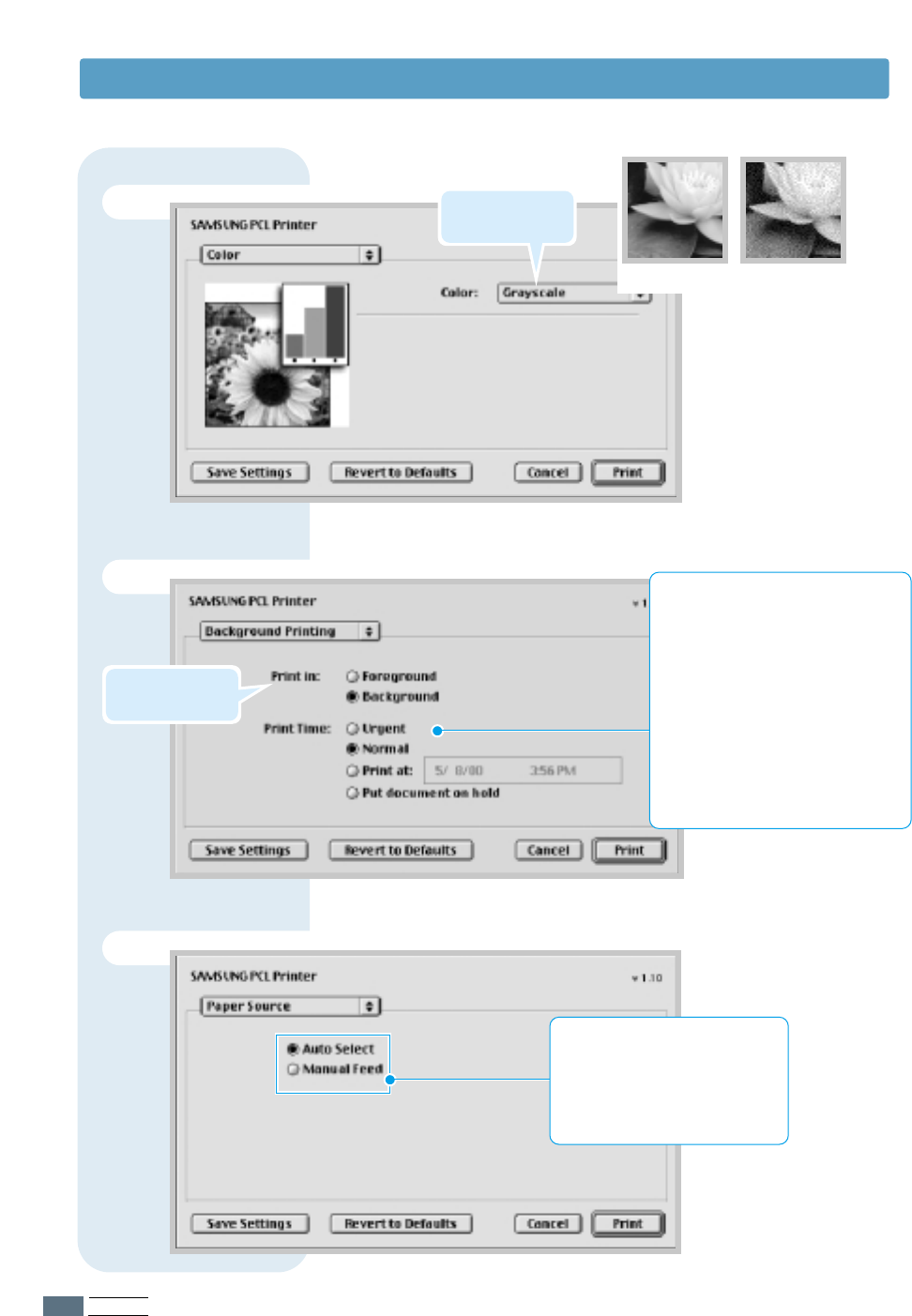
APPENDIX
A.22
Color
Background Printing
➐Grayscale ➐Black&White
Select a priority for your print job in
the queue of jobs waiting to print,
click one of the following:
• Normal to print in the order the
job is received.
• Urgent to print before any
Normal priority job.
• Print at: to print at the specific
time you enter in the day and
time in the fields to the right.
• Put document on hold to hold
the print job in the print queue
until you are ready to release it.
Paper Source
Select the corresponding paper
source. If Auto Select is set, the
printer automatically selects the
print media according to the
following order: Manual Tray, Auto
Tray.
Select grayscale
mode.
Turns background
printing on or off.
Using Your Printer with Macintosh

APPENDIX
A.23
While your printer is primarily a Windows printer, you can also
print from a DOS software program using the Remote Control
Panel utility provided in the ML-1250 CD-ROM.
Printing from DOS Applications
DOS users have access to many printer features through
specific DOS printer drivers; however, many software
manufactures do not develop printer drivers for their software
programs. The Samsung ML-1250 printer provides the DOS
software control panel for improved printer control when DOS
printer drivers are not available or when certain print settings
are not available through DOS software programs.
Notes:
• ML-1250 printer’s Remote Control Panel for DOS can be used
when the printer is connected via the parallel interface.
• The ML-1250 printer’s Remote Control Panel is not a printer
driver. It should be used to set print settings that are not
available through DOS software programs. Printer drivers are
supplied by the manufacturers of your DOS software programs.
If your DOS software program does not include a printer driver
for your Samsung printer, contact the manufacturer of the
software program or use one of the alternate printer drivers.
About Remote Control Panel for DOS
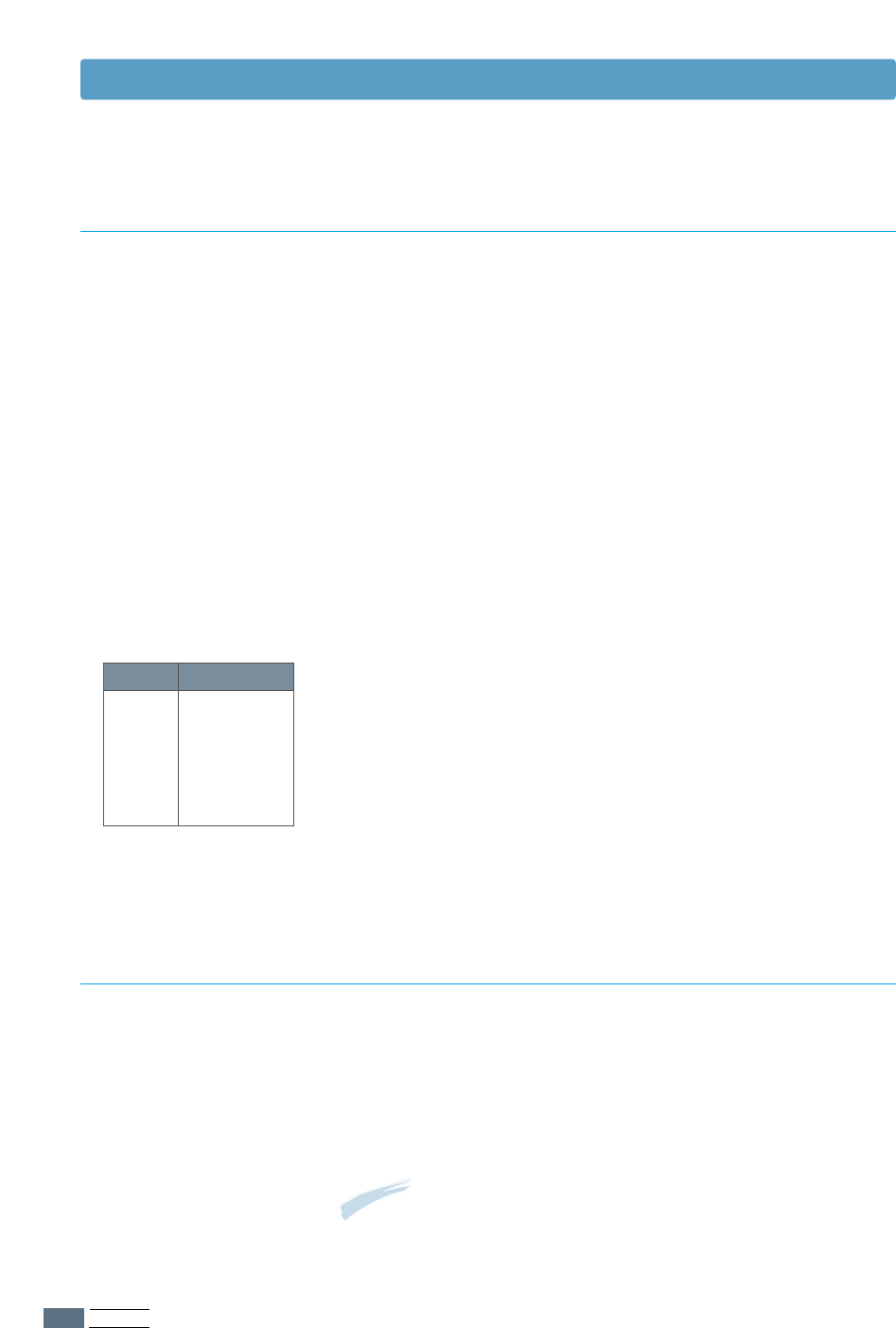
APPENDIX
A.24
Installing the Remote Control Panel for DOS Users
Selecting Print Settings
The Remote Control Panel utility is provided on the printer
software CD-ROM. If you do not have a CD-ROM drive, refer to
“Installing Software from Diskette” on page 2.13 for
information on obtaining printer software on diskettes.
To install the DOS Remote Control Panel:
1
Insert the printer software CD-ROM or RCP diskette in your
computer’s drive.
2
At the DOS prompt, make a directory that you want to use
for the DOS software and change to that directory.
3
From the floppy drive, type:
COPY x:\*.* (where xis the floppy drive designator)
From the CD-ROM drive, type:
COPY x:\1250\xxx\RCP\*.* (where xis the CD-ROM
drive designator and xxx is the designator for your
language. See the list on the left for the designator for each
language).
Then press Enter.
Code Language
DEU German
ENG English
SPN Spanish
FRN French
ITA Italian
Language Codes
When you are running DOS, you can use this Remote Control
Panel to select print settings that may not be available from
some DOS programs. Typically, duplicate print settings that are
selected from a DOS software program override print settings
selected in the ML-1250 Remote Control Panel.
Note: After you change the RCP settings, you must send it to the
printer by pressing Send on the RCP screen.
Printing from DOS Applications

APPENDIX
A.25
Printing from DOS Applications
To access the Remote Control Panel
1
Make sure that the Remote Control Panel is in your path
statement. You can check your path by typing PATH and
pressing Enter. If the Remote Control Panel directory is not
in your path, you will have to change to the default
directory C:\DOSUTIL to start the program.
2
At the DOS prompt, type DOSRCP and press Enter.
After the Remote Control Panel appears, you can activate its
selections in one of two ways:
• With the mouse – Move the mouse to position the pointer on
the desired selection, then click the left mouse button.
• With the keyboard – Press the key that corresponds to the
highlighted letter in the selection name.
The Remote Control Panel allows you to access the following
features:
PRINTING
• Paper Size sets the paper size.
• Paper Source sets the default paper source.
• Copies sets the number of copies printed for each page.
• Orientation determines how the output is printed on the
page.
• Top Margin sets the top margin of the print material.
• Left Margin sets the left margin of the print material.
• Auto CR sets how the printer performs a carriage return.
• Quality determines the print resolution.

APPENDIX
A.26
Printing from DOS Applications
CONFIG
• Power Save determines the length of time the printer waits
after a job is printed before it goes to a reduced power state.
If the printer is used frequently, select OFF which keeps the
printer ready to print with the minimum warm-up time. This
uses more electricity to keep the printer warm and ready to
print.
• Econo Mode determines the toner quantity the printer
should use when printing. If set to ON, the printer conserves
toner when printing. The default value is OFF, which
provides 100% usage.
• Auto Continue determines what action the printer should
take when a manual feed print job is sent to the printer and
there is no paper in the Manual input tray. If set to ON, the
printer will pick up the paper from the Automatic input tray
after fifteen seconds. Otherwise, the printer will wait for you
to load paper in the Manual Tray.
• Jam Recovery determines what action the printer should
take when a paper jam occurs. When set to OFF, the printer
does not reprint a page that has jammed. When set to ON,
the printer keeps the image in memory for a printed page
until the printer signals that the page has successfully
printed. The printer reprints all jammed pages.
• Altitude With this option checked, you can optimize the print
quality for a low pressure area, such as a high ground.
JOB
• Timeout determines the amount of time (in seconds) the
printer will wait before printing the last page of a print job
that does not end with a command to print the page or a
formfeed character. Valid range is 0 to 300 seconds.
• Paper Type provides the printer with information about the
type of paper to be used for a print job. For the best result,
set this to the paper type you loaded in the paper tray in the
printer. When using the plain paper, set this to Default.
• SRT Mode makes the printer optimize the print quality to
1200 dpi class image quality.

APPENDIX
A.27
Printing from DOS Applications
TEST
Demonstration Page prints the demonstration page. It shows
features, the specifications, a list of the user default settings
and the amount of printer memory available for printing.
PCL 5e
• Typeface allows you to select the desired typeface. This
setting is ignored when the software application specifies a
font.
• Symbol Set determines the symbol set. A symbol set is a
set of alphabetic and numeric characters, punctuation, and
special symbols used when printing with a selected font.
• Pitch sets the font pitch (only if you have selected a scalable
monospaced font). Pitch refers to the number of fixed-space
characters in a horizontal inch of type.
• Lines Per Page sets the number of lines that print on each
page. The setting can range from 5 to 128 lines per page.
• Point Size sets the font point size (only if you have selected
a scalable typographic font). Point size refers to the height of
the characters in the font. One point equals approximately
1/72 of an inch. You can select point sizes from 4.0 to
999.75 in increments of 0.25 points.
• Courier determines the courier font type: Regular or Dark.

APPENDIX
A.28
This Linux driver is designed for Samsung ML-1250 printer
and supports Linux Red Hat 6.0 or higher and Intel Linux. If
your Linux version is not included, this driver might not
work properly.
■Install Setup Script file configuration
a. /cdrom/linux/install/install.sh
b. /cdrom/linux/install/ssprt.db
c. /cdrom/linux/install/readme.txt
To install the driver, open the x terminal screen and take the
following steps:
Installation
To mount the CD-ROM drive:
1
Insert the Samsung ML-1250 CD-ROM into the CD-ROM
drive.
2
Mount the CD-ROM drive under a directory like /mnt in
order to access the files on the CD-ROM:
>mount -t iso9660 /dev/cdrom /mnt/cdrom
Note: To mount the CD-ROM drive, you must be a super user
or must be authorized to mount the CD-ROM by the super
user. If you fail to mount the CD-ROM drive, ask the system
administrator.
1. Mount the CD-ROM
drive.
Linux Driver Installation

APPENDIX
A.29
2. Install setup script.
For details on installing the setup script, refer to the
/cdrom/linux/readme.txt file.
Add the driver to the printer list by typing in:
/cdrom/linux>install.sh (or)
/cdrom/linux>./install.sh (if the path of the current
working directory is not determined.)
3. Set up the printer filter.
To set up:
1
Run printtool at x terminal.
2
To add the printer driver, click the Add button.
3
In the Add a Printer Entry window, decide the printer
type you will use. Select Local Printer if you have a PC-
connected printer.
4
Click the OK button.
5
If the Info button appears, ignore it, then click the OK
button.
6
The Edit xxxx Entry window opens (where xxxx is the
printer type you have selected at step 3).
If you are not an advanced user, do not change the
Names/Spool Directory/File Limit in Kb/Printer
Device option.
7
Click the Select button in the Input Filter to access
filter setup.
8
Select Samsung Printer PCL 5e Compatible for the
Printer Type item. Then select the default resolution and
paper size.
9
To save the setting, press the OK button.
10
In the Edit xxxx Entry window, press the OK button to
complete the printer driver installation.
11
You can find that the printer driver is added to the
driver window. Select Quit from the PrintTool menu.
Linux Driver Installation

APPENDIX
A.30
Installing Optional Memory Card
Your printer is a full-featured laser printer that has been
optimized to meet most of your printing needs. Recognizing
that each user may have different requirements, however,
Samsung makes the optional memory card available to
enhance the printer’s capabilities.
DISCONNECT THE POWER CORD:
Never remove the printer control board while the printer is
plugged in.
To avoid the possibility of electrical shock, always disconnect
the power cord when installing or removing ANY internal or
external printer option.
DISCHARGE STATIC ELECTRICITY:
The control board and the Memory SIMM are sensitive to static
electricity. Before installing or removing an internal option,
discharge static electricity from your body by touching
something metal, such as the metal back plate on any device
plugged into a grounded power source. If you walk round
before finishing the installation, discharge any static electricity
once again.
Additional printer memory is provided on SIMMs (single in-line
memory modules).
Note: ML-1250 has 4 MB standard of the printer memory and
you can expand the memory up to 68 MB.
Precautions
Installation
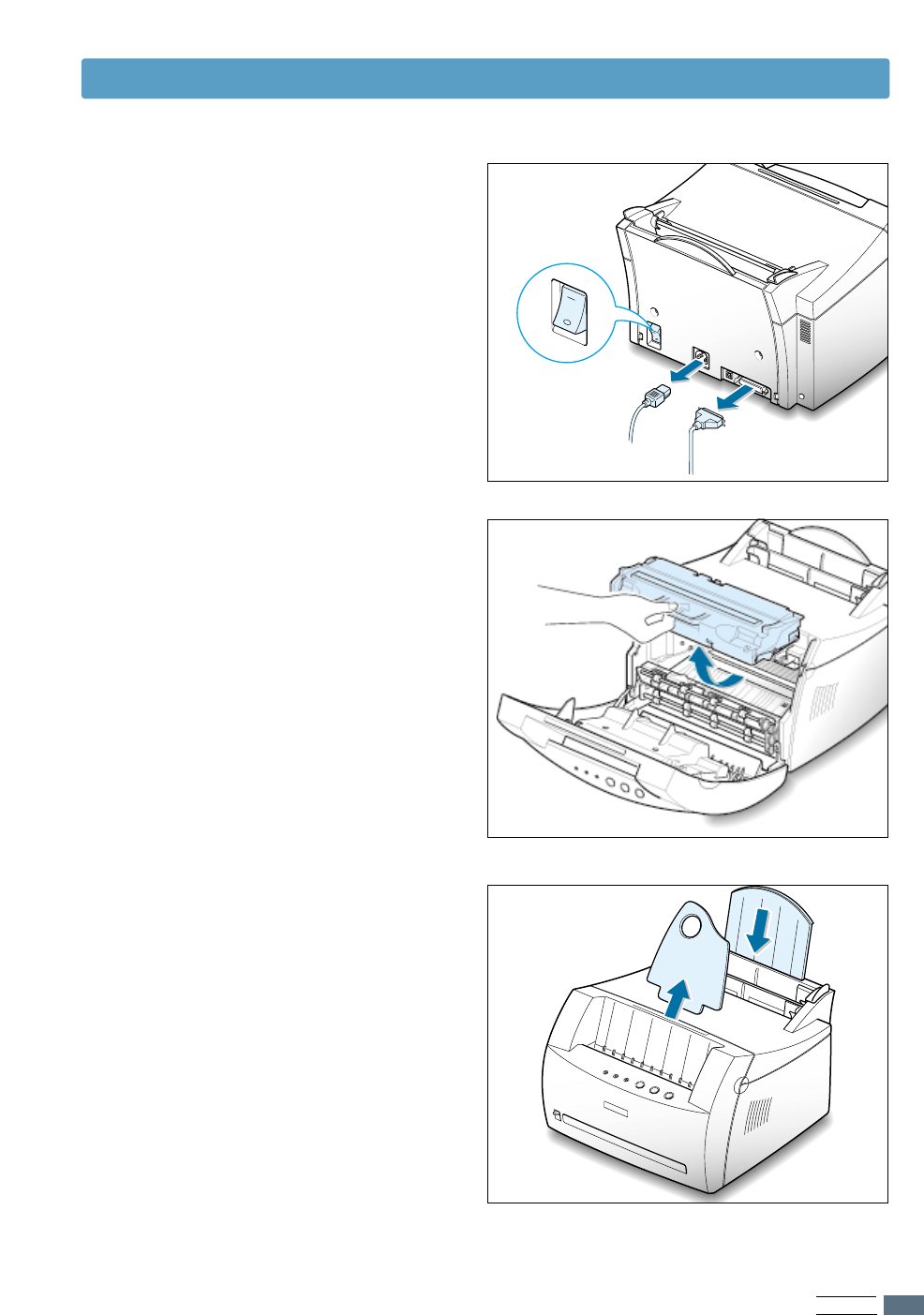
APPENDIX
A.31
Installing Optional Memory Card
1
Turn the printer power off and unplug
all cables from the printer.
2
Open the front cover and remove the
toner cartridge.
3
Remove the paper output support and
push down on the paper support until it
is recessed into the printer body.
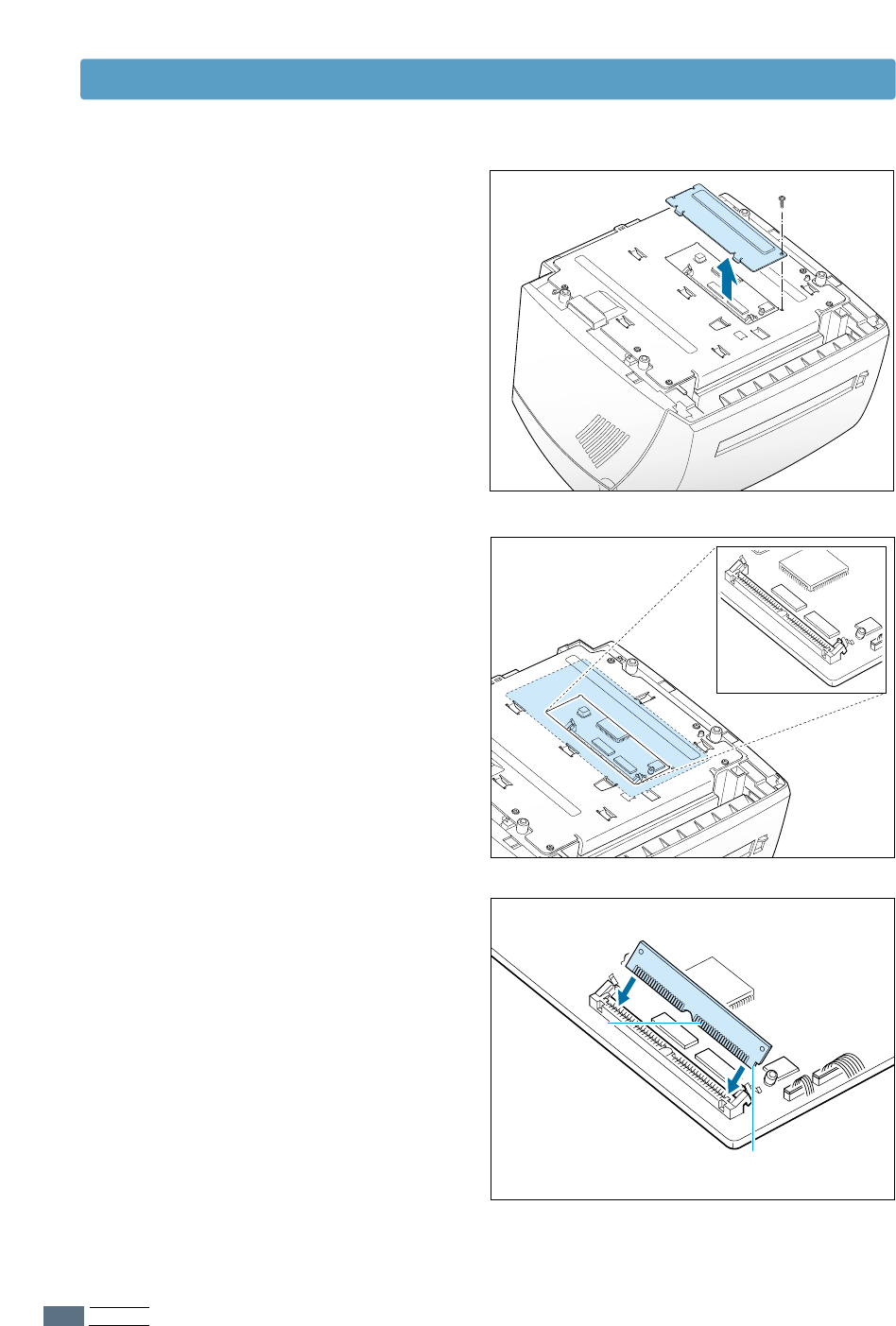
APPENDIX
A.32
Installing Optional Memory Card
4
Turn the printer upside down, and
remove one screw securing the shield
cover, then remove the cover.
5
Locate the connector on the control
board.
6
Hold the memory SIMM so that the
notch
❶
and the connection point
❷
are
aligned with the slot as shown, and
insert it all the way into the connector at
a 30 degrees angle.
❶
❷
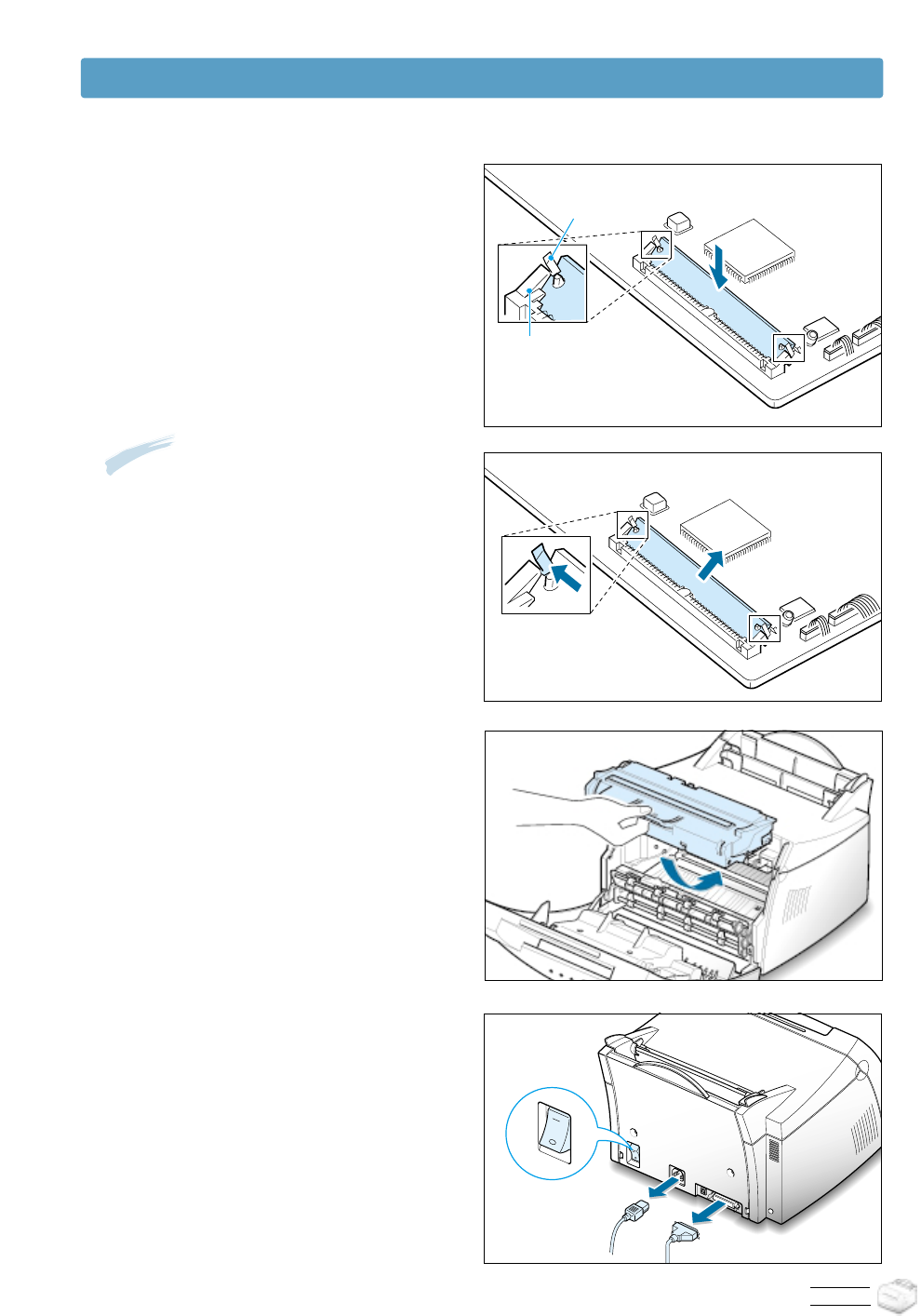
APPENDIX
Installing Optional Memory Card
7
Push the SIMM down until it snaps into
place.
Make sure that the SIMM is secured in
place by the metal clips and pins on
both sides of the connectors.
9
Reconnect the printer cable and the
power cord and turn the printer on.
Then, replace the supports.
8
Reassemble the shield cover, turn the
printer back over, and replace the toner
cartridge.
Pin
Metal clip
Note: When you disassemble the
memory card, push out on the metal
clips at each end of the connector, and
pull it as shown.
A.33

INDEX
I
INDEX
A
automatic input tray
loading paper 4.5
paper source setting 5.3
C
cancel, print job 5.5
Cancel/Reprint button 3.2
cardstock, print 4.13
clean, printer 6.4
clean sheet, print 6.5
components 1.2
control panel
buttons 3.1
lights 3.3
D
Data light 3.3
Demo button 3.1
demo page, print 2.7
diskette, install software 2.13
DOS RCP A.23
driver
access 5.1
install 2.8
Linux A.28
Macintosh A.16
remove 2.11
USB A.10
E
envelopes, print 4.7
Error light 7.17
error messages 7.17
F
face-down output tray 4.4
face-up output slot 4.4
features 1.1
fitting to a selected paper size 5.8
G
graphic mode 5.13
graphic properties 5.11
H
halftoning 5.13
I
install
Linux driver A.28
Macintosh A.16
optional memory card A.30
PCL driver 2.8
software from diskette 2.13
toner cartridge 2.2
USB driver A.10
J
jam see paper jam
L
labels, print 4.10
letterhead, print 4.12
Linux A.28
load, paper
In the automatic input tray 2.4
in the manual input tray 4.5

INDEX
II
M
Macintosh A.16
manual input tray
loading paper 4.5
paper source setting 5.3
memory card, installing A.30
multiple pages on one sheet, print 5.7
N
network, setup 5.22
n-up printing 5.7
O
orientation 5.3
output lever 4.4
output location, select 4.4
overlays, print 5.17
P
page overlays, print 5.17
paper
acceptable size and capacities 4.2, A.3
choose 4.1
guidelines 4.3, A.4
load 2.4, 4.5
specifications A.2
storage environment A.6
paper jam, clear 7.6
input area 7.7
inside the printer 7.8
output area 7.6
tips avoiding paper jams 7.10
Paper light 3.3
paper orientation, setting 5.3
paper out, indication 3.3, 7.17
paper size, setting 5.3
paper source, setting 5.3
paper type, setting 5.3
parallel, connection 2.6
posters, printing 5.9
power. turning on 2.7
print media see paper
printer light patterns 3.3, 7.17
print quality problem, solving
back of printouts dirty 7.15
background scatter 7.14
black pages 7.15
character voids 7.16
checklist 7.12
curl or wave 7.15
dropouts 7.12
gray background 7.13
horizontal stripes 7.16
light print or fade 7.11
loose toner 7.16
misformed characters 7.14
page skew 7.14
toner smear 7.13
toner specks 7.12
vertical lines 7.12
vertical repetitive defects 7.13
wrinkles or creases 7.15
printer driver see driver
printer option, memory A.30
printer software, install 2.8
INDEX

INDEX
III
INDEX
printing
cancel 5.5
cleaning sheet 6.5
demo page 2.7
fitting to a selected paper size 5.8
general problems, solving 7.2
help 5.5
last page 5.21
multi pages on one sheet 5.7
on a network environment 5.22
page overlay 5.17
posters 5.9
quality problems, solving 7.11
watermarks 5.14
problem, solving
checklist 7.1
common windows problems 7.20
error messages 7.17
general 7.2
paper jam 7.6
print quality 7.11
Q
quality, problems 7.11
R
reprint, last page 5.21
resolution 5.12
S
setup printer chapter 2
specifications
paper A.2
printer A.1
SRT mode 5.12
system error 7.18
T
toner cartridge
clean 6.5
install 2.2
life expectancy 6.1
recycle 6.1
redistribute toner 6.2
save toner 5.6
storage 6.1
Toner Save button 3.2, 5.6
transparency, print 4.11
troubleshooting see problem, solving
U
uninstall, driver 2.11
unpacking 2.1
USB cable, setup A.10
W
watermark, print 5.14
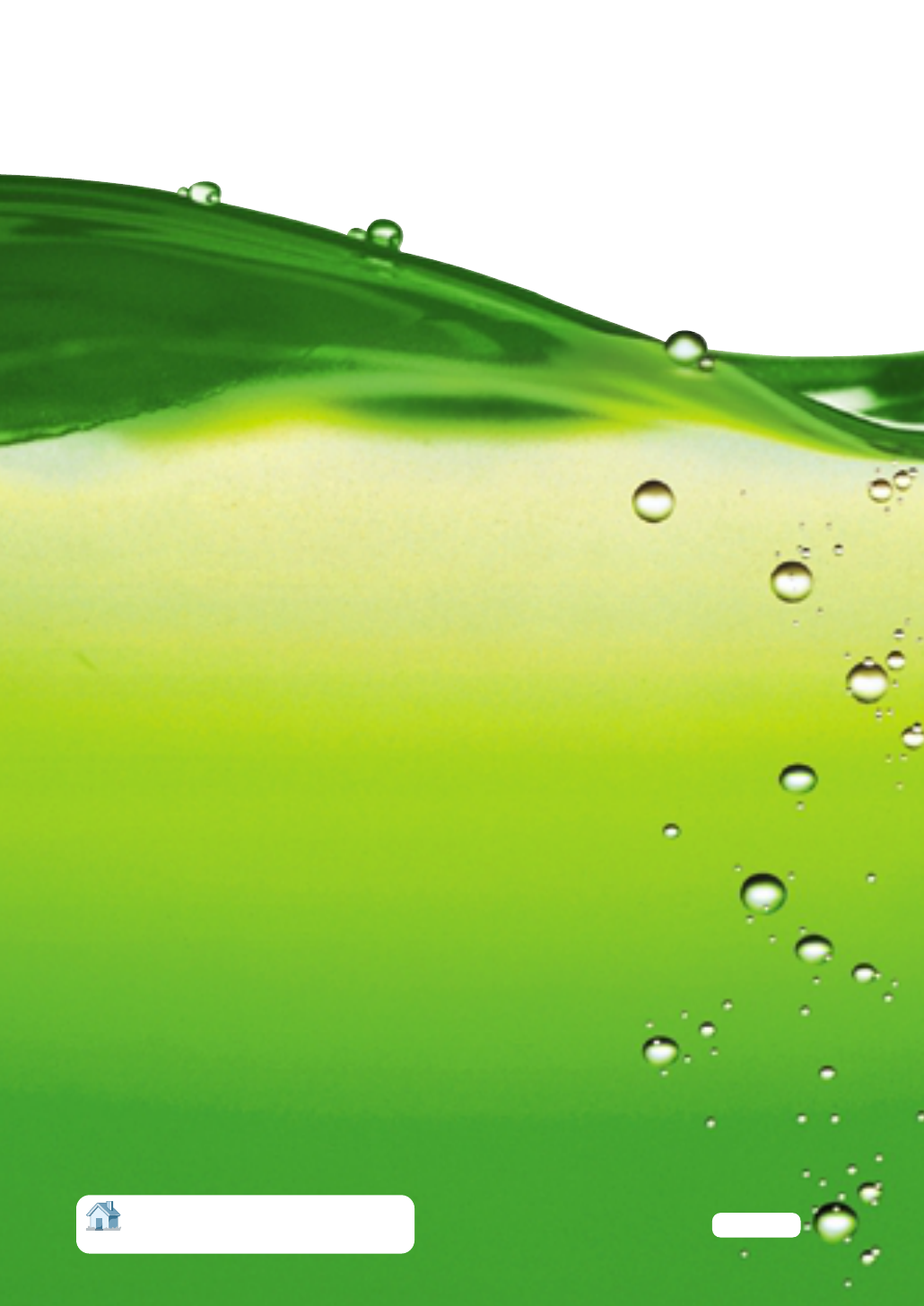
Home
Visit us at:
http://www.samsungprinter.com
Rev.1.00